

Your Memories, Their Future.
Experience longneck manor, nestled on over 100 acres in the beautiful hill country of texas..

Experience the Ultimate Luxury Safari in Africa with Rick
Limited time only! Sign up for an exclusive private African photographic safari with Rick, Founder of Longneck Manor. Rick has been to Africa over 50 times and is an accomplished tour leader and wildlife photographer. He offers this exclusive opportunity to a small group of travelers only once a year, so space is limited.
Which Experience is Right for You?
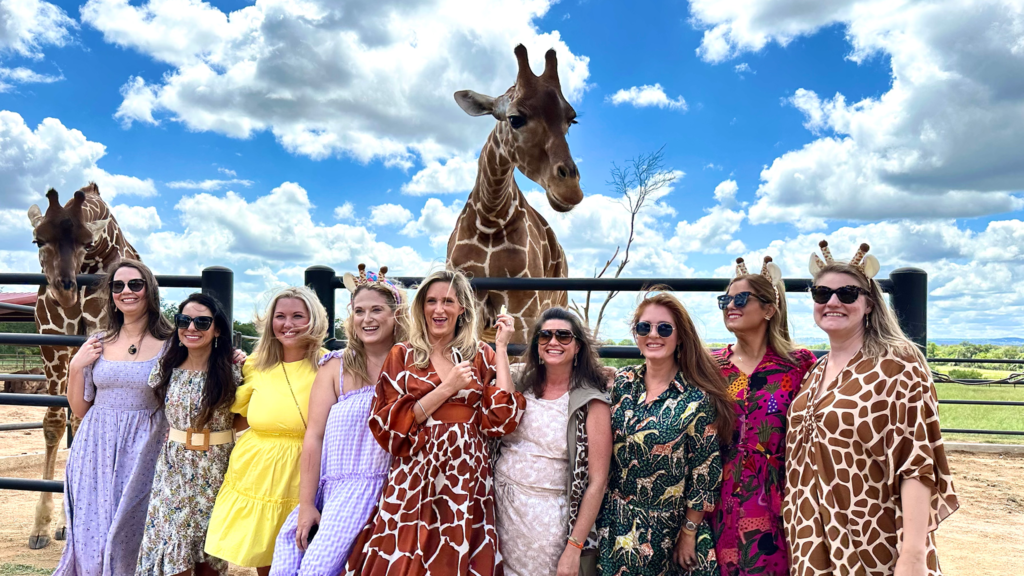
- Limited space
- Reservation required
- Kids under 2 FREE
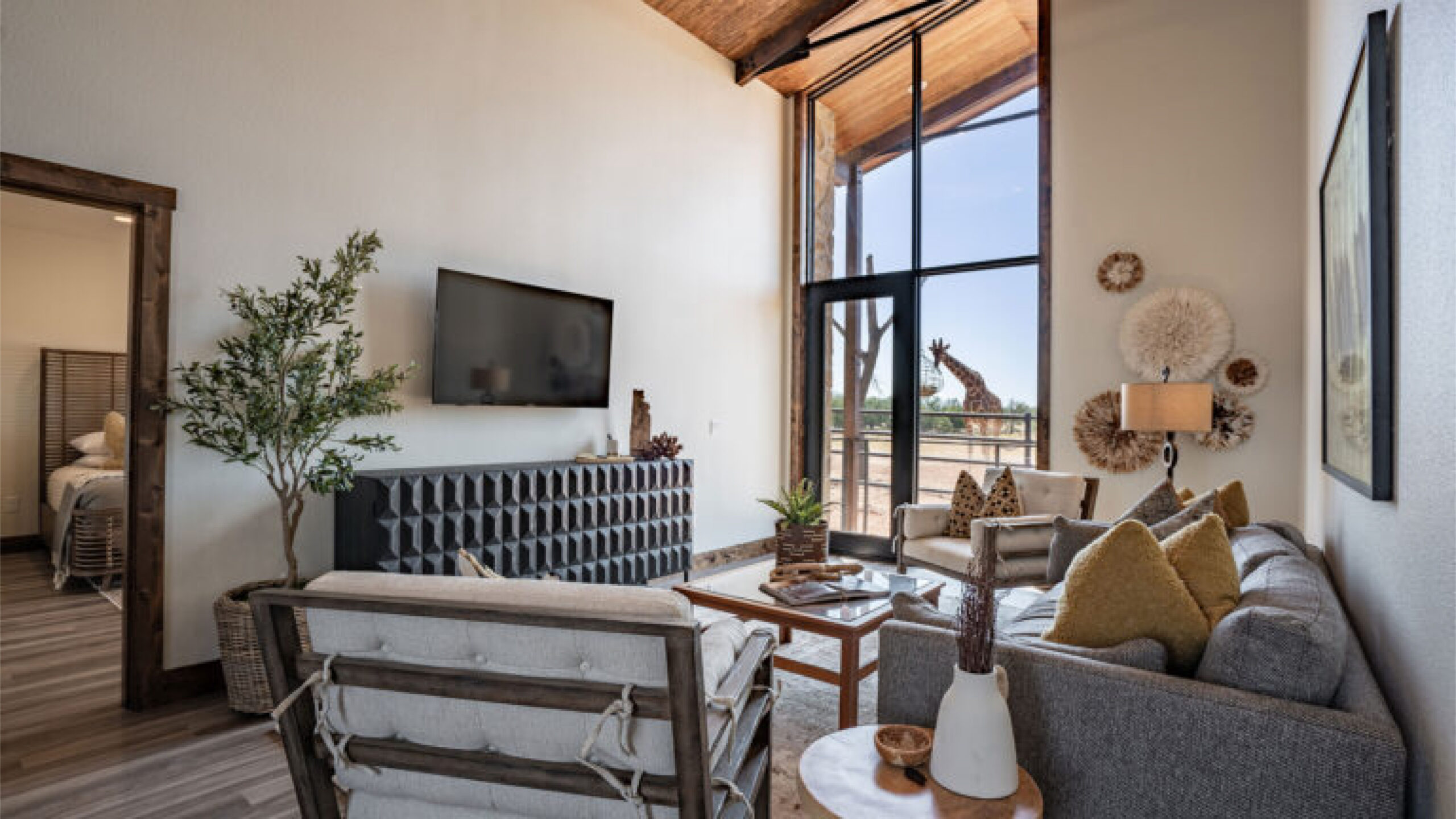
- 4 - 5 Guests
- Private Animal Encounters
- Private Viewing Decks
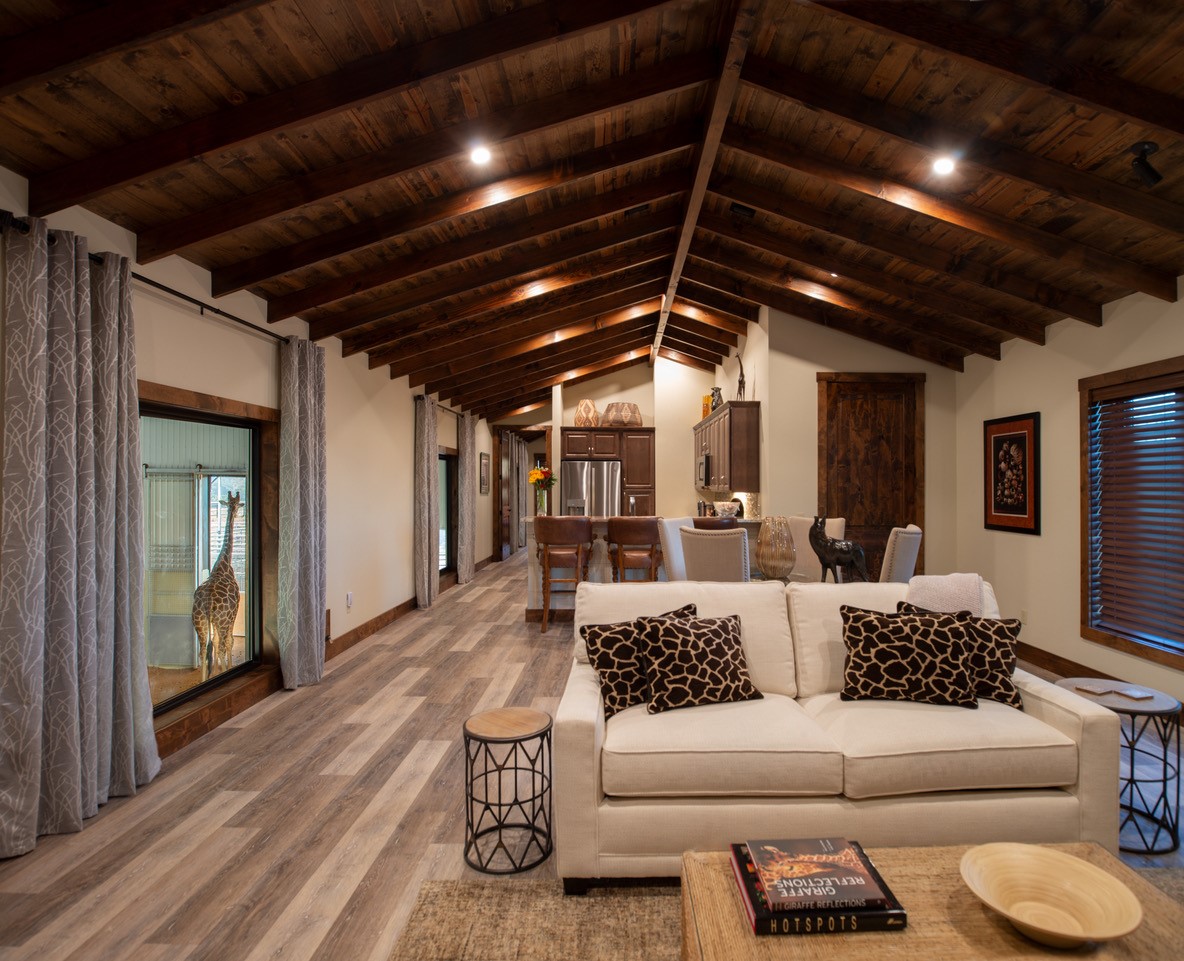
- On second level
What Guests are Saying
The animals of longneck manor.
Longneck Manor is the home to a “Crash” of three rhinos (Fred, Barney and Justin) as well as a “Tower” of four giraffes (Kafele, Betty, Tana and Kili). Our animal ambassadors help guests connect with animals in the wild and help conservation efforts with our partner organizations.

Our 2023 Amazon Wish List is here!
Our team has put together a special Amazon wish list filled with enrichment items that will bring joy and stimulation to the amazing animals here...
The Villas at Longneck Manor – now open for reservations!
We’ve got some exciting news to share with you all – our brand new accommodations, the Villas at Longneck Manor, are officially open for reservations!...
Longneck Manor Recognized as Recognized as Tripadvisor® 2023 Travelers’ Choice® Award Winner
Longneck Manor’s Great Traveler Reviews Earn it a Place Among Travelers’ Favorites Fredericksburg, Texas> – August 11, 2023 – Longneck Manor today announced it has...
Longneck Manor in the News!
This week, we were pleased to host our friends at Fox 7 Austin for a visit to our new Villas and to meet our resident...
New Rhino Waterhole Installation
New at Longneck Manor! We are adding a naturalistic African waterhole with large boulders to the four-acre giraffe and rhino pasture. It will look like...
We have BIG NEWS!
???????? We have BIG NEWS! Coming this summer, a new Welcome Center and four cottages – each with a stunning view of our giraffes and...
Hear Rick on the Tomorrow Society Podcast
Recently Longneck Manor Founder, Rick Barongi was a guest on the podcast, The Tomorrow Society! In this podcast, he shares stories from his decades long...
Climbing Kili
by Bill Konstant Our wake-up call came at 11:00 pm on October 20th. That’s right, late that night, not the next morning. Rick and I...
Our 2022 Holiday Wishlist is here!
Looking to spread a little extra holiday cheer this year? Don’t forget presents for our giraffes, rhino and sloth this year when you go holiday...
Betty White (the Giraffe) Gives Birth to anAdorable Six-Foot-Tall Girl.
After a 15 month wait, Longneck Manor is delighted to welcome the newest addition to its precious wildlife family; a female reticulated giraffe calf. Arriving...
Jane Goodall Supports Longneck Manor
I was at my desk at Disney Imagineering getting ready to return home after a long day at work when my cell phone rang. “Hello,...
Longneck Manor – How and Why
After you read some of the history and vision narratives on this website you still may be wondering how I came up with the idea...
History of Longneck Manor – A Uniquely Texas Experience
Why i like rhinos.
Rhino Fact: There are five living species of rhinos (two African and three Asian), their combined populations in the wild being about 30,000 animals. If rhinos...
My Africa – “Born Free”
Fact: I have Visited Africa Over 50 Times, but my First Trip Changed my Life Africa…. This wild and mysterious continent with its amazing creatures...
Drifter – First Ambassador
Meet my pal Drifter, a four-year-old yellow Labrador retriever. His pedigree name is Classic Hill Country Drifter but we call him the “Drift Man”...
Unless someone like you cares a whole awful lot, Nothing is going to get better, it’s not.
If you are passionate about animals (both pets and wildlife) and want to learn how to help save them in their natural habitats, then I...
Test article
Sample content here.
Don't miss this opportunity to experience the best that Africa has to offer. Join us on this exclusive safari and create memories that will last...

A nonprofit conservation park
STAY UPDATED
- © 2023 Longneck Manor, LLC.
- LONGNECK MANOR and the LONGNECK MANOR logo are trademarks and service marks of Longneck Manor, LLC.
- Longneck Manor Conservation Foundation is a registered 501(c)3 public charity.
One of Africa’s most recognisable animals, the Giraffe
With their unique and beautiful colouring, giraffes are one of Africa’s most recognised animals. As the tallest animals on the planet, standing at between 14 and 19 feet (4.2 to 5.8 metres) they’re hard to miss. They use there impressive height to browse on leaves and shoots from the very tops of trees that few others can reach – a favourite of giraffes is the acacia tree. The other adaptation that helps giraffes feed on these leaves is their 21 inch tongue – which is very rough, protecting it from thorns. Given their size, giraffes are almost continuously eating in order to consume enough food. As a result, they have cover large distances to find enough.
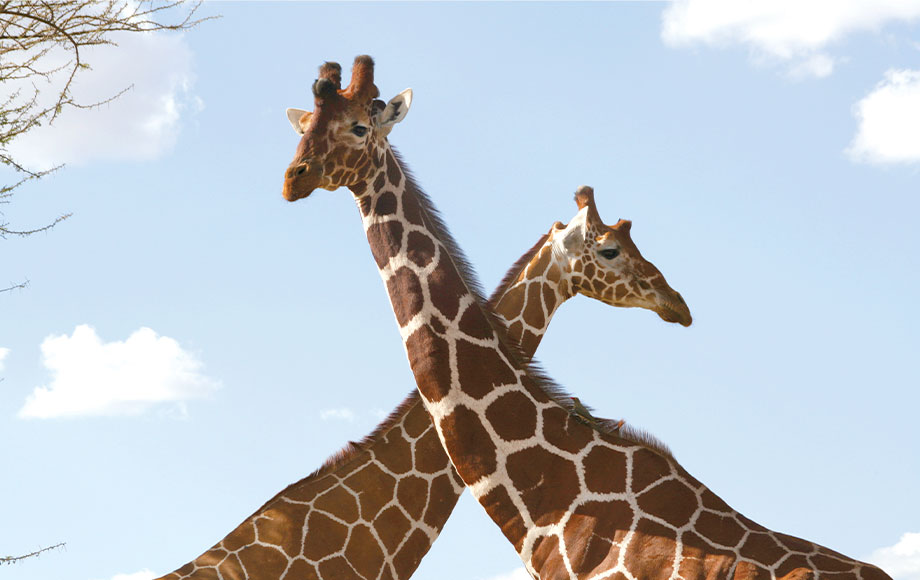
Common Name – Giraffe
Scientific Name – Giraffa camelopardalis
Current IUCN Red List Status – VU
Estimated no. of mature individuals – 68 ,000 – studies suggest a declining population.
Though there are few predators to worry about, giraffes do keep a look out for big cats – some lions have been known to specialise in hunting giraffe. This is particularly true when it comes to drinking from rivers or shallow pools. Their large hulking frames put them at a significant disadvantage and to drink at a water source, they must spread their legs awkwardly to bend down and drink – making them vulnerable to predators. To combat this need for water, giraffes absorb most of their water from plants and therefore do not need to drink from a water source every day.
Giraffe Viewing on Safari
Giraffe viewing depends on where you are in Africa – as there are 9 subspecies of giraffe. Recent research has suggested however that some of these may actually be distinct species in their own right. Physically, giraffe subspecies differ in their size and pattern. The two most common species in East Africa (Kenya and Tanzania) is the Masai giraffe and the Reticulated Giraffe. The Masai giraffe is significantly darker than other species while their patches have a distinct vine leaf shape with jagged edges. The Reticulated giraffe, found in central, north and north-eastern Kenya is recognisable by its neat and clear orange-brown patches, which are separated by clear white lines.
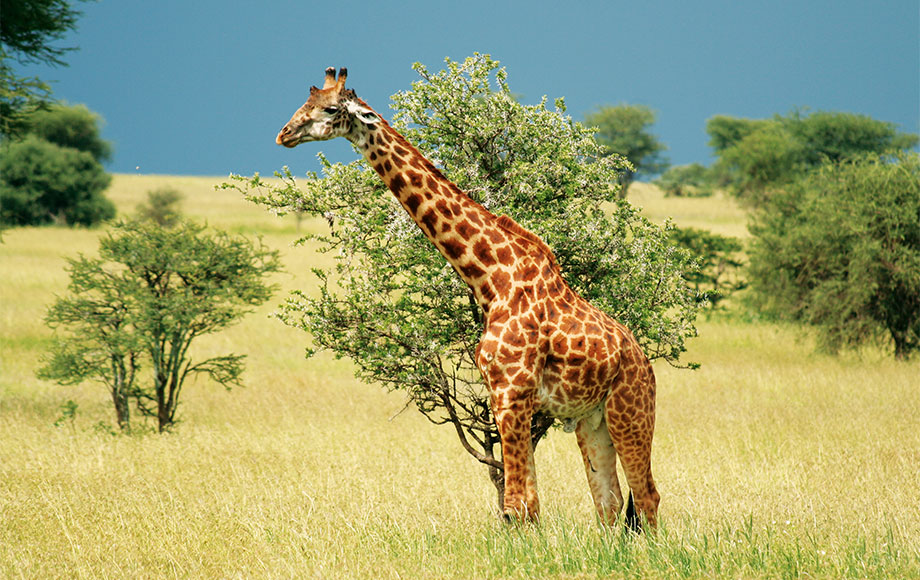
Contrary to the two species mentioned above, the South African giraffe (found throughout many southern African countries) has distinct patches in varied shapes and sizes that spread down its legs.
Non-territorial, giraffes are gregarious animals that often live in groups (called towers) ranging from 5 or 6 up to 20 individuals – if you spot one giraffe you are likely to spot a few more nearby. They can be found in many national parks and reserves throughout Africa in varying numbers. Renowned Giraffe Manor holds the unofficial title of the most “unforgettable bucket-list breakfast experience in the world” for good reason. The property is a sanctuary for the highly endangered Rothschild giraffe who join guests for a memorable breakfast, poking their heads through the windows in search of a snack.
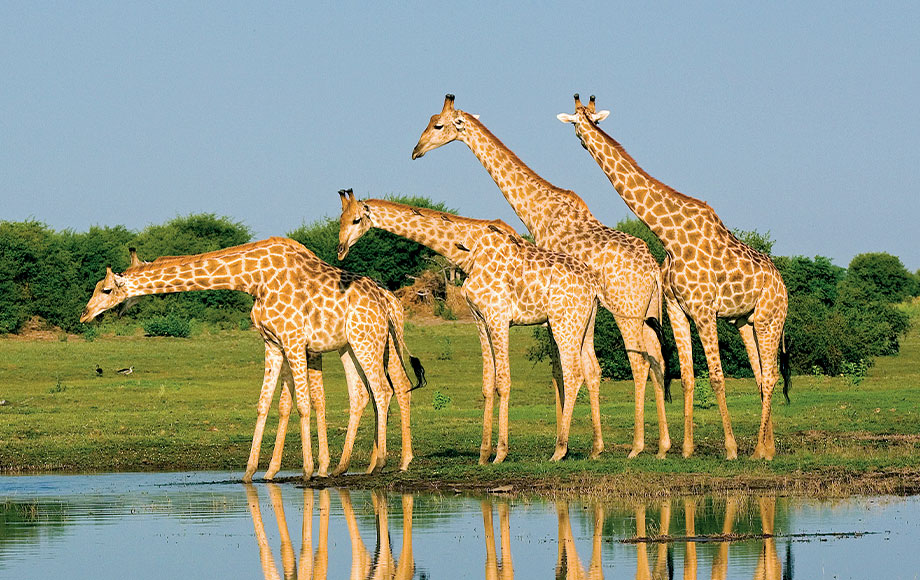
Best safaris to see giraffes
Ker & downey botswana.
Experience this authentic 7 day Okavango Delta safari with Ker & Downey Botswana, one of the country's most respected operators.
Desert & Delta Safari Botswana
Discover epic wildlife in the Okavango Delta, Moremi Game Reserve and Savute with Desert & Delta Safaris, one of Botswana's most respected operators.
Highlights of Kenya
Discover the Highlights of Kenya on this classic safari itinerary, taking in the Samburu National Reserve, Mt Kenya, Lake Nakuru and the renowned Masai Mara.
Best of Kenya and Tanzania
This safari combines the best wildlife experiences of Kenya and Tanzania, including the Samburu, Lake Nakuru, the Masai Mara and Serengeti.
Kruger and The Cape
Discover some of South Africa's best known attractions on this journey that begins with a big game safari in the world-renowned Sabi Sand and concludes in beautiful Cape Town.
Best places to see giraffe
Ultra-luxurious, Moroccan-themed Sasaab is a stylish oasis in the heart of Kenya’s desert-like northern wilderness, lying just west of the breathtaking Samburu National Reserve.
Giraffe Manor
This boutique hotel is a Nairobi icon and offers one of the city’s most unique experiences: the opportunity to feed and walk with rare Rothschild's giraffe.
Selinda Camp
Selinda Camp is located in the breathtakingly unspoilt Selinda Reserve, home to some of Africa’s largest herds of elephant and buffalo, as well as rare African wild dog.
Lemala Mpingo Ridge
Sitting at the top of an escarpment with sweeping views across the perennial Tarangire River and valley below, Lemala Mpingo Ridge offers not just sensational views but outstanding standards of
Mara Plains Camp
In the heart of big game country, ultra-luxurious Mara Plains Camp sits on a bend of the Ntiakitiak River on the northern border of Kenya's Masai Mara.
Elephant Bedroom
Shaded by doum palms on the banks of the Uaso Nyiro River, upscale Elephant Bedroom Camp occupies a prime position in the stunning Samburu National Reserve.
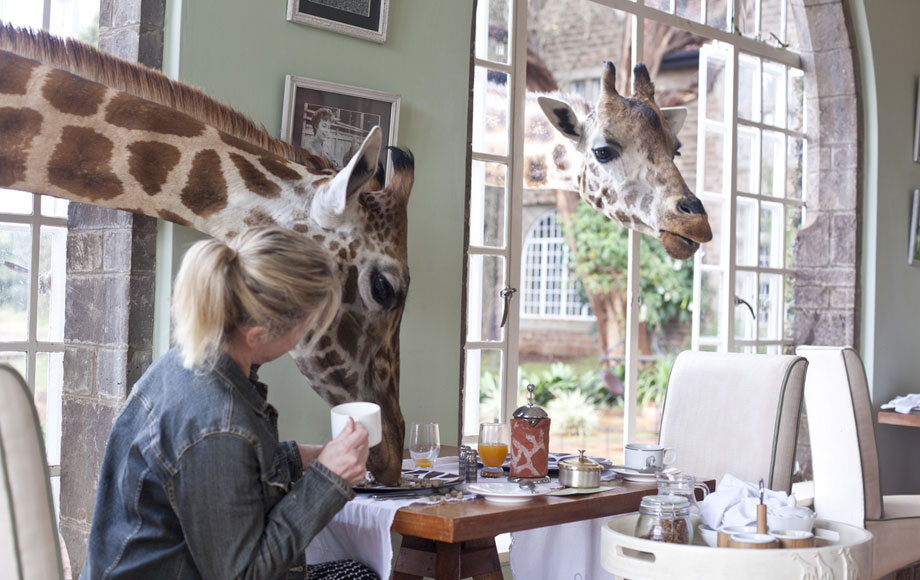
Where is Giraffe Manor?
Giraffe Manor is one of the most sought-after hotel stays in Africa. It is an exclusive boutique hotel located in the suburbs of the Kenyan capital of Nairobi. Built in 1932 as a colonial hunting lodge, today Giraffe Manor is a Nairobi icon and offers one of the city’s most special experiences. What sets Giraffe Manor truly apart is its herd of endangered Rothschild’s giraffe, who are known to join guests for breakfast or for a cheeky snack through open windows or doors. Giraffe Manor is a fantastic addition at the beginning or end of any Kenyan safari.
Unique Adaptations
Fighting Gravity and adjusting pressure Giraffes have a number of unique adaptations in their circulatory system to fight against gravity in order to pump blood. Elastic and muscular arteries above the heart pump blood up the neck –fighting against gravity. The arteries below are the opposite – narrower with thick walls – that can bear high pressure, preventing blood from pooling. Giraffes have a complex network of elastic vessels that expand when they lower their heads, this prevents blood from flooding the brain.
Super Heart Relative to its size, the giraffe has quite a small heart – weighing just 11 kilograms. Giraffes have extremely high blood pressure (twice that of a humans) as they need to maintain blood flow against gravity. Looking more closely, the left ventricle of the heart has thick muscular walls in order to pump blood up to the head and then around the body. In comparison, the right ventricle is thinner and only pumps blood to the lungs. Their heart beats up to 170 times a minute.
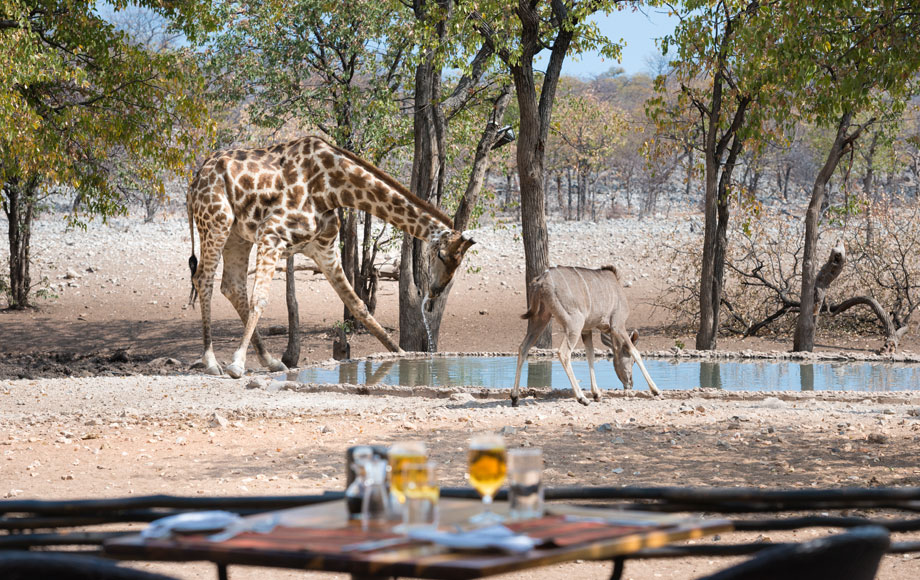
Giraffe Facts:
Tallest Animal Giraffes are the tallest mammals on Earth, standing at between 14 and 19 feet (4.2 to 5.8 metres) they’re hard to miss!
Standing sleepers Adult giraffes require less sleep than other mammals. There is some debate as to the exact amount, but research has suggested it is somewhere between 1 to 3 hours in a 24 hour period. Most of this sleep however is taken in short naps while they stand. They will arch their necks around and rest their heads on their rear end.
Surprisingly speedy Ungainly in appearance and particularly when in motion, giraffes don’t appear at first glance to be the fastest runners. However, their long legs do along them to reach a top speed of 35mph (56 kph), but only for a short time.
Horns? What horns? A giraffes “horns” are actually knobs that are covered with skin and hair. These knobs protect their head and eyes from injury.
Find out more about our tailor made African safaris. Get in touch with one of our Destination Specialists.
Subscribe below to keep up to date, find out more about our tailor made african safaris, more wildlife.
The Cape buffalo is a member of Africa’s “Big 5” and therefore a must-see for any safari-goer.
Cape Buffalo
The Cheetah is the fastest land animal on the planet and one of Africa’s most well-known and sought-after sightings when on safari
African elephants are the world’s largest land mammal and were once numerous, roaming across the whole African continent.
With their unique and beautiful colouring, giraffes are one of Africa’s most recognised animals.
Grizzly bear or grizzly is the name given to the subspecies of brown bear that inhabits North America.
Grizzly Bear
The largest cat in the Western Hemisphere, jaguars are strongly built, well-muscled predators native to the Americas
King Penguins don’t actually live on the Antarctic ice shelf, instead they prefer the sandy snowless beaches of the Sub-Antarctic islands.
King Penguin
Lemurs are endemic to the island nation of Madagascar where 107 species can be found. However each individual species is often only found in a
Leopards are graceful cats and still geographically wide-spread across Africa, including isolated parts of Morocco and Egypt.
A member of the “Big 5” and perhaps Africa’s most iconic species, the African Lion is a highly sought after sighting while out on safari.
Meerkats are found in Southern Africa and they are often seen standing on their rear legs, forever gazing out over the sweeping plains.
Orcas, informally referred to as killer whales because of their fearsome reputation, are majestic mammals.
Polar bears are found in the Arctic regions of Canada & Europe. The majority of their population are found in Canada, particularly around the
Impressively large and with horns for a nose, these prehistoric looking creatures are one of the most iconic African animals.
E-Newsletter
Sign up to receive updates about exciting journeys, special offers and more
All you need to know about African elephants – and where to spot them in the wild
Apr 25, 2024 • 7 min read
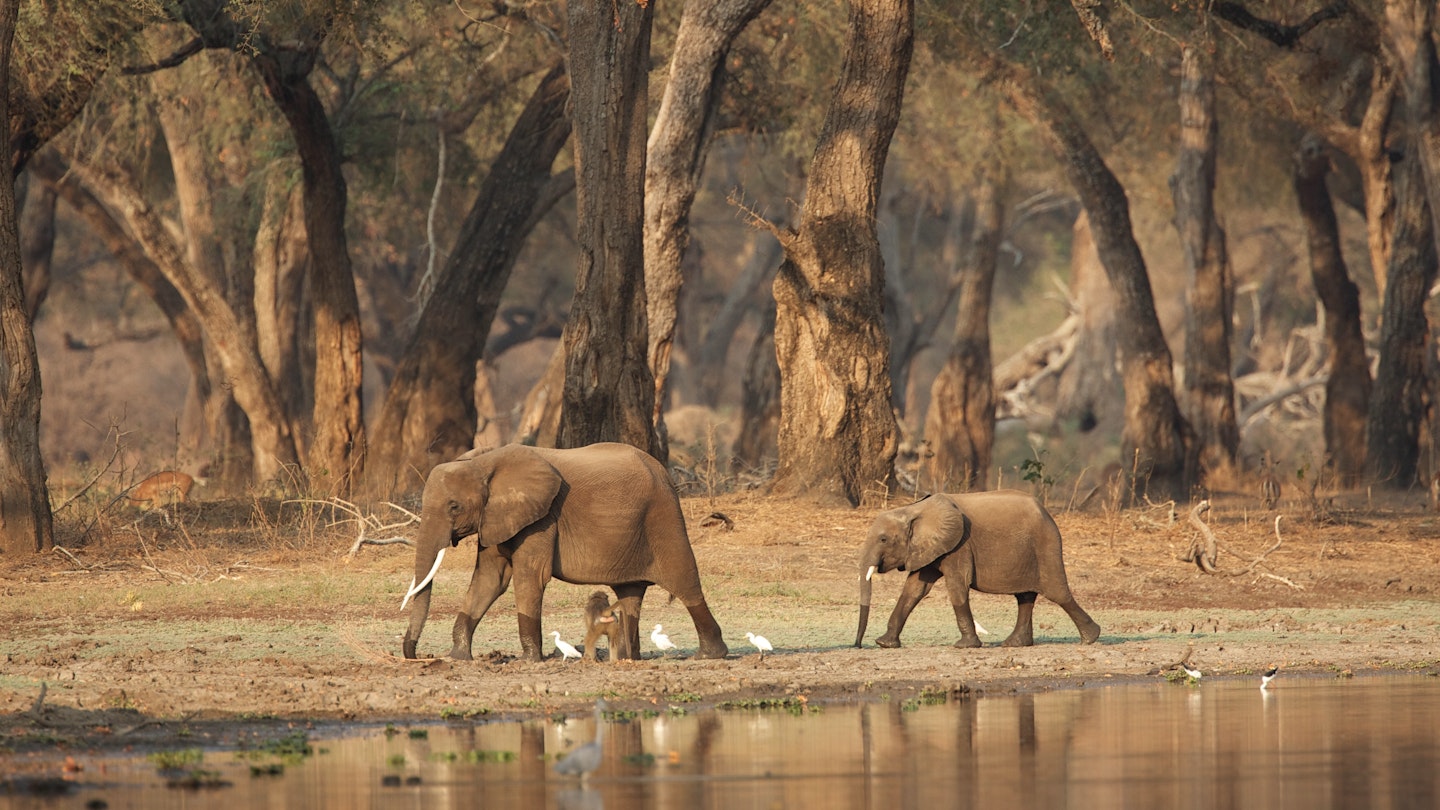
Spotting majestic African elephants in the wild is something you’ll never forget © David Fettes / Getty Images
The African elephant is perhaps the most enduring symbol of nature’s grace and fragility.
These gentle giants are Earth’s largest land mammal and a common sight for those on safari in Africa . Nonetheless, these magnificent beasts are facing unprecedented threats to their existence, making both the imperative to understand more about them and the chance to encounter them in the wild more important than ever.
Let us help you do both.

African elephants 101
An adult African elephant is large. Seriously large: a fully grown male can weigh in at 13,334lb (6048kg), and even the smallest adult male rarely dips below 8820lb (4000kg) – which is two-and-a-half times heavier than your average family car. Females are typically just over half the weight of the male. The size difference narrows when it comes to height: the tallest males are 13ft (4m), with the tallest female rising to 11ft (3.4m). Apart from overall size (and unless the male is, um, aroused), the most obvious difference between males and females is that cows have angular foreheads, with bulls’ foreheads being more rounded.
Apart from humankind, elephants have few natural enemies. In some areas, such as Hwange National Park in Zimbabwe or in the Savuti region of northern Botswana , certain lion prides have learned to hunt infant and adolescent elephants. Thankfully, this isn’t the norm.
Safari animals: the story of lions (and the best places to see them)
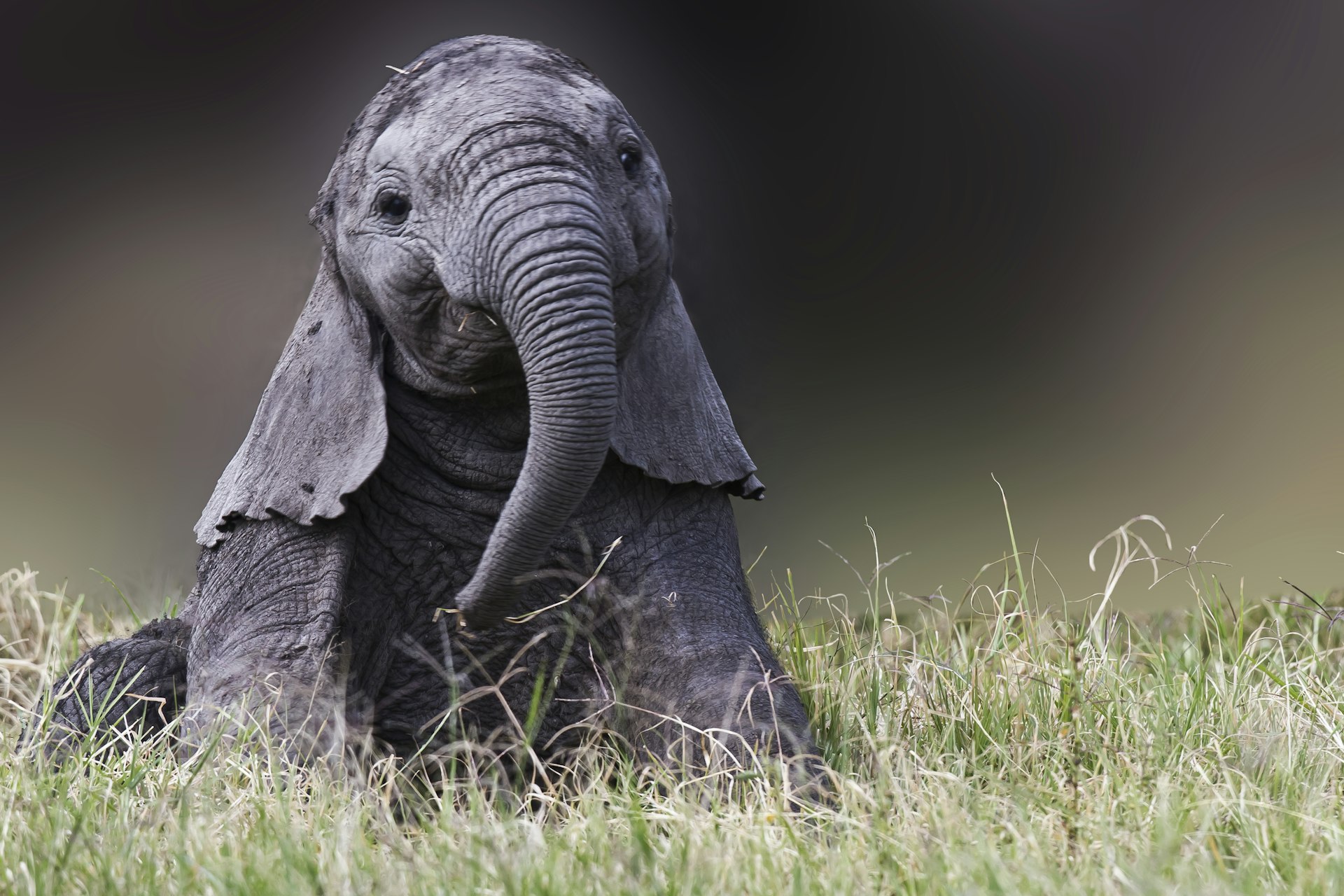
The elephant sisterhood
Elephants live in close, cross-generational groups of females. An elephant mother has one of the longest pregnancy periods – some 650 days – in the natural world. Most often, the mother gives birth to a single calf, and that calf will be able to walk (albeit unsteadily) within hours of being born. Baby elephants continue to breastfeed throughout the first two years of their lives, and many will not be truly independent until the age of 10.
If the young elephant is a male, he will leave the herd of its birth somewhere between 10 and 14 years of age. Sometimes this dispersing male will remain alone or attach itself to an experienced larger bull elephant. Young female elephants remain with their natal herd, which may consist of their mother, grandmother, aunts, female cousins and other related females. (What’s not to love?)
This bond with fellow females will endure will last throughout her lifetime. The herd is usually led by an older matriarch, an experienced female that takes the herd to water in times of drought and is the first to stand in defense of the herd’s members.
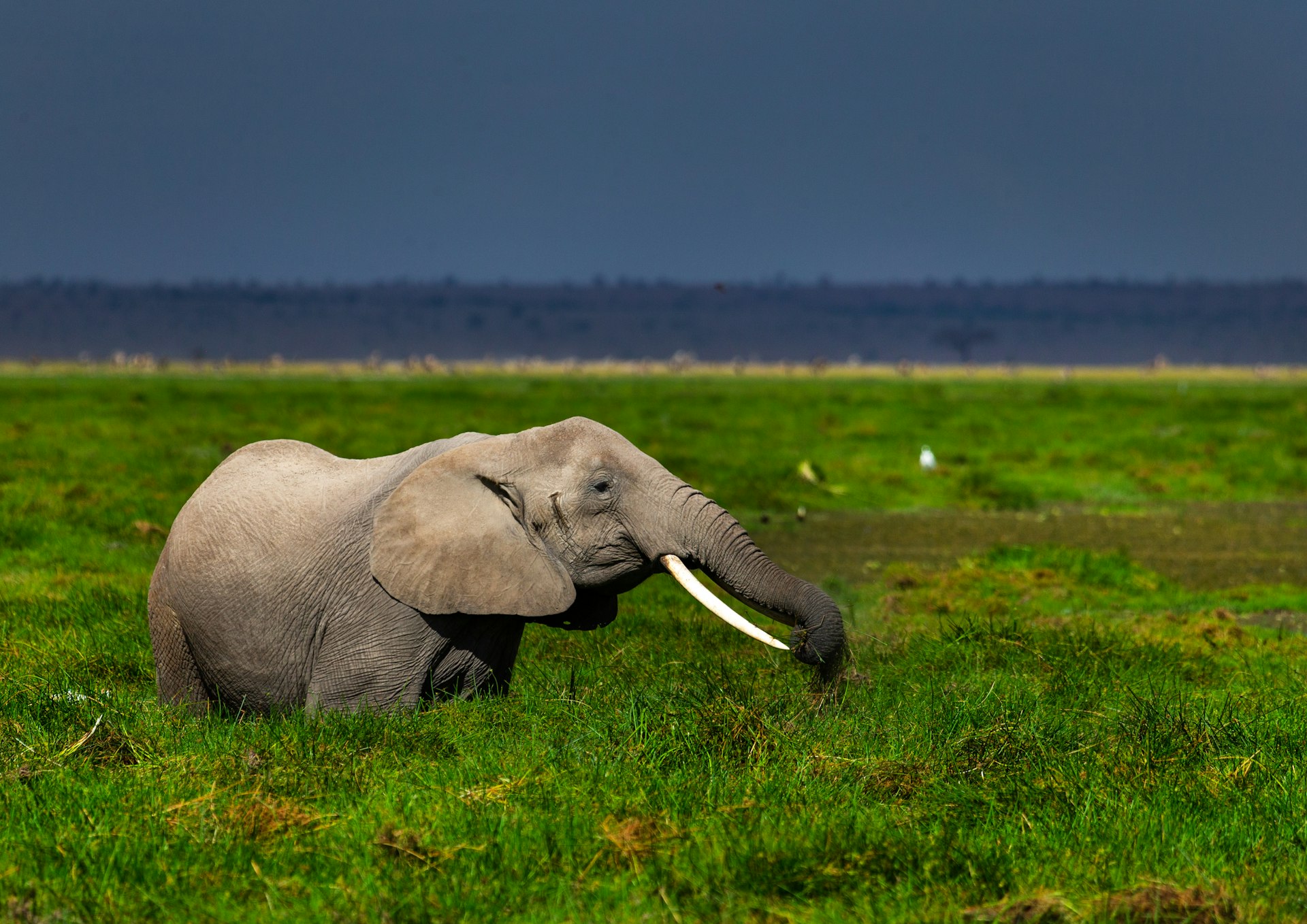
The most voracious vegetarians
Strict vegetarians, elephants eat grass, leaves, fruits and even branches or twigs. In any 24-hour period, elephants will spend up to 19 hours eating and can eat up to 750lb (340kg) – or around 5% of their not-inconsiderable body weight. If you extrapolate those figures further, elephants consume around 50 tons of food every year. At the other end, elephants defecate up to 30 times a day, depositing as much as 330lb (150kg) of dung in the process. This waste serves a critical ecological purpose, spreading undigested seeds (a food source for insects, baboons and birds), in turn enabling trees to spread their progeny. One study found that a single piece of elephant dung contained nearly 5700 acacia seeds.
Elephants drink between 26 to 52 gallons of water per day. And for good reason: an elephant loses as much as a gallon of moisture every hour through the process of transepidermal (through the skin) water loss, and urinates up to 13 gallons each day.
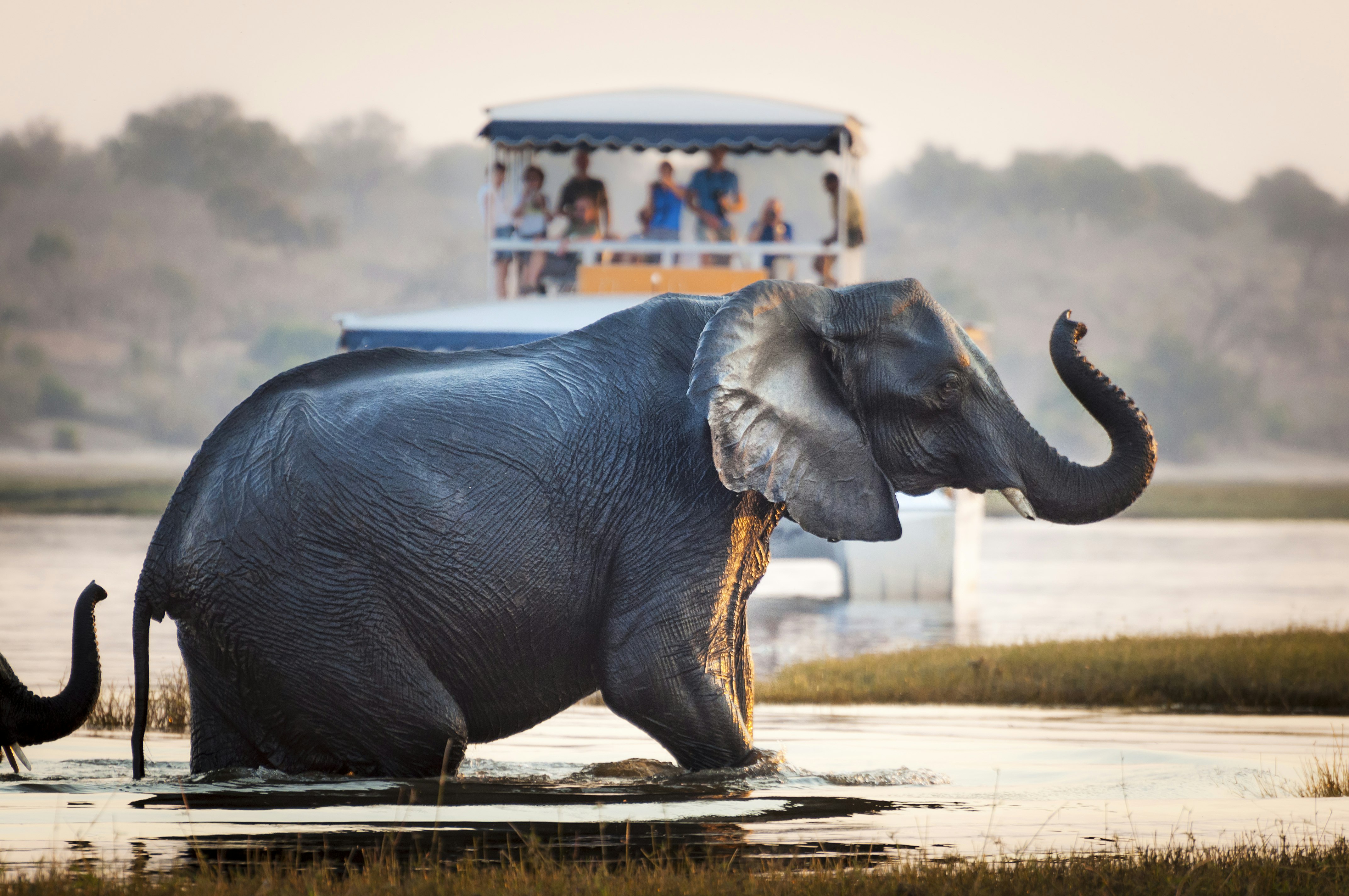
A country-by-country guide to seeing elephants on safari
Of the two species of African elephant, the much larger bush elephant is most commonly found in the savanna and light woodlands of East Africa and Southern Africa , with smaller populations in West Africa . The forest elephant, meanwhile, is predominantly found in the forests of Central Africa, although they can range into East and West Africa, too.
The 2016 Great Elephant Census – the most comprehensive survey of elephants ever undertaken – counted 352,271 African bush (or savanna) elephants spread across 18 countries.
Elephants in Botswana
Botswana counts more elephants than any other country: over 130,000 as of 2016. Anywhere in the Okavango Delta can be outstanding for elephant lovers, but Chobe National Park truly stands out, with its populations of elephants in big herds.
Elephants in Kenya
Kenya has some of the best elephant watching on the continent. We recommend the spotting at Amboseli National Park ; the Masai Mara , Tsavo East and Tsavo West national parks, as well as the Samburu National Reserve , are excellent as well.
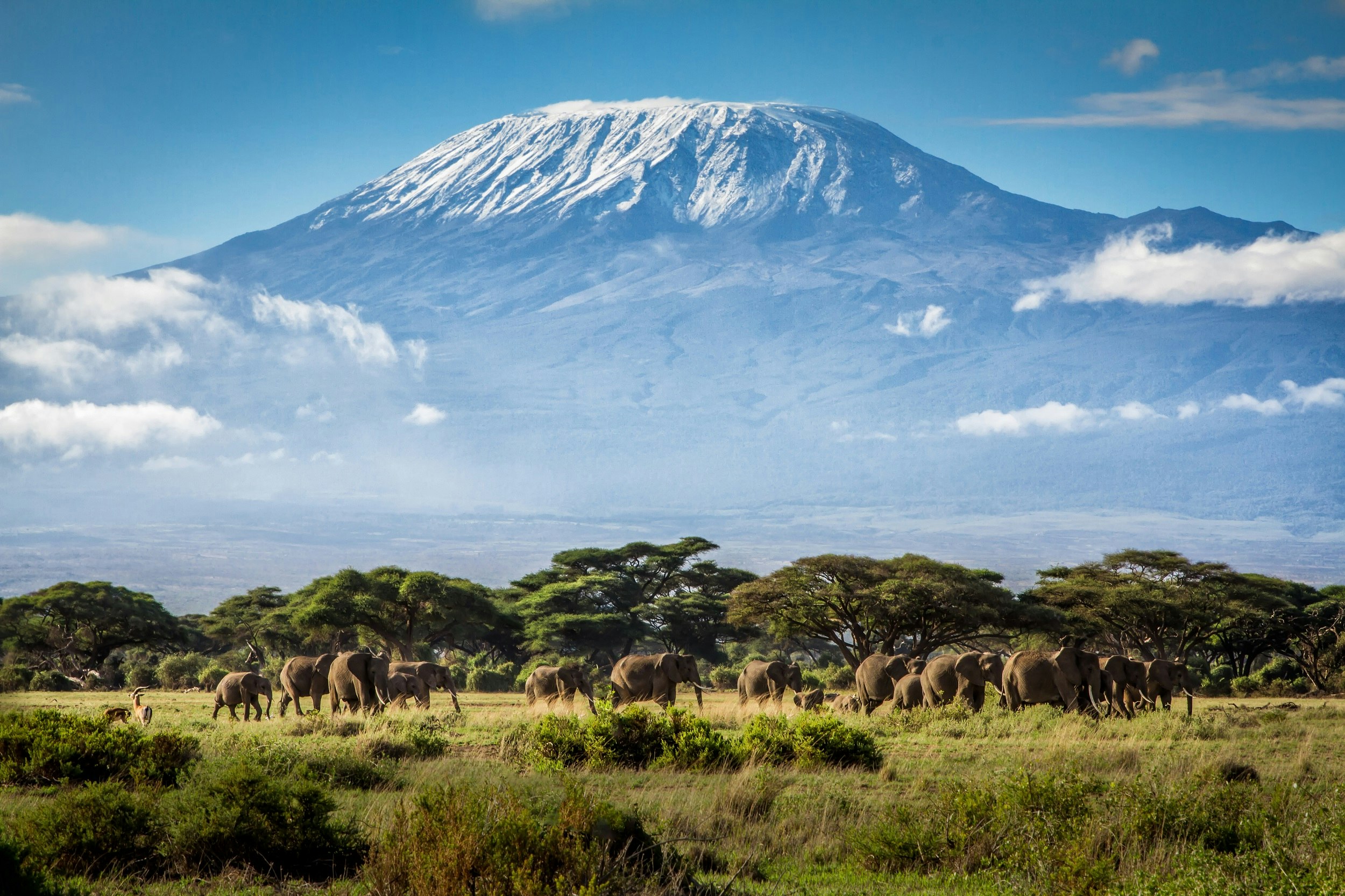
Elephants in South Africa
A justly popular destination for visitors, Kruger National Park is prime elephant-watching choice. Addo Elephant National Park is South Africa ’s third-largest national park and offers some of the world’s best elephant viewing.
The 15 best things to do in South Africa
Elephants in Namibia
Etosha National Park is your best bet. Seeing the desert-adapted elephants of Damaraland , also in the country’s north, is another highlight.
Elephants in Tanzania
While Tanzania ’s elephant population is declining, sightings remain generally excellent in the Serengeti , Lake Manyara , Tarangire and Ruaha national parks.
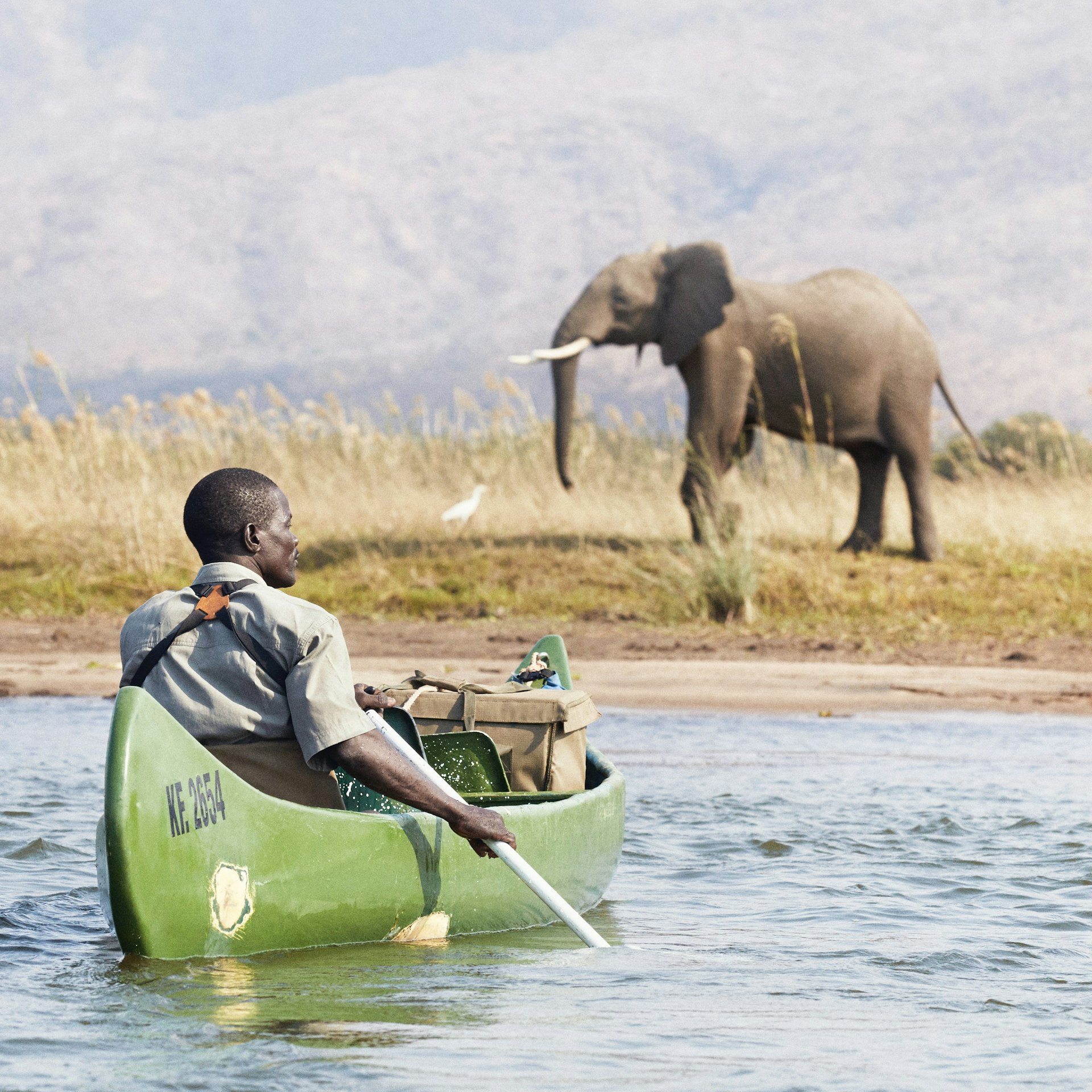
Elephants in Zambia
South Luangwa National Park offer the best elephant spotting in Zambia .
Elephants in Zimbabwe
As of 2016, Zimbabwe had more than 80,000 elephants, second only to Botswana. Try Hwange and Mana Pools national parks: the former is home to half of Zimbabwe’s elephants.
Elephants in Malawi
Malawi ’s Nkhotakota Wildlife Reserve is a lovely park, especially since the recent and historic translocation of 500 elephants to its borders.
The best times to visit Malawi
Elephants in Mozambique
In Mozambique , Gorongosa National Park is brilliant for elephants.
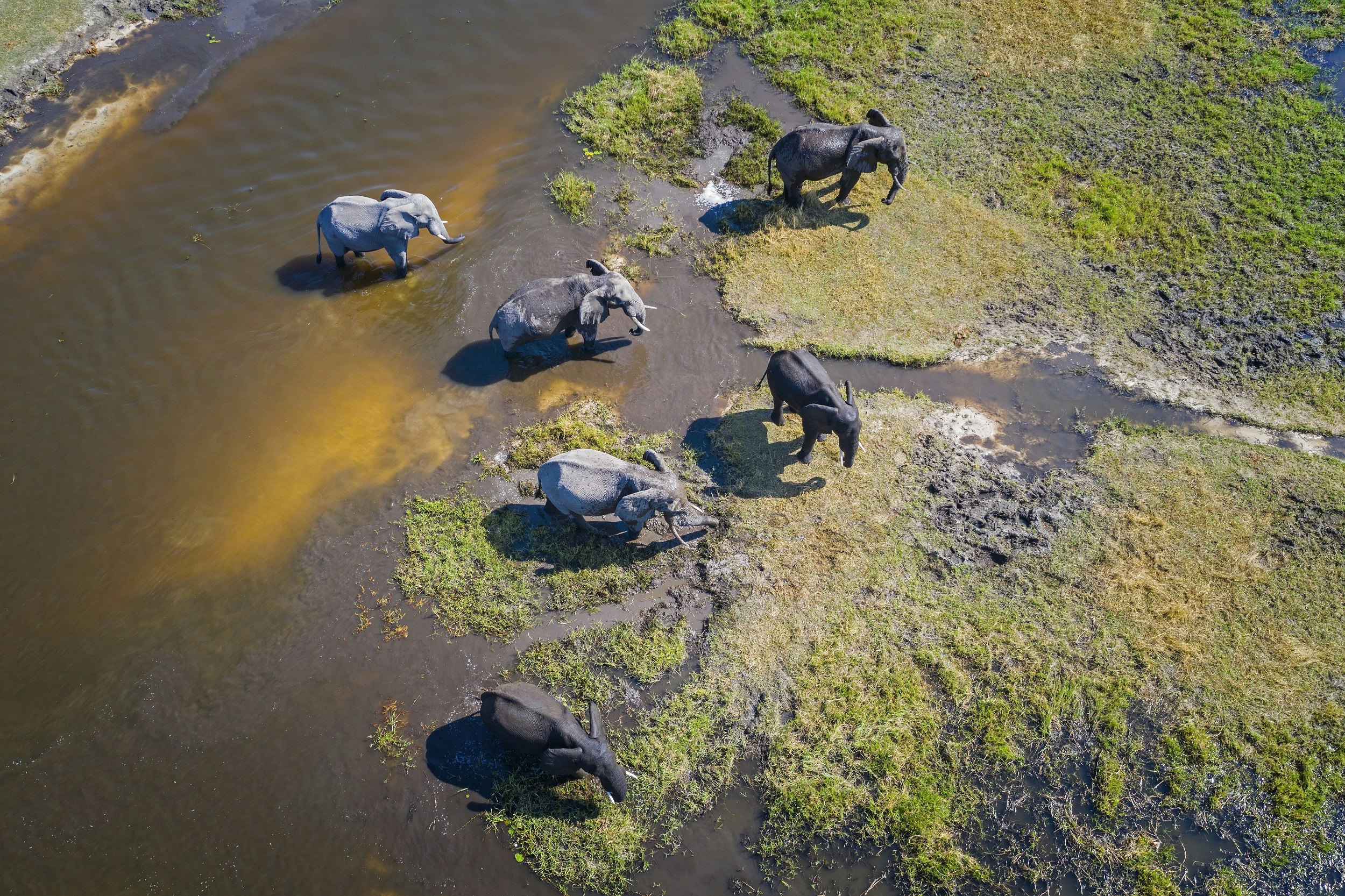
Elephants in peril
Thanks to the ivory in their tusks and the material’s enduring popularity (particularly in Asia), elephants have been poached in unsustainable numbers since the 1970s – and their numbers have fallen dramatically as a result. The African elephant is listed as vulnerable by the International Union for the Conservation of Nature (IUCN) .
In the 1970s and ’80s, poaching caused the numbers of African elephants to crash from around 1.3 million to 500,000. The slaughter ended only in 1989, when the trade in ivory was banned under the Convention for International Trade in Endangered Species (CITES). After the ban, world raw ivory prices plummeted by 90%, and the market for poaching and smuggling was radically reduced. The same year, Kenyan President Daniel arap Moi dramatically burned 12 tons of ivory in Nairobi National Park as a symbol of Kenya’s resolve in the battle against poachers.
But poaching is again on the rise. Africa has lost more than 30,000 elephants a year since 2010. That’s around 7% of Africa’s elephant population every year. Or 673 elephants being killed a week. Or 96 a day. Ot four elephants being killed for their tusks every hour.
In 2014, for the first time in decades, a critical threshold was crossed when more elephants were being killed on the continent than were being born.

The 2016 Great Elephant Census recorded a 30% decrease in Africa’s elephant populations in just seven years – although there was good news alongside the bad. Kenya’s elephant population, for example, was considered to be “relatively stable,” at 25,959; Uganda ’s 4864 elephants, meanwhile, provided cause for optimism after the country’s elephant population had fallen to just 800 during the 1980s. Tanzania, on the other hand, saw a catastrophic 60% decline in elephant numbers in the five years to 2016, with just 42,871 elephants – and 2.6 carcasses spotted for every live counterpart.
In 2023, an aerial survey of the Kavango Zambezi Transfrontier Conservation Area , which covers 40,000 miles across five Southern African countries, happily reported that the region’s elephant population – the continent’s largest – was stable . The conservation community awaits more data to show whether or not their efforts to save the elephant have stemmed the tide of killings.
Safari animals: the story of rhinos (and the best places to see them)
This article was first published Nov 14, 2019 and updated Apr 25, 2024.
Explore related stories
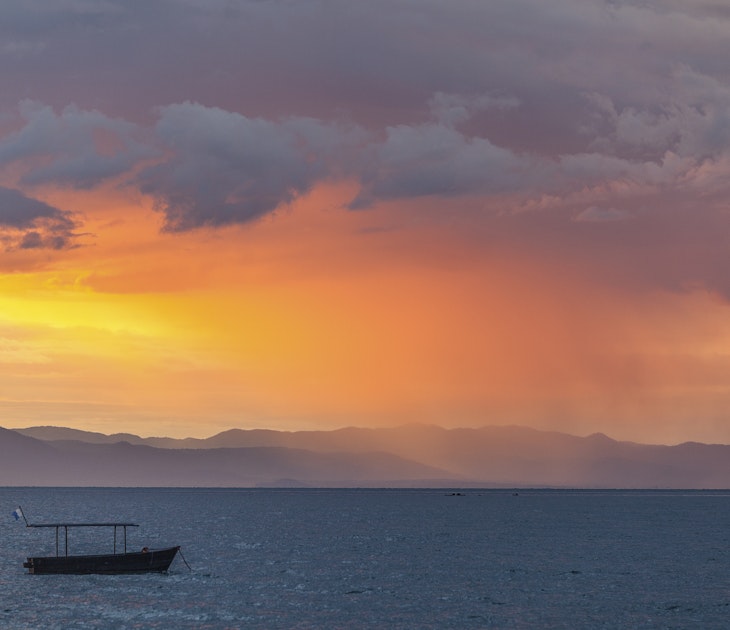
Mar 16, 2023 • 3 min read
Whether it's for wildlife or a slice of lakeside serenity.
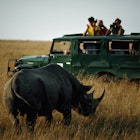
Aug 16, 2022 • 6 min read
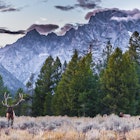
Dec 2, 2021 • 5 min read

Mar 20, 2024 • 8 min read

Mar 4, 2024 • 8 min read

Feb 27, 2024 • 6 min read

Feb 20, 2024 • 17 min read

Feb 19, 2024 • 7 min read

Feb 12, 2024 • 10 min read
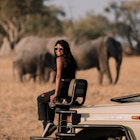
Jan 31, 2024 • 6 min read
- South Africa
- Family Safaris
- Luxury Safaris
- Wildebeest Migration
- Primate Safaris
- Riding Safaris
- Kilimanjaro Climbs
- Cycling Safari
- Mobile Safaris
- Beach Holidays
- Exclusively yours
- Canoe and Mokoro Safaris
- Weddings & Honeymoons
- Specialist Photographic Safaris
- Walking Safaris
- Small Group Travel
- Single Travellers
- Self Drive Adventures
- Getting Started
- When to Travel
- Safari Pricing
- Accommodation
- A Day on Safari
- Safari Tipping Guide
- The Insider’s Guide
- Why Aardvark?
- The Aardvark Story
- Meet the team
- Feedback we loved
- Responsible Tourism
- Booking Conditions
- Aardvark Guarantee
Best places to see Africa’s giraffe
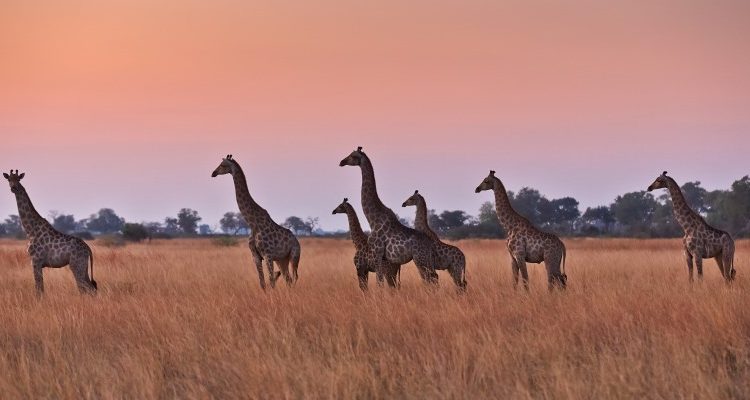
Giraffe are among Africa’s most enchanting animals. Spotting a head peering over the top of an acacia tree or admiring the effortless ease with which they canter across the plains never fails to delight. They are rarer than many would think, with current estimates suggesting just over 117,000 giraffe in the wild. Although still a precariously low figure (around one giraffe for every three to four elephant in Africa), there has been a heartening increase in numbers of around 20% since 2015.
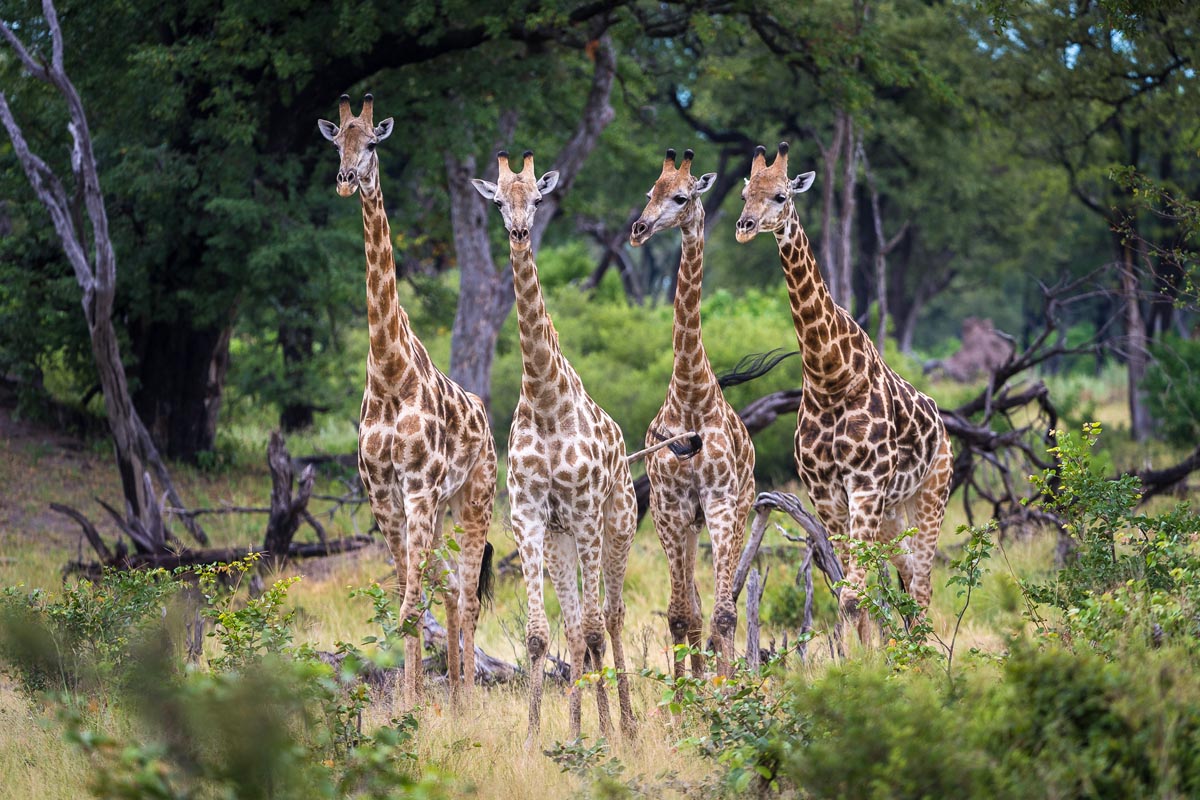
Elegant giraffe close to King’s Pool Camp , Botswana
These elegant creatures are not one, but rather four species, each with subtle differences and their own particular range.
Masai giraffe are found across Kenya and Tanzania with an isolated population (a sub-species known as Thornicroft’s giraffe) in Zambia’s South Luangwa Valley. The large leaf shaped patches on the Masai giraffe are noticeably darker than those found on other species and are surrounded by a creamy brown colour which continues down their legs.
The Northern giraffe range across Eastern and Central Africa and are the rarest of the four species. Their patches are much paler than the Masai giraffe and they have no markings on their lower legs. The Rothchild’s giraffe (more commonly known as the as the Nubian giraffe to which it is genetically identical) is a sub-species and found in Kenya and Uganda.
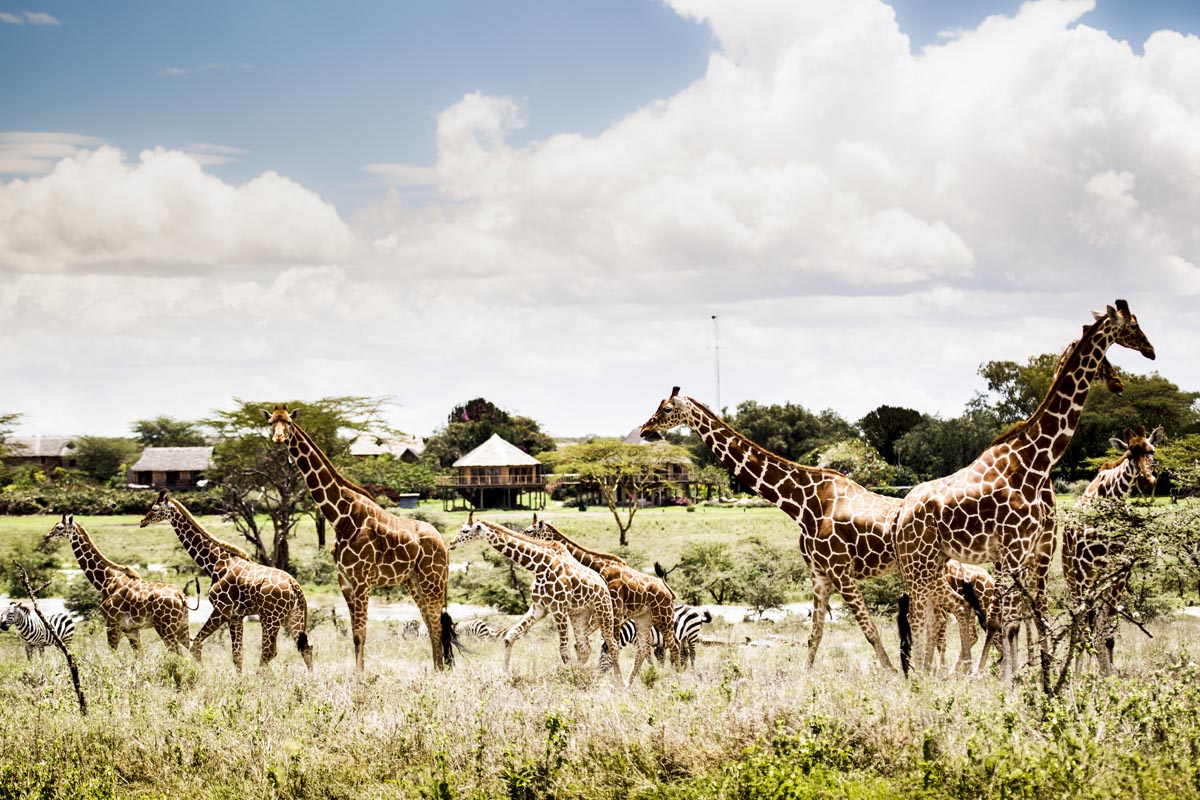
A healthy giraffe herd close to Segera Retreat in Kenya
Reticulated giraffe roam northern Kenya with a few smaller populations recorded in southern Somalia and southern Ethiopia. With their distinctive orange-brown patches defined by obvious white lines, they are perhaps the most handsome of the species.
The Southern giraffe population accounts for more than 50% of Africa’s giraffe and splits into two sub-species – the Angolan giraffe which ranges through Botswana, Namibia and Zimbabwe, and the South African giraffe found in Botswana, Mozambique, South Africa, parts of Zambia and Zimbabwe. The Angolan giraffe is relatively light in colour – in some parts of Namibia they can be almost colourless – with spots of colour speckled across their lower legs. The large irregular shaped patches on the South Africa giraffe appear in various shades of brown and their lower legs speckled with uneven spots.
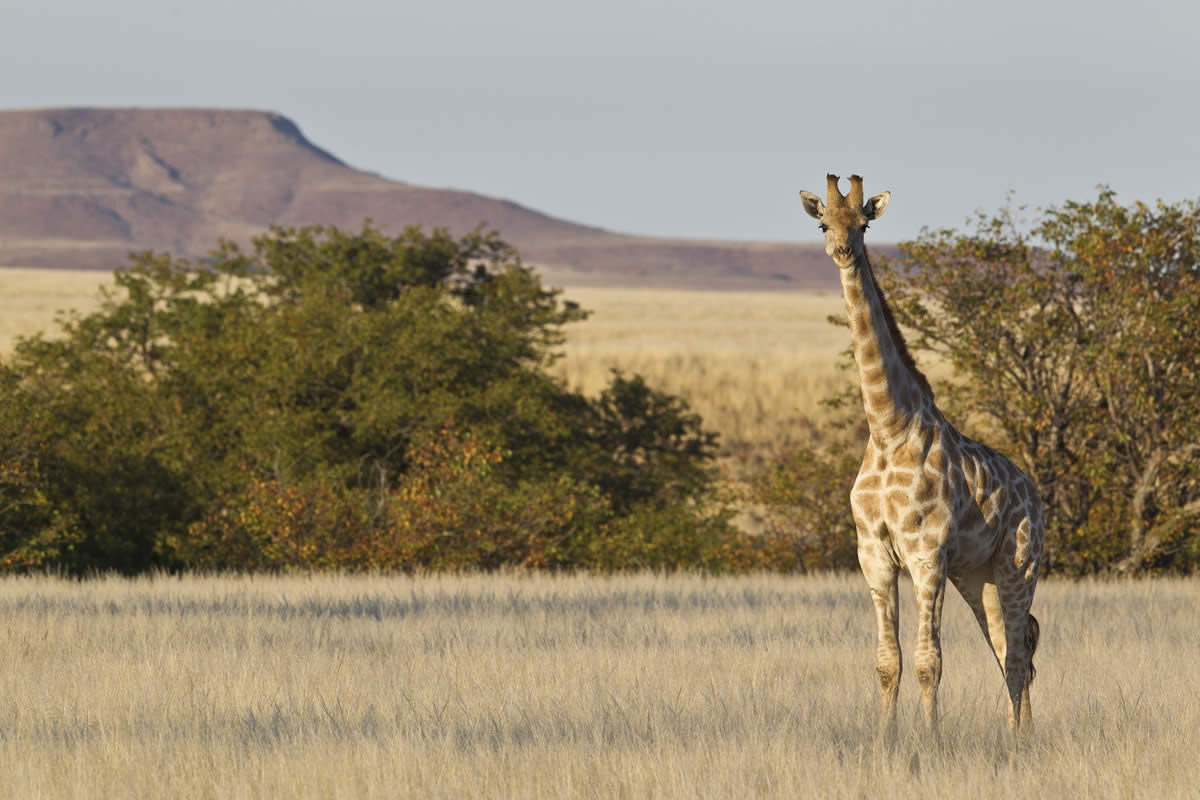
Lone giraffe close to Desert Rhino Camp
It comes as no surprise that they are the world’s tallest animal – the largest ever recorded stood at six metres. They are quick across the plains, easily able to sustain speeds of around 30mph, and can deliver a lethal kick, from both front and hind legs.
So where is best to see these charismatic animals?
Where to see biggest herds
You can see groups of up to 50 giraffe in northern Selous, Tanzania, and Murchinson Falls National Park, Uganda
The Nyerere National Park (formerly Selous Game Reserve) is perhaps the closest Tanzania gets to a true wilderness paradise, a fantastically large, remote region – the size of Switzerland and the biggest reserve in East Africa – and with plenty of water, opening up a whole range of activities other parks can only dream of. The wildlife is prolific and it’s a great place to spot giraffe gathered in large herds. Roho ya Selous and Siwandu are super choices here.
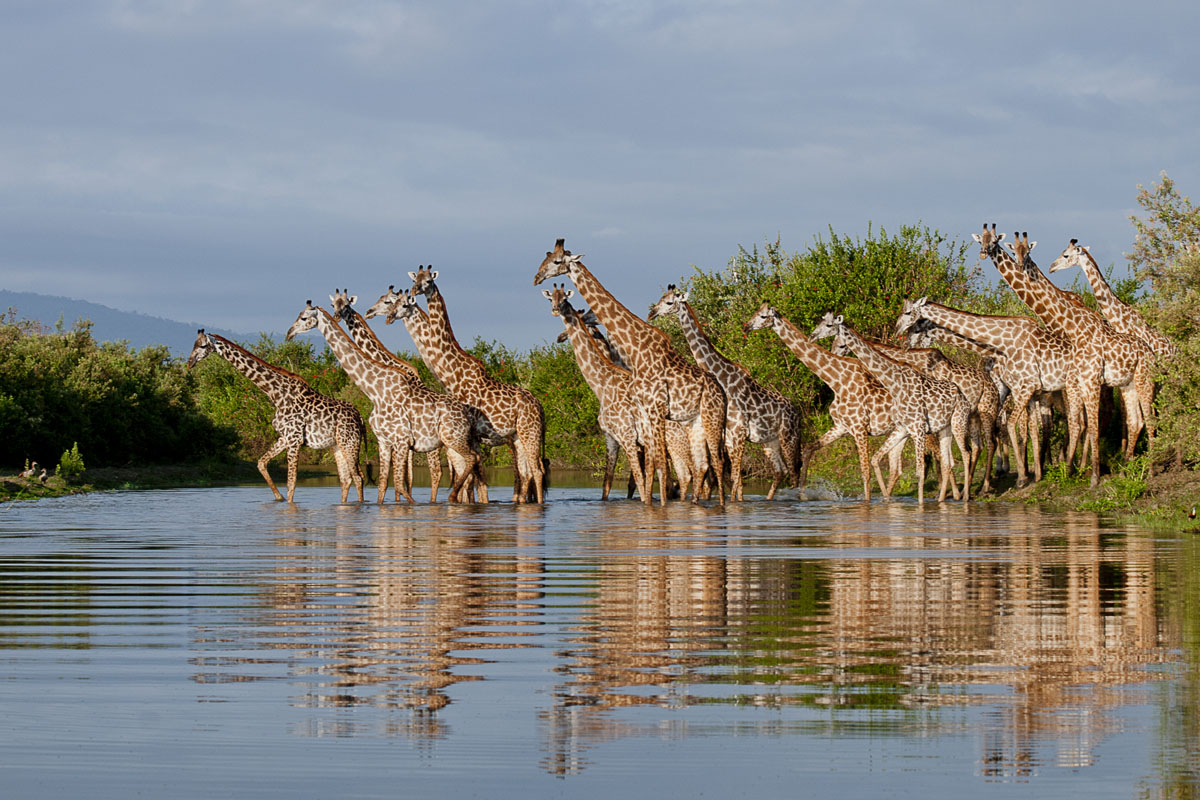
A journey of giraffe in Nyerere National Park close to Roho ya Selous
There’s a good chance to spot sizeable herds of Rothschild’s giraffe at Murchison Falls National Park, Uganda’s largest and oldest conservation area. The park is famous as one of the best places to see the extraordinary shoebill as well as a diverse selection of mammals and birds. Stay on the banks of the Nile River, at Nile Safari Lodge , and enjoy wildlife drives and river trips.
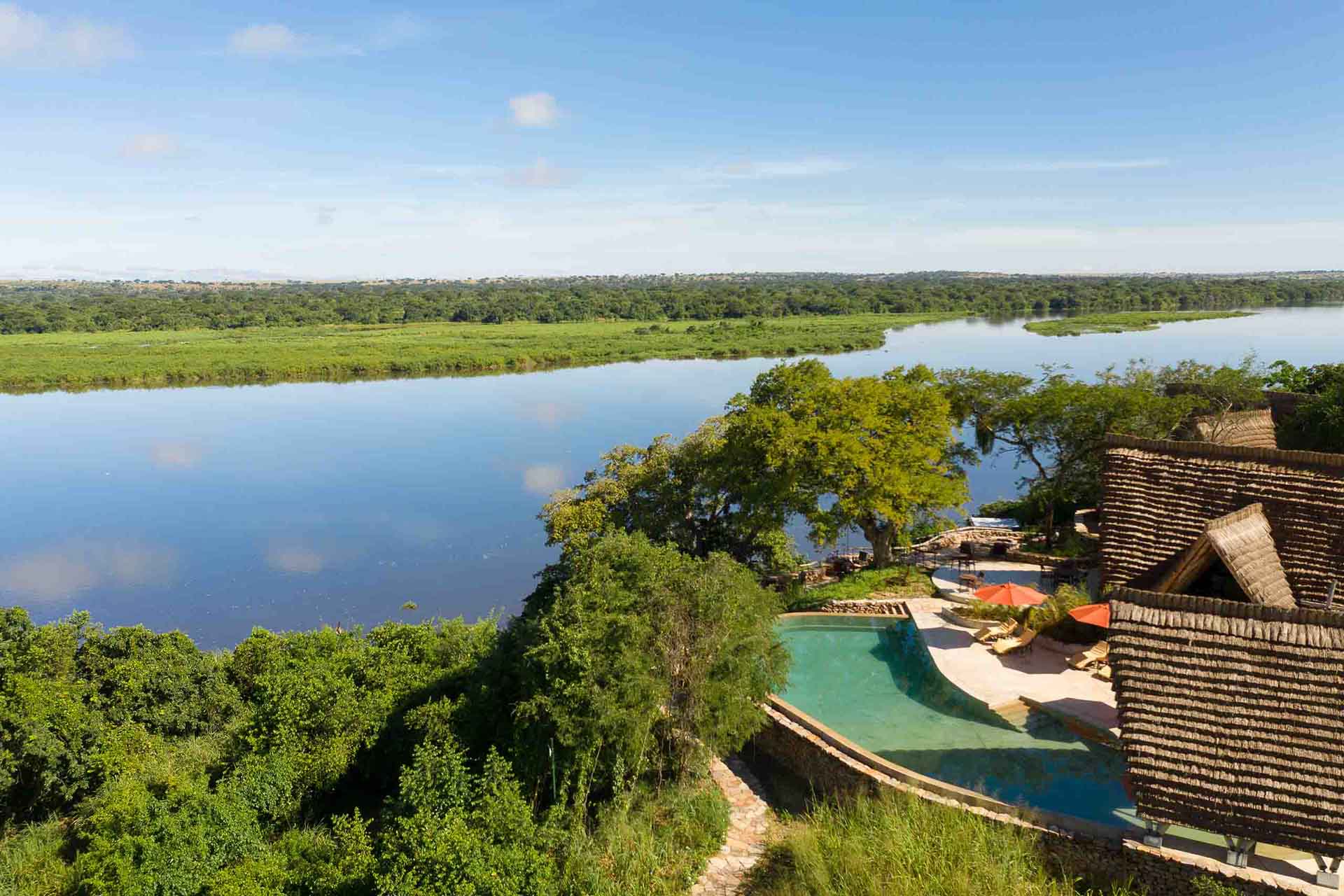
Nile Safari Lodge, perfectly positioned to explore Murchison Falls National Park
Where to see reticulated giraffe
With only a couple of safari camps within its boundaries, Meru is little-visited and you’re unlikely to encounter many other vehicles here. It is one of the most rewarding of all Kenya’s national parks and certainly a great part of any safari. All the large mammals are found in Meru and, with a bit of luck, you can spot the ‘Big Five’ but that’s not really what you’ve come here to see. More rewarding is to search out the ‘northern five’ of gerenuk, Grevy’s zebra, reticulated giraffe, beisa oryx and Somali ostrich. Elewana Elsa’s Kopje or Meru Wilderness are wonderful places to stay in this peaceful park.
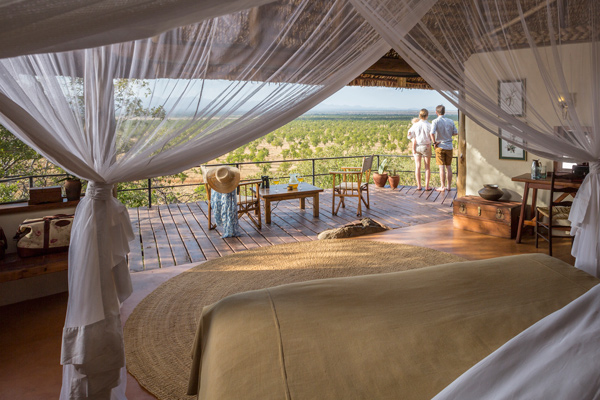
Elewana Elsa’s Kopje is a gorgeous lodge in Meru National Park
Samburu is a wild and beautiful place, and wildlife is easy to spot in the parched landscape. There are large herds of elephant and plenty of buffalo, waterbuck, reticulated giraffe, and zebra, along with dry country rarities such as gerenuk. There’s rarely much grass cover so lion, leopard and cheetah are also relatively easy to spot. The banks of the Ewaso Ngiro river with large shady trees, provide plenty of excellent vantage points as the wildlife gathers at the water for an evening drink. Moroccan style Sasaab is a lovely spot here.
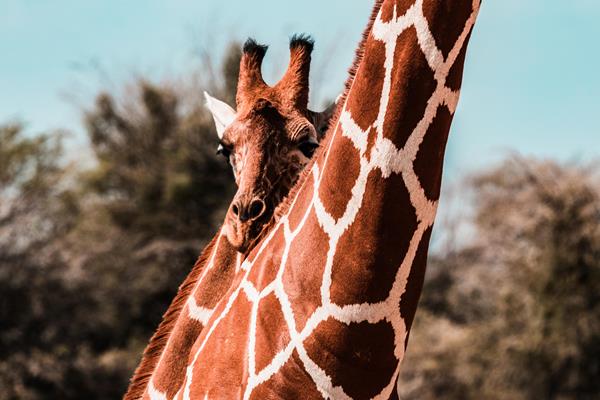
Handsome reticulated giraffe near Sasaab
Where to see Masai giraffe?
The Chyulu Hills is a stunningly pretty area of Kenya – gently rolling hills and expansive plains with Mount Kilimanjaro as a backdrop. There’s good wildlife including lion, huge old tusker elephant, jackal, wild dog and large numbers of zebra, wildebeest and Masai giraffe. With only a handful of lodges in the in the area, visitors can enjoy all this in wonderful privacy. Ol Donyo Lodge is one of our very favourites and a superb spot to enjoy all that’s on offer here.

Giraffe in the shadow of Mount Kilimanjaro close to Ol Donyo Lodge
Another option is to head to one of the private conservancies adjacent to the Masai Mara National Park. The Mara Nabiosho Conservancy hosts an impressive amount of wildlife, including what is considered to be the greatest density of giraffe anywhere in Africa. Among other wildlife thriving here are healthy populations of elephant, buffalo, zebra, hyena, and lion. Naboisho Camp is a great place to stay, and since the conservancy is a partnership between local people and the safari camp operators your visit directly benefits the community.
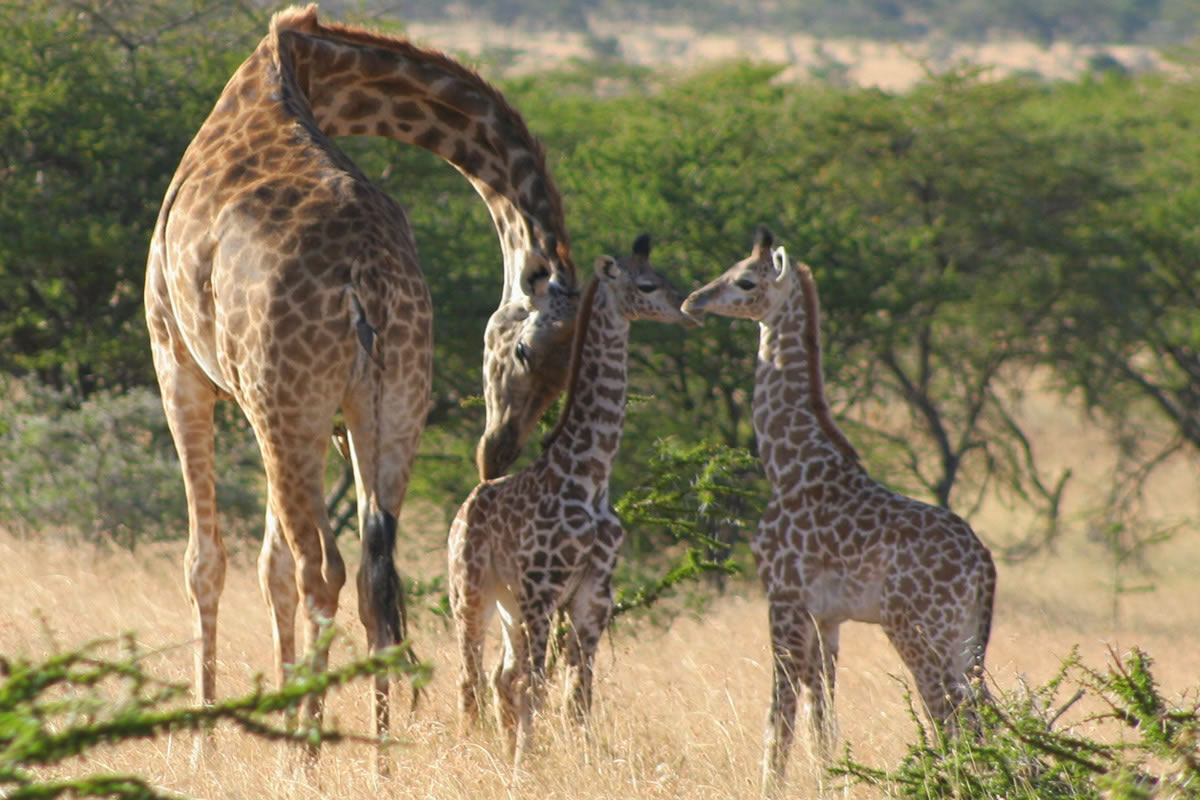
A wealth of wildlife in the Mara Nabiosho Conservancy including good numbers of giraffe
Where to horse ride with giraffe?
For experienced equestrians, a riding safari with African Horseback Safaris or Okavango Horse Safaris in the Botswana’s Okavango Delta affords a unique way to glimpse this wildlife hotspot. Cantering through the delta floodwaters alongside giraffes is a real once-in-a-lifetime experience. Although this is for confident riders, we can also offer options for novice riders wishing to ride out with giraffes.
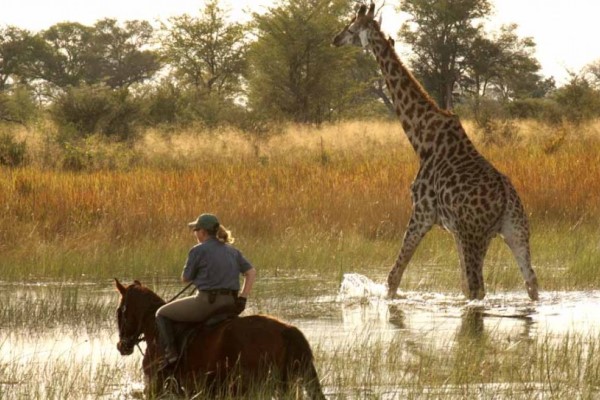
Wading through the Okavango Delta alongside giraffe with Okavango Horse Safaris
Where to see giraffe on a walking safari?
You’re never that far from the wildlife in Zambia’s South Luangwa National Park – it’s one of Africa’s finest wildlife areas with more than 60 animal species and at least 400 different types of bird. When you see a lion, others won’t be far behind as here they tend to roam in prides of up to 30. It’s also home to the Thornicroft giraffe, a sub-species found only in the South Luangwa. The park is famous for its walking safaris, with options ranging from multi day walks camp to camp to short bush walks for an hour or so. Kaingo Camp , Time + Tide’s Kakuli or Luwi , and Robin Pope Walking Safaris would all be lovely options here.
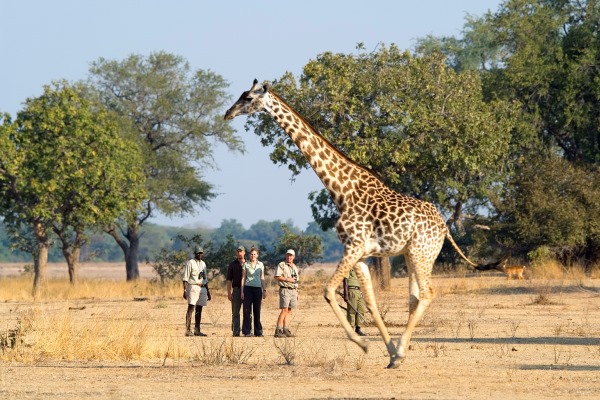
Lovely giraffe sighting on a Robin Pope Mobile Walking Safari
Camel supported walks can be arranged in many parts of Kenya such as the Laikipia region, or in lesser travelled areas such as the Mathews Range to the north of Mount Kenya. Giraffes are seen in good numbers in these areas and when walkers are alongside the camels, the giraffes are happy to allow them to get really close. Choose Karisia Walking Safaris for multi-day walking safaris or any of Sarara’s camps for lovey lodge-based walking safaris.

Plenty of giraffe sightings on a Karisia’s camel supported walking safari
Where to see desert giraffe?
Namibia may not have quite the populations of wildlife as its near neighbours, but its desert adapted species are quite astonishing. Giraffe, elephant, rhino, giraffe, oryx and springbok are among those that have developed to cope with the harsh conditions here – those living in the Skeleton Coast National Park are as good an example of any. Footage taken near Hoanib Skeleton Coast Camp featured in the BBC David Attenborough “Giraffes: Africa’s Gentle Giants,” and provides an extraordinary glimpse into the lives of these animals here. The lodge itself is a great base from which to explore this rugged, remote region on foot of from a vehicle.
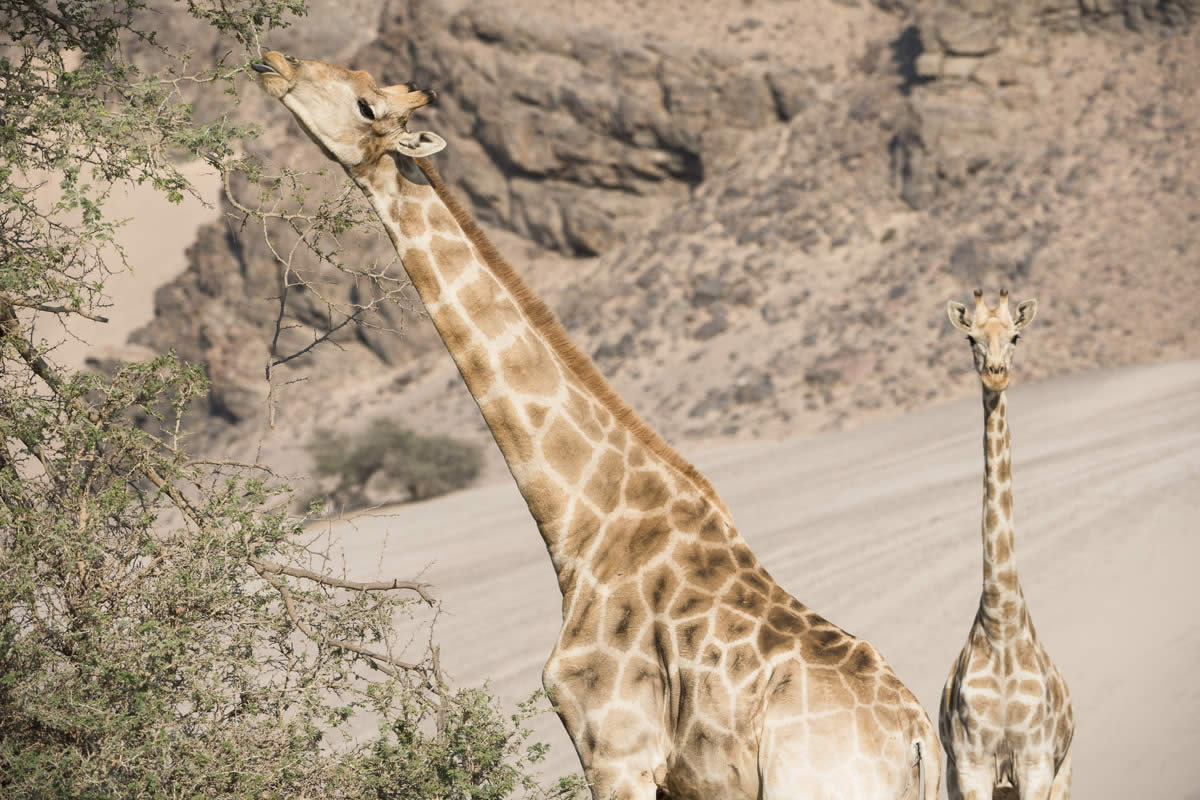
Desert dwelling giraffe are often paler than their savannah living cousins. These two spotted near Hoanib Skeleton Coast Camp
Where to see giraffe up close?
Giraffe Manor is a luxury house-turned hotel in the Karen suburb of Nairobi and, for those able to book well in advance of travel to secure a prizes space, is a fabulous place for a night before or after safari proper. Resident Rothschild giraffes join guests for breakfast or can be fed from your bedroom window. Cheeky giraffes have also been known to try and squeeze into the foyer. If you are just passing through Nairobi then the Giraffe Centre (in the grounds of Giraffe Manor) is well worth a visit. There are a handful of safari camps Epako Safari Lodge (Namibia), Sirikoi (Kenya) and The River Club (Zambia) which also have semi-habituated giraffes on their properties.
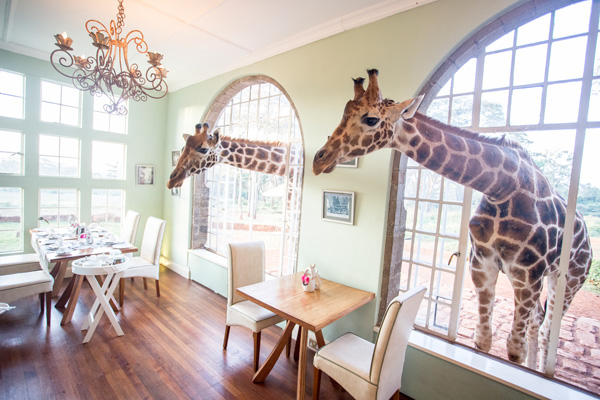
‘Where’s breakfast’? Hungry residents at Giraffe Manor
What next? We would be delighted to help with planning your perfect safari holiday to include some of the best places to see Africa’s giraffe. Our team of experts has travelled widely throughout Africa and the Indian Ocean and can offer expert advice. Do get in touch – chatting to people by phone or email is what we do best. We listen, we explain, we answer all sorts of questions even those you didn’t know to ask, and finally we make suggestions. If this is your first time to Africa or your twenty first, we have a team standing by to help make the planning easy and the journey the best ever. Please get in touch whatever stage you’re at.
2 responses to “Best places to see Africa’s giraffe”
Which is the best time of year to visit Africa, to see giraffes? Which is the best country to see them? Which is the best value?
Hi Maggie, I have passed your questions on to our sales team who will be in touch with you soon. All the best, Katy
Leave a Reply Cancel reply
Your email address will not be published. Required fields are marked *
This site uses Akismet to reduce spam. Learn how your comment data is processed .
More about the Author
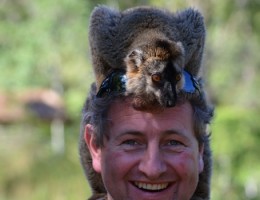
Favourite African experience
Favourite animal, my favourite four camps.
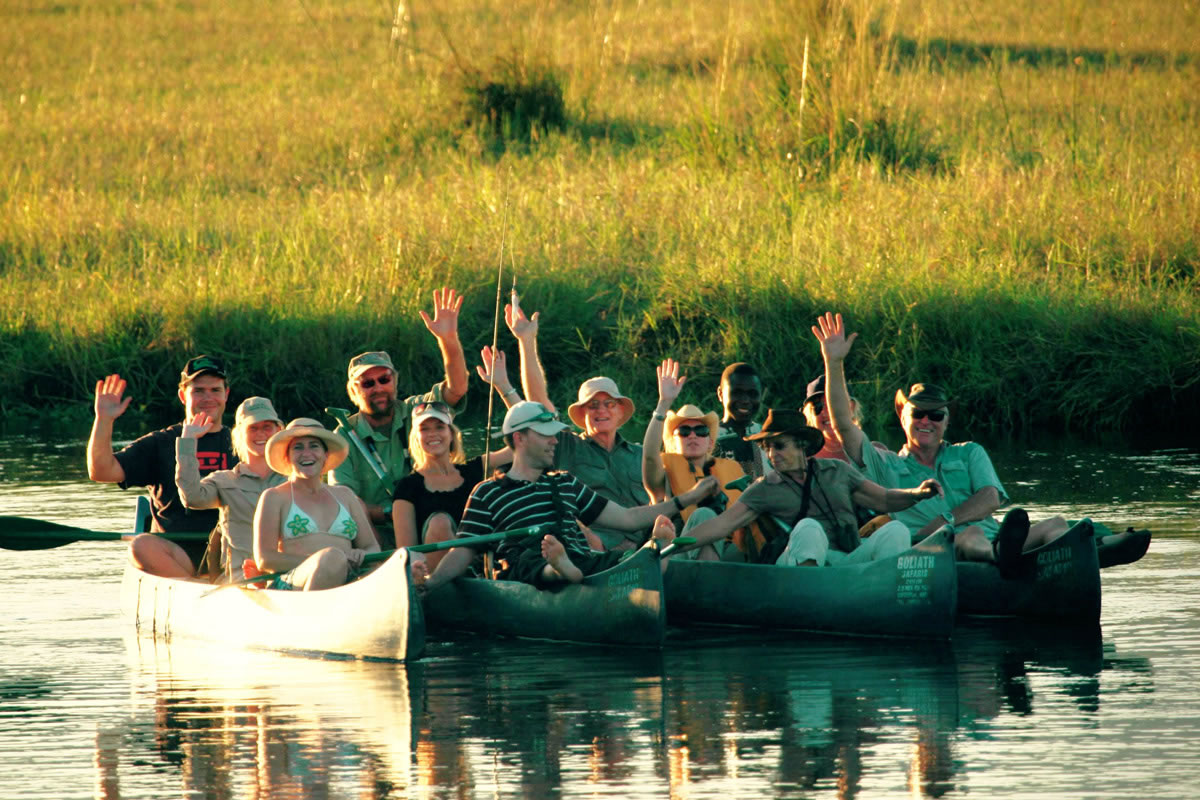
African countries visited
Tropical islands visited, riding experience, on arranging holidays.
- © 2024 Aardvark Safaris
- Privacy Policy
Our website uses cookies
Privacy overview.
share this!
September 14, 2020
How do giraffes and elephants alter the African Savanna landscape?
by Smithsonian Tropical Research Institute
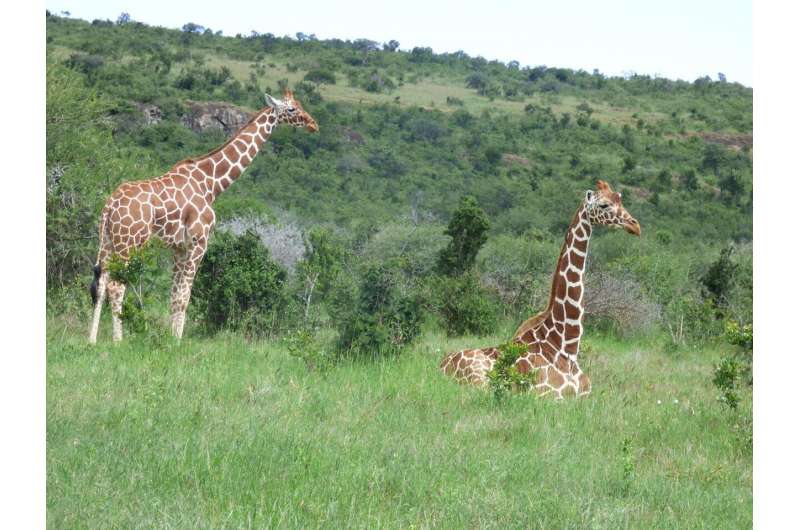
As they roam around the African savanna in search for food, giraffes and elephants alter the diversity and richness of its vegetation. By studying the foraging patterns of these megaherbivores across different terrains in a savanna in Kenya, scientists from the Smithsonian Tropical Research Institute (STRI) and collaborating institutions discovered that these large mammals prefer to eat their meals on flat ground, potentially impacting the growth and survival of plant species on even savanna landscapes, such as valleys and plateaus.
Megaherbivores are more concerned about eating as much food as possible while expending the minimum amount of effort, than about avoiding potential predators. Elephants may consume as much as 600 pounds of vegetation in a day; giraffes, about 75. This drove scientists to wonder about the impact of these megaherbivores on vegetation across a range of landscapes in the savanna .
"Previous studies have demonstrated that megaherbivores adjust their movement patterns to avoid costly mountaineering," said co-author David Kenfack, STRI staff scientist, coordinator of the ForestGEO network forest monitoring plots in Africa and recently elected Fellow of the African Academy of Sciences. "We wanted to know the extent to which fine-scale variations in topography may influence browsing damage by these charismatic megaherbivores and evaluate whether seasonal shortages in food availability would force the megaherbivores to venture into areas with rugged terrain."
Their observations conducted within a 120-hectare Smithsonian ForestGEO long-term vegetation monitoring plot located at Mpala Research Center in Kenya confirmed that giraffes and elephants prefer flat ground while foraging. They compared the damage on Acacia mellifera trees, which grow all over the savanna landscape and are a common meal for megaherbivores. They found that the trees growing on steep slopes were taller and had fewer stems than those in valleys and plateaus, suggesting that elephant and giraffes tend to avoid feeding in these less accessible habitats.
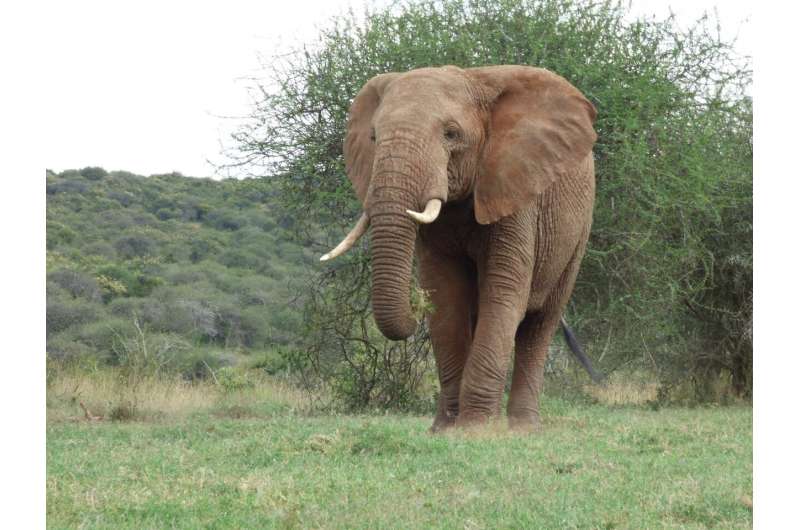
This behavior did not change during the dry season, when resources become scarce, indicating that these two species would rather disperse to new areas with more favorable conditions than climb up a nearby slope to feed.
For the authors, these feeding patterns may help preserve steep slopes as habitat refugia, with a greater diversity and density of vegetation than more frequently visited areas. Their findings support this argument: the number and variety of trees encountered on the steep slopes was higher than in the valleys and plateaus.
"This study has broadened our understanding of the role of topography in explaining diversity patterns of plants," said Duncan Kimuyu, a Smithsonian Mpala postdoctoral fellow, lecturer at Karatina University in Kenya and main author of the study. "Further research is warranted to understand how other factors such as differences in soil properties may interact with topography and megaherbivores to influence the growth and survival of vegetation in the African savanna."
Journal information: Biotropica
Provided by Smithsonian Tropical Research Institute
Explore further
Feedback to editors

Discovery of biomarkers in space—conditions on Saturn's moon Enceladus simulated in the laboratory
15 minutes ago

Researchers uncover mechanism for short-distance vesicle movements

Two-year study shows some varieties of annual flowers have a place in pollinator-friendly gardens

The secret to mimicking natural faults? Plexiglass and Teflon
27 minutes ago

Indian Ocean sea-surface temperatures found to be accurate predictor of dengue outbreaks

Long-term study finds organic farming leads to adaptations in the genetic material in plants
34 minutes ago

Tracing the origins of organic matter in Martian sediments

Angling fish for food: Study finds recreational fishing accounts for 11% of reported harvest in inland fisheries

Nanoparticle plant virus treatment shows promise in fighting metastatic cancers in mice

Chinese fruit fly genomes reveal global migrations, repeated evolution
Relevant physicsforums posts, a brief biography of dr virgina apgar, creator of the baby apgar test.
22 hours ago
Who chooses official designations for individual dolphins, such as FB15, F153, F286?
May 9, 2024
Is it usual for vaccine injection site to hurt again during infection?
May 8, 2024
The Cass Report (UK)
May 1, 2024
Is 5 milliamps at 240 volts dangerous?
Apr 29, 2024
Major Evolution in Action
Apr 22, 2024
More from Biology and Medical
Related Stories

Elephants reverse the cattle-caused depletion of soil carbon and nutrient pools
Apr 10, 2020

Rewilding can mitigate climate change, researchers report after global assessment
Feb 5, 2020

Poaching threatens savannah ecosystems
Feb 12, 2014

Humans are not off the hook for extinctions of large herbivores – then or now
Apr 8, 2019

A big difference between Asian and African elephants is diet
Aug 30, 2017

Human ancestors not to blame for ancient mammal extinctions in Africa
Nov 22, 2018
Recommended for you

Dice snakes found to use a variety of techniques to more effectively fake their own deaths


Elephants use gestures and vocal cues when greeting each other, study reports
May 10, 2024

Rolling with the punches: How mantis shrimp defend against high-speed strikes

Bilbies could hop back into mild climate zones, study finds

New study finds bioluminescence more common than previously thought in deep‐sea shrimp
Let us know if there is a problem with our content.
Use this form if you have come across a typo, inaccuracy or would like to send an edit request for the content on this page. For general inquiries, please use our contact form . For general feedback, use the public comments section below (please adhere to guidelines ).
Please select the most appropriate category to facilitate processing of your request
Thank you for taking time to provide your feedback to the editors.
Your feedback is important to us. However, we do not guarantee individual replies due to the high volume of messages.
E-mail the story
Your email address is used only to let the recipient know who sent the email. Neither your address nor the recipient's address will be used for any other purpose. The information you enter will appear in your e-mail message and is not retained by Phys.org in any form.
Newsletter sign up
Get weekly and/or daily updates delivered to your inbox. You can unsubscribe at any time and we'll never share your details to third parties.
More information Privacy policy
Donate and enjoy an ad-free experience
We keep our content available to everyone. Consider supporting Science X's mission by getting a premium account.
E-mail newsletter

- Safari ideas
- Experiences
- Special offers
- Accommodation
- Start planning
- Booking terms
- When to go on safari - month by month
- East or Southern Africa safari?
- Solo travellers
- Women on safari
- Accommodation types & luxury levels
- General tips & advice
- All stories
- Afrika Odyssey Expedition
- Photographer of the Year
- Read on our app
- 2024 entries
- 2024 details
- 2024 prizes
- 2024 entry form
- 2023 winners
- Collar a lion
- Save a pangolin
- Rules of engagement
- Job vacancies
- Ukuri - safari camps

Giraffe social structure as complex as elephants’
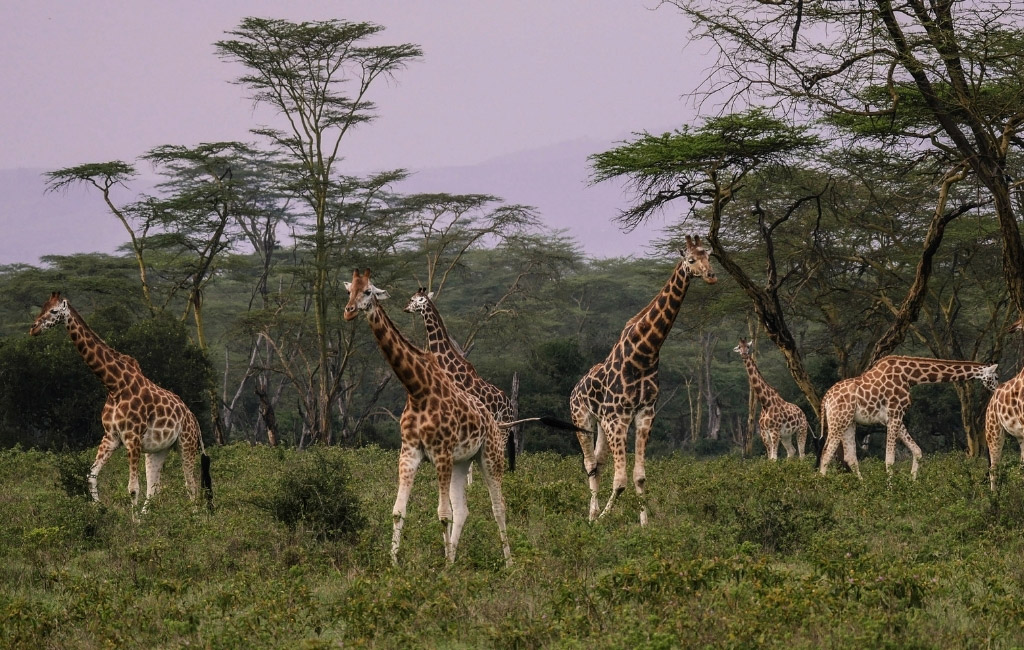
Our understanding of wild animal behaviour is ever-evolving. Analysis of available research reveals what many experts have been suggesting for decades: giraffe probably have a complex social structure that is not dissimilar to elephants.
Studying the nuances of their social structures is a complex process but is vital to unravelling evolutionary histories and designing effective conservation measures. For most large mammals, we have at least a rudimentary grasp of their social ethology. Yet, despite being one of the largest mammals on earth, the giraffe seems to have flown under the radar for an astonishing amount of time.
Until the 2000s, behavioural ecologists described giraffe as “socially aloof” (Estes 1991). The perception was that their groupings were fluid in nature, with no lasting bonds between individuals. Interpreting their social cues has been further complicated by the subtleties of their communication. Elephants and carnivores, for example, exhibit a range of vocal and body language signals that aid in interpreting the dynamics between individuals. On the other hand, giraffe are largely silent (though they do hum at low frequencies below human hearing) and apparently inexpressive. To this day, giraffe communication systems are poorly understood.

In order to investigate giraffe social structure, researchers from the University of Bristol conducted a review of 404 scientific papers on the behaviour and social organisation of giraffe. They aimed to test the hypotheses that giraffe have complex cooperative social systems and that these are matrilineal. In other words, whether or not giraffes form stable groups of females, whether females stay in their natal groups while males disperse and if, within female groups, individuals play a supportive role in raising and protecting calves.
The researchers found that giraffe group sizes usually consist of between three to nine individuals, though lone animals were often recorded. The groups were most likely to be kin (with the strongest association between mothers and grown offspring). In many instances, these associations remained stable for years and often consisted of three generations of related individuals. These matrilineal groups themselves seem to exist in a larger, more fluid society, with groups of related females associating with each other or males within their range. Giraffe mothers have been observed leaving their calves in a creche cared for by another adult. Cows also show distress behaviours following the death of another individual’s calf. These behaviours strongly suggest that giraffe cooperate during breeding.

The authors’ investigation also demonstrated that giraffe spend up to 30% of their lives in a post-reproductive state – similar to humans and some whales, which survive past the cessation of fertility. Female elephants and giraffe are capable of reproducing right up until the end of their natural lives but their fertility declines as they age and the time between successive calves increases considerably. The ‘Grandmother hypothesis’ (a theory that explains this phenomenon) suggests that post-reproductive peak females survive to help raise successive generations. Though this theory has received the usual degree of scientific disagreement, the finding emphasises the potential importance of older giraffe. As seen in elephants, it is possible that these old females are instrumental as repositories of knowledge, which may help giraffe survive times of drought or famine.
With giraffe populations in freefall (see Giraffes: The Silent Extinction ), research such as this is essential in designing successful conservation interventions and encouraging the recognition of their levels of intelligence and complexity. Though further research is needed to fully unravel the intricacies of giraffe social structure, it is evident that they are not nearly as simple as once believed. The implications of this newfound understanding extend not just to interpreting the lives of females but also older males. Again, similar to elephants, the bulls may also have an important social role, and their selective removal (such as through hunting or culling) could have far-reaching effects.
As co-author Dr Zoe Muller explains , “Conservation measures will be more successful if we have an accurate understanding of the species’ behavioural ecology. If we view giraffes as a highly socially complex species, this also raises their ‘status’ towards being a more complex and intelligent mammal that is increasingly worthy of protection.”
The full paper can be accessed here: “ A review of the social behaviour of the giraffe Giraffa camelopardalis : a misunderstood but socially complex species “, Muller, M., Harris, S., Mammal Review
HOW TO GET THE MOST OUT OF AFRICA GEOGRAPHIC:
- Travel with us . Travel in Africa is about knowing when and where to go, and with whom. A few weeks too early / late and a few kilometres off course and you could miss the greatest show on Earth. And wouldn’t that be a pity? Browse our ready-made packages or answer a few questions to start planning your dream safari .
- Subscribe to our FREE newsletter / download our FREE app to enjoy the following benefits.
- Plan your safaris in remote parks protected by African Parks via our sister company https://ukuri.travel/ - safari camps for responsible travellers

Friend's Email Address
Your Email Address

wildlife guide to the giraffe
Perhaps the ultimate icon of the African savanna, the giraffe is an unmistakable land mammal known for its long neck and spotted coat. Read on for a few interesting facts about this intriguing animal.
Latin name: Giraffa camelopardalis
Group name: Tower
Size: 4.3 meters to 5.7 meters tall
Weight: 1,192 kg for an adult male and 828 kg for an adult female
Skip to: Characteristics , Range & habitat , Diet , Behaviour , Fun facts , Video

Giraffe characteristics
With nine subspecies sharing its distinctive characteristics, the giraffe is the tallest land animal and the largest ruminant on earth. Considering the length of its neck and legs, the giraffe’s body is quite short. The giraffe sees in colour and its eyes are located on either side of its head, giving it a good view of its surroundings and any approaching predators. Moreover, it has a sharp sense of hearing and smell, another defense against predators, while it can close its nostrils during sandstorms and against ants.
Considering its long neck, it’s no wonder the giraffe has an unusually long tongue – about 45 cm to be exact. Giraffes use their tongues to deftly pick leaves from between thorns.
The giraffe’s coat is characterised by dark blotches on lighter hair. With age, male giraffes may become darker, and while calves inherit spot patterns from their mothers, each giraffe has a unique coat pattern that sets it apart.
Underneath their spotted coats, however, the giraffe is actually gray in colour, with a skin that is quite thick and allows it some protection from thorns.

Range & habitat
With a range that extends all over most of Africa, the giraffe is a staple sighting on any African safari. They are, however, most common in southern and eastern Africa, where the savannas and open woodlands offer the perfect habitat. However, the Angolan giraffe, which occurs in Namibia as well, prefers a more desert environment.
Giraffes have home ranges but are not territorial. Home ranges will vary relative to factors such as rainfall and proximity to humans.
Overall though, giraffes prefer to inhabit savannas and woodlands that are open with foliage like the acacia tree, instead of more dense environments like miombo woodlands.
During the wet season, groups of giraffe may be more spread out, enjoying the resplendent food sources around them. But when the dry season arrives, giraffes are found to congregate around the few evergreen bushes and trees in their area.
Giraffes mothers tend to feed where an area is most open, which gives her a better view over the surroundings and any danger close by.
Giraffes feed mainly on leaves, fruits and flowers of acacia trees, easily reaching up to nibble on the top parts that other herbivores can’t reach. Acacias seem to be one of their favourite sources of food, as well as trees from the Commiphora and Terminalia genera, which provide giraffes with their much-needed source of protein and calcium.
Notwithstanding their long necks, giraffes may also bend down and feed on shrubs and grasses. All in all, they feed and ruminate for most of the day, consuming a total of about 34 kg of foliage every day. However, the giraffe actually needs much less food than other herbivores as the food it does get is much higher in nutrients, while its digestive system is extremely efficient.

Behaviour & lifestyle
When out on safari, keep a lookout for giraffes arranged in groups of calves watched over by one or two mothers. These calving pools are often colloquially referred to as giraffe creches and they allow the mothers to feed elsewhere while a trusted individual keeps a lookout for danger.
For the most part, giraffe herds consist of either related females and their offspring or groups of unrelated adult bachelors. However, the different groups may sometimes come together and gather in larger herds.
Giraffe hierarchies are established by the males through an activity known as “necking” in which two giraffes use their necks as a weapon during fights, swinging and hitting each other. The winning male is dominant and has better access to the fertile females for reproduction. However, when it comes to raising the young, that is solely in the sphere of female giraffes.
Female giraffes give birth to their young standing up. The calf drops to the ground, which severs the umbilical cord. After its mother has groomed and cleaned the newborn, the calf will slowly attempt to stand up, but within a few hours it will be able to run around.
Fun giraffe facts
- Giraffes spend most of their lives standing up, even giving birth standing up. The calves fall up to 2 meters to the floor at birth as their introduction to the world.
- Giraffes don’t need much sleep to function, typically getting less than two hours each day!
- Giraffes can run at speeds of up to 56 kilometers per hour over short distances!
- Like human fingerprints, each giraffe’s spot pattern is completely unique, and no two are the same.
Meet the giraffe
Have you seen a giraffe in the wild? What is your favourite memory of an African safari that involved giraffes? Tell us in the comments below!
Dagg, A. I. (1971). “Giraffa camelopardalis” (PDF). Mammalian Species . 5 (5): 1–8. doi:10.2307/3503830. JSTOR 3503830.
Estes, R. (1992). The Behavior Guide to African Mammals: including Hoofed Mammals, Carnivores, Primates . University of California Press. pp. 202–07 . ISBN 978-0-520-08085-0.
Fennessy, J. (2004). Ecology of desert-dwelling giraffe Giraffa camelopardalis angolensis in northwestern Namibia (Ph.D. thesis). University of Sydney.
Fennessy, S.; Fennessy, J.; Muller, Z.; Brown, M. & Marais, A. (2018). “Giraffa camelopardalis ssp. rothschildi”. IUCN Red List of Threatened Species . 2018 .
Kingdon, J. (1988). East African Mammals: An Atlas of Evolution in Africa, Volume 3, Part B: Large Mammals . University Of Chicago Press. pp. 313–37. ISBN 978-0-226-43722-4.
Kingdon, J. (1997). The Kingdon Field Guide to African Mammals . Academic Press. pp. 339–44. ISBN 978-0-12-408355-4.
Knüsel, Mara; Lee, Derek; König, Barbara; Bond, Monica (March 2019). “Correlates of home range sizes of giraffes, Giraffa camelopardalis “. Animal Behaviour . 149 : 143–151. doi:10.1016/j.anbehav.2019.01.017.
Prothero, D. R.; Schoch, R. M. (2003). Horns, Tusks, and Flippers: The Evolution of Hoofed Mammals . Johns Hopkins University Press. pp. 67–72. ISBN 978-0-8018-7135-1.
Simmons, R. E.; Scheepers, L. (1996). “Winning by a Neck: Sexual Selection in the Evolution of Giraffe” (PDF). The American Naturalist . 148 (5): 771–86. doi:10.1086/285955.
Skinner, J. D.; Smithers, R. H. M. (1990). The mammals of the southern African subregion . University of Pretoria. pp. 616–20. ISBN 978-0-521-84418-5.
Swaby, S. (2010). “Giraffe”. In Harris, T. (ed.). Mammal Anatomy: An Illustrated Guide . Marshall Cavendish. pp. 64–84. ISBN 978-0-7614-7882-9.
Williams, E. (2011). Giraffe . Reaktion Books. ISBN 978-1-86189-764-0.
Top countries for safaris
- Botswana safaris
- Kenya safaris
- Namibia safaris
- South Africa safaris
- Tanzania safaris
- Uganda safaris
Safari basics
- Safari animals
- How to find the right safari company
- When to go on safari
- What to take on safari
- Safari clothing – what to wear
- Safari rules & etiquette
- Wildlife spotting tips
Most read articles
- All about the ‘big five’ animals
- Collective nouns for animals
- Safari movies to watch before you go
- The world’s fastest land animals
- Apex predators
- 10 Fascinating African tribes
- The biggest animals in the world
- 17 Epic hybrid animals
- The world’s ugliest animals
- Why are flamingos pink?
Africa’s best game reserves
- Chobe National Park, Botswana
- Etosha National Park, Namibia
- Kruger National Park, South Africa
- Masai Mara National Reserve, Kenya
- Moremi Game Reserve, Botswana
- Okavango Delta, Botswana
- Serengeti National Park, Tanzania
Session expired
Please log in again. The login page will open in a new tab. After logging in you can close it and return to this page.
ADOPT & MEET A BABY ELEPHANT
Sheldrick Wildlife Trust have temporarily suspended the 5:00pm to 6:00pm adopter/foster parent visiting for now. We will update you as soon as normal operations resume.
Visit the orphaned elephants at Sheldrick Wildlife Trust (SWT) and watch their keepers feed and interact with them. This is an incredibly inspiring and moving experience and is highly recommended for anyone that has the time. SWT is the world’s most successful orphan elephant rescue and rehabilitation programme and the life-saving conservation work they carry out is incredible. At the 11:00 am viewing, visitors can watch the babies enjoy their midday mud bath and milk feed, tumbling over each other in the red earth or playing football with their friends!
The public viewing takes place daily except on the 25th December and entry is strictly by advance booking only. To request a booking, please email the SWT Kenya office with your group name, the number of people in your group, and the date you would like to visit or online via the Sheldrick Wildlife Trust website . Transfers from Giraffe Manor are included within check-in and check-out times only.
SWT do occasionally allow private visits to the orphanage, depending on individual circumstances. Please contact SWT directly via their website to enquire about the possibility and cost of this.
11:00 am – 12:00 noon
Transfers included within check-in times. Donation to SWT required.
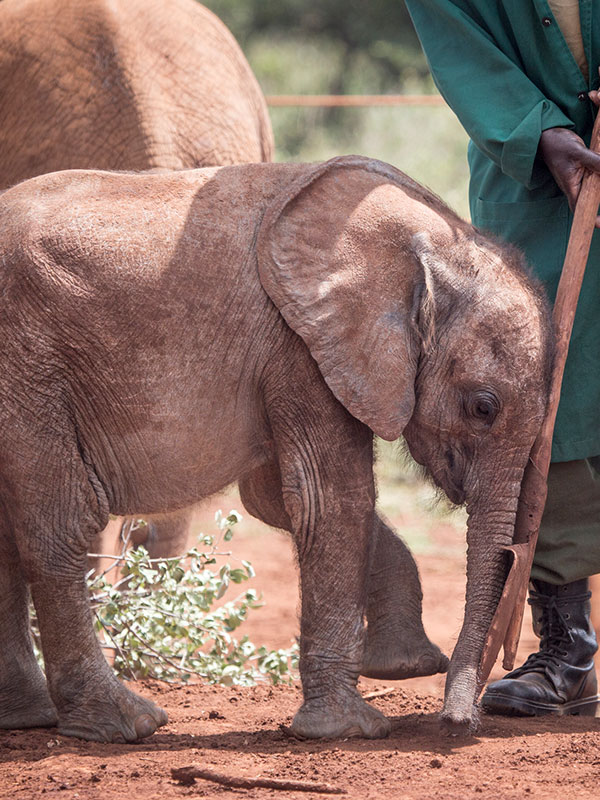
SWT is the world’s most successful orphan elephant rescue and rehabilitation programme and the life saving conservation work they carry out is incredible.
Adopting a baby elephant makes a delightful gift for loved ones. Foster parents receive regular updates of their orphan as well as photos and access to downloadable watercolours of baby elephants by Angela Sheldrick.
OTHER ACTIVITIES AT GIRAFFE MANOR
Breakfast with giraffes, stroll to giraffe centre, adopt & meet, afternoon tea, shop like a local, orchid house, croquet, boules or chess, spa treatments, nairobi national park, horseriding in nairobi, daisy’s cafe, stand tall for all wild giraffe across africa.
Find out about our footprint and sustainability projects at Giraffe Manor and how you can sponsor one of our endangered Rothschild’s giraffes.
FOLLOW US ON INSTAGRAM @THESAFARICOLLECTION
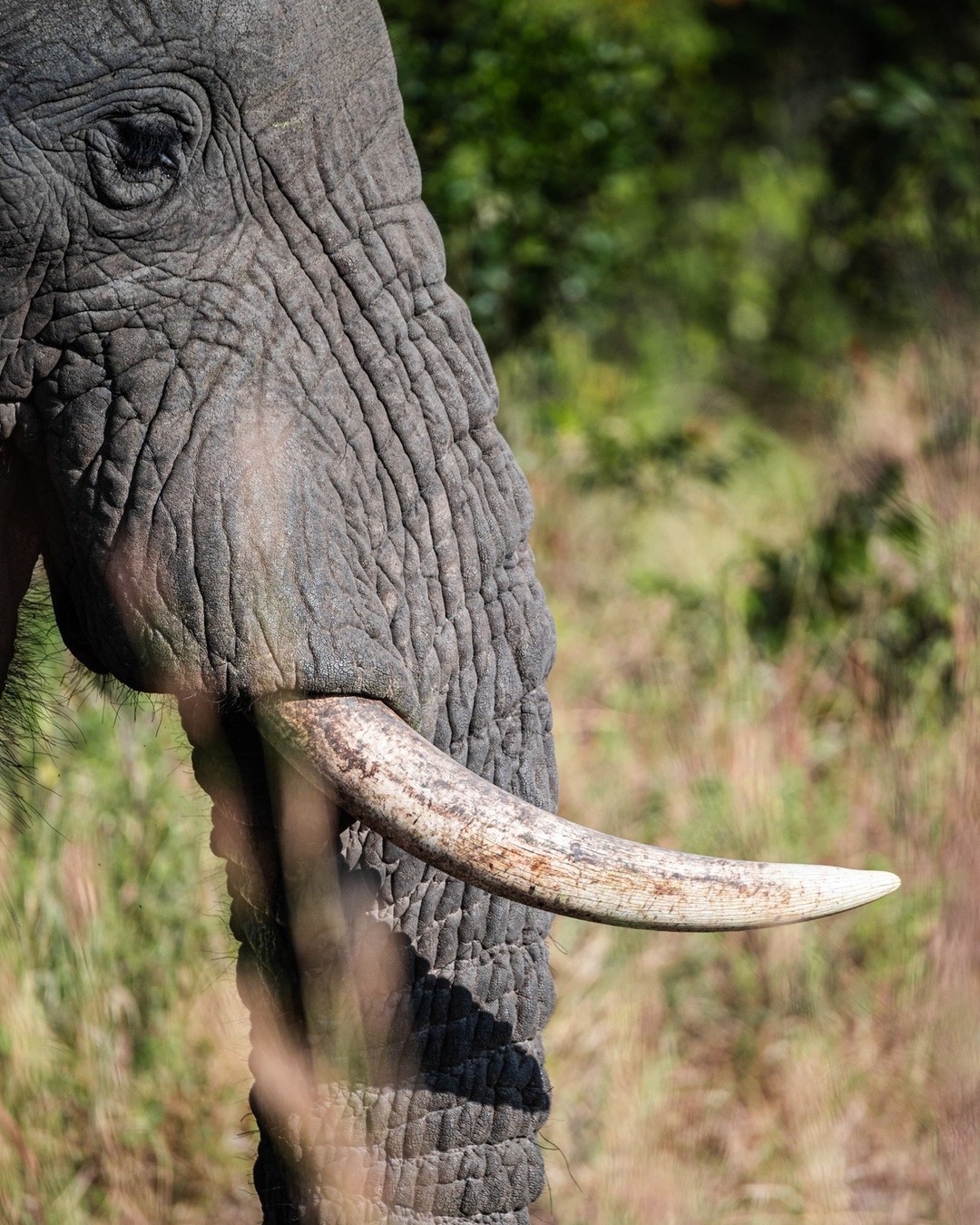
Through our unique collection of spectacular properties, online shop and Footprint Trust, we unite sustainable tourism with wildlife conservation and communities, making a difference to people and planet.
site map terms privacy policy rates contact blog
Website by Bes&Co.com © 2024 | All Rights Reserved.
Privacy Overview
Skip to Content

COME EYE-TO-EYE WITH OUR MAGNIFICENT GIRAFFE
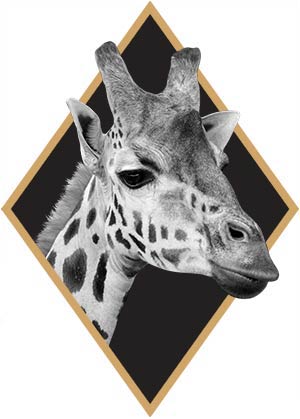
A TRULY UNIQUE OVERNIGHT WILDLIFE EXPERIENCE
The four authentically themed two-storey lodges each sleep up to five people.
Come eye-to-eye with our charismatic tower of giraffes from the balcony on the first floor, where the open-plan living room, kitchenette and dining room are also situated. Here you will also find a suspended cosy nest to lounge in.
On the ground floor is a bathroom and two bedrooms, one with a super king-size bed and the other with two single beds and one raised single, above them.
The Wildlife
Watch our herd of Rothschild’s giraffe, roaming right outside your lodge window, or from your balcony.
These gentle giants are well adapted to life in hot savannahs of Africa; being the tallest animal, they can reach up high acacia trees and strip the tasty leaves from their branches!
See if you can spot our youngest giraffes, Kingsley & Kris, who were born in 2022. Or our oldest giraffe, Faida, who is usually very dribbly and she has a wrinkly face!
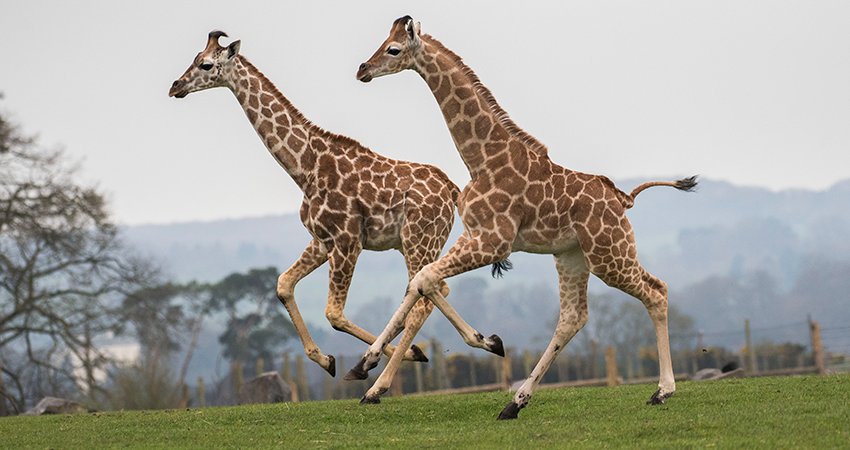
What’s Included
• Exclusive use of a Giraffe Lodge for up to five people
• Incredible views of giraffe as they roam their habitat
• Two-day Admission Ticket to West Midlands Safari Park and all attractions
• Two-day Ride Wristbands to use in the Adventure Theme Park*
• Breakfast and dinner (provided in jars to reheat in your Lodge)
• Outside balcony
• Bedding and towels
• Hairdryer
• Widescreen TV
• Free WiFi
• Hot drink making facilities
• Microwave
• Noble Isle Toiletries
• 20% off items in on-site gift shops and food outlets
• 24-hour concierge
• Free parking
*Summer season only. Generally from mid-February to end of October. Please see wmsp.co.uk for exact dates.
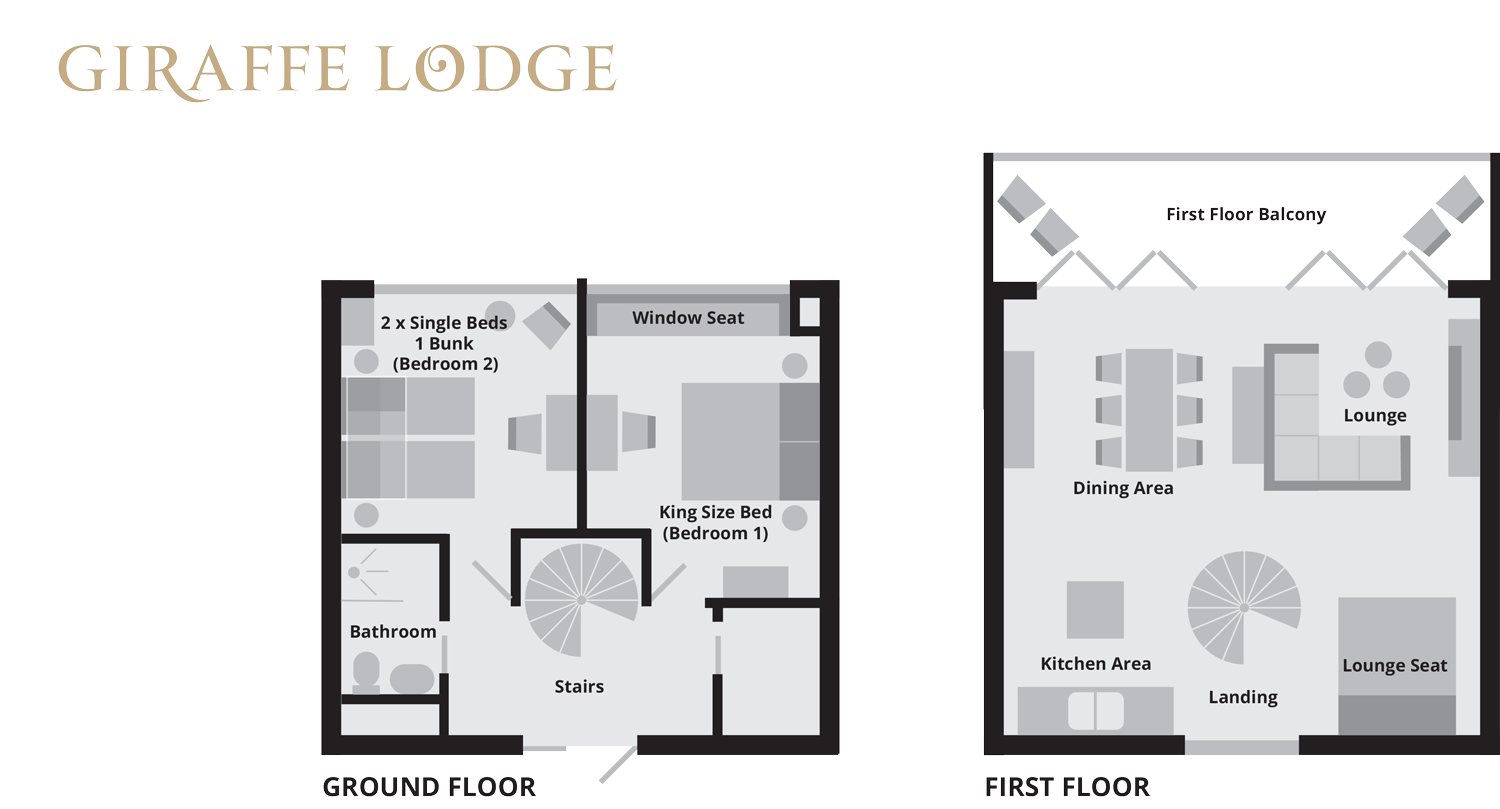
Watch the Video
From £515 per night, based on 2 guests. Additional guests : £185 per adult per night £130 per child (3-15yrs) per night £ 20 per under 3 per night
REGISTER FOR THE LATEST UPDATES AND BOOKING EXCLUSIVES
Be the first to know all the latest details & availability!
- Conservation
- Accessibility
- Keep in Touch
- Privacy Policy


YOUR ADVENTURE STARTS HERE
Book Cabin .
Book Encounter .
Book Adventure .

By entering this park. You agree that all photographs and video taken during your visit will be for personal use only and not for commercial purposes. Any photos taken on our property may not be used for marketing purposes.
Learn About Our ConservationEfforts .
4229 US-150 W, Paoli, IN 47454
[email protected] // 812-936-4484
Proudly created by: fuhscreative.com
- Help Center
- Plan Your Visit
- Places to Stay
- Youth Programs
- Student & Youth Groups
- Dining Programs
- Events & Catering
- Live Cameras
- Our Mission
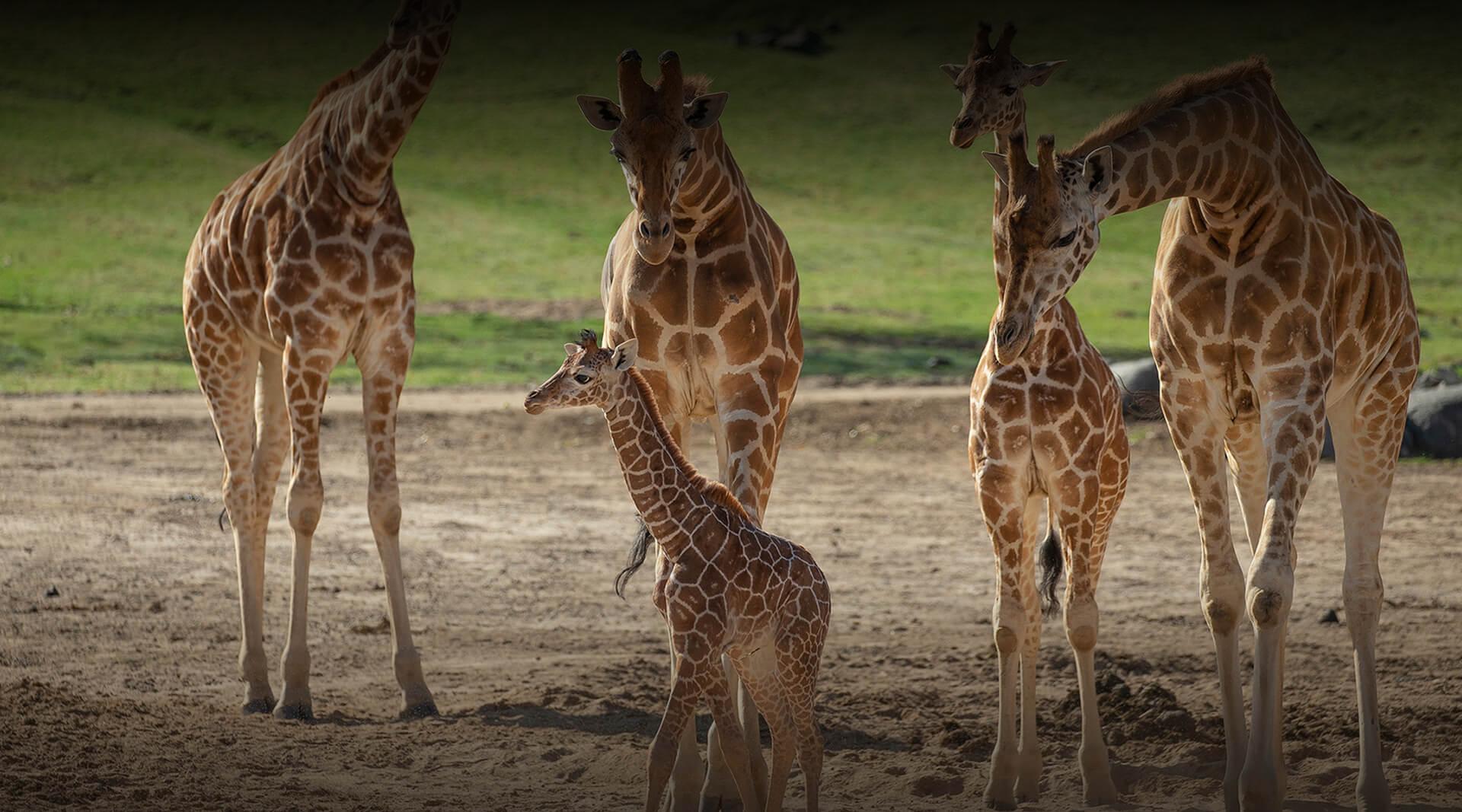
Cams at the San Diego Zoo Safari Park and San Diego Zoo.
*Wildlife may not be visible on the cam if they are in their bedrooms or out of camera frame.
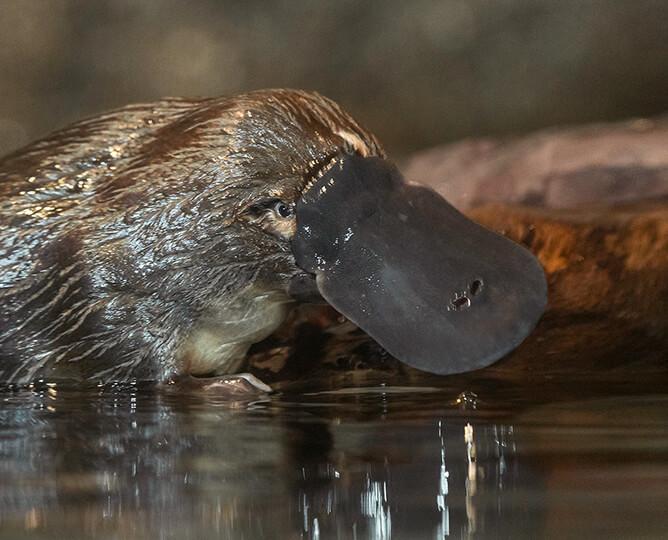
Platypus Cam
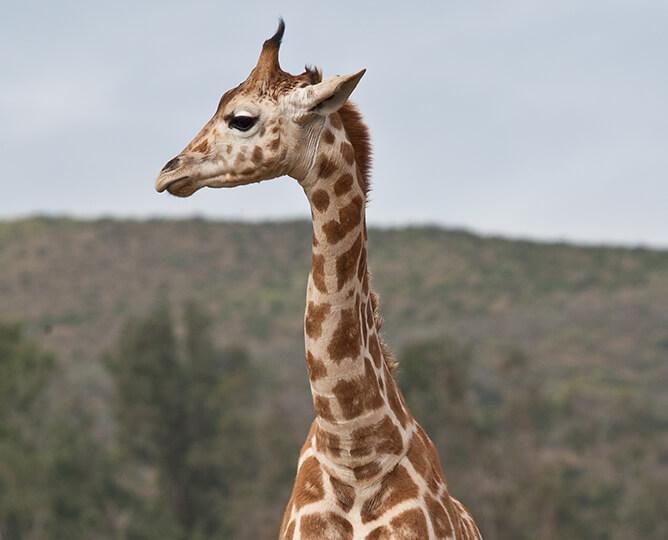
Giraffe Cam
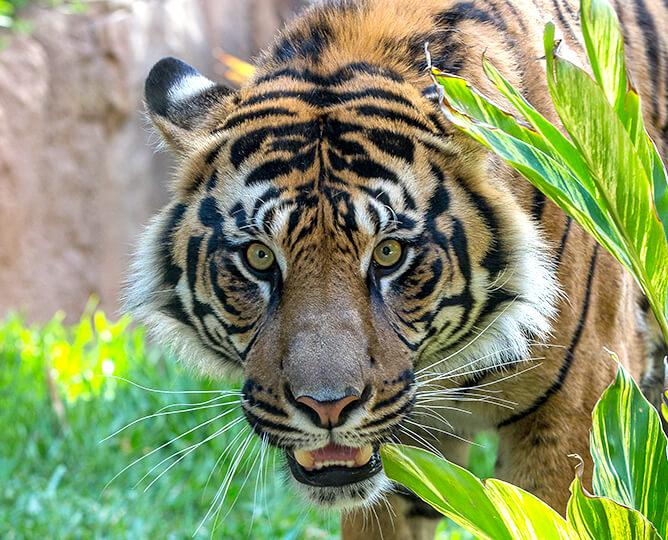
Burrowing Owl Cams
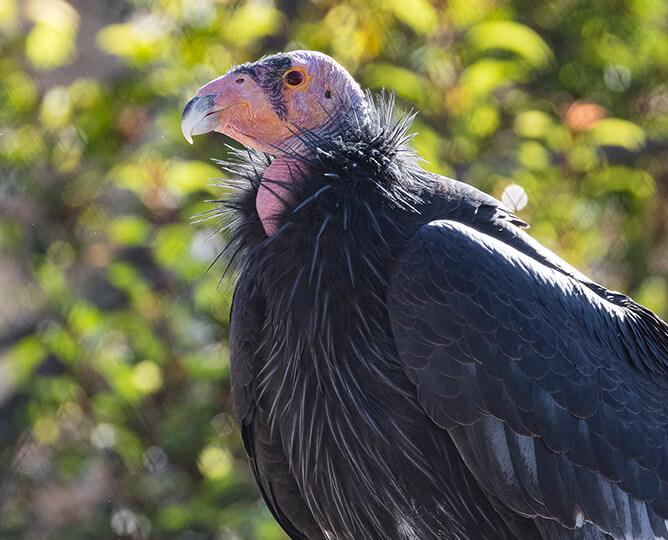
Penguin Cam
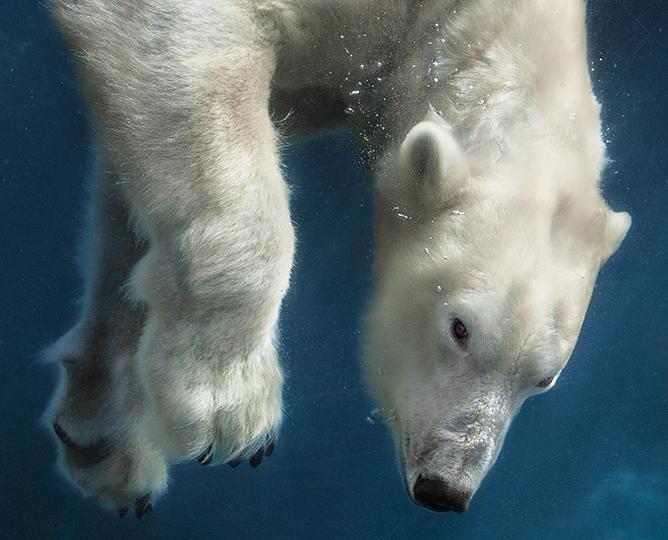
Elephant Cam
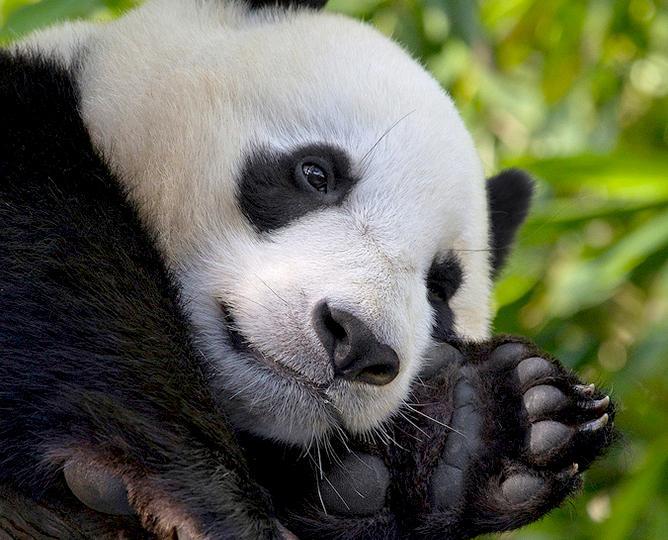
Red Panda Cam

Celebrate everyone who means mom to you

PREFERRED HOTELS

Picture Your Special Day at the Park!

This Botswana safari offers these things others in Africa don’t
Home to some of the best animal-spotting sites in the world, Justine Gosling finds safari in Botswana is a slice of paradise
His name was George. He made my heart flutter and I stared at him with feelings that were strangely overwhelming for a first meeting. Sadly, my interest wasn’t reciprocated. Completely ignoring me and with his back turned, George, camp Duma Tau’s resident 1,500kg Hippo, wallowed in the delta’s shallow water just meters from the platoon I was standing on.
George was the first animal I saw on my multi-camp, luxury @ wearewilderness safari in Botswana, and my feelings of surprise and awe just minutes after our arrival set the tone for the rest of our safari. Situated in the Linyanti private concession, Duma Tau – meaning ‘roar of lion’ in Setswana – was my first camp, and by the end of my first day, I understood how it got its name.
Soon after our arrival, still dizzy from meeting George, I headed out on my first drive with my guide, ‘Taps.’ He told me a little of what to expect, and the benefits of being in a private concession. Firstly, only one safari company operates in the area, so I could expect to have the area to myself and could forget the horror stories of 30 trucks gawping at a single lion. Secondly, I didn’t have to stick to a circuit track, as safari’s often do, I could go off road to track the wildlife. I’d been out a couple of hours when Tap’s spotted antelope fleeing across the river, followed by a female lion. He shifted gear and told me to ‘hold on’. With this, he spun the truck around and sped along the track through the thick bush parallel to the river, to hastily reach a safe crossing point to track the lioness, who he thought might be heading back to her cubs.
Roaring with laughter at the thrill of the cross-country chase, the truck leapt out of the bush and suddenly all was calm as it entered the water, seemingly swimming through. That was surprise number one: safaris are as much about the enjoyment of off-road driving as they are about the wildlife. I loved the borderline reckless driving through terrain that would destroy your average car.
Read more: Best of travel: South Africa’s finest nature reserves and safari
THE LION’S ROAR
We caught up with the lazing lioness on the riverbank; she didn’t acknowledge our presence, even as we pulled up mere meters away. Every hair on my body stood on end as she called her mate using her whole body to make the deep, dry rumble. Still holding my breath, I watched the grass a meter from her face blow away as the call left her mouth. That was surprise number two: I never expected to get so close to an apex predator. As the sun began to set in an explosion of pink, I parked up and took a moment to appreciate the last moments of the day, a sort of unexpected meditation.
I was silent, but all around I could hear baboons yelp, frogs croak, birds twitter and the distant trumpet of an elephant. These meditative moments were frequent, when no words could adequately describe what I was seeing or feeling. I simply sat in silence in awe of the surrounds, grateful to be here. Back at camp I sat around the floating fire pit with a gin and tonic listening to the chorus.
I tried to estimate the number of animals in some of the huge wildebeest, zebra and elephant herd. They easily numbered into the hundreds and had surrounded me
I didn’t sleep much that first night and excitedly leapt out of bed at 5am for more. After recovering from being trumpeted at by a passing elephant that left me gasping, I took coffee standing by a pool occupied by 30-odd hippos, the world’s most deadly land mammal. Even the helicopter transfer flight to our next camp, Vumbura plains, was a safari experience, with huge herds of elephants and giraffe spotted meandering in the tributaries of the Okavango delta. The family of warthogs loitering under the open walled toilet hut even made the comfort break memorable.
All the camp buildings are open-walled to make the most of the views, except for a safety mesh to keep out the bugs in the villas (another surprise was the lack of annoying insects). My huge room had double bathroom sinks, a sunken lounge and outside shower.
IN PURSUIT OF WILD DOGS
A trip highlight was a high-speed hunt of the critically endangered African dogs. Despite watching a pack of them ferociously devour a helpless Impala – hearing every bone crunch – they managed to look cute throughout the ordeal, with their happy ‘yelps,’ wagging tails, saucepan sized ears and patchwork coats of red, brown, black and white. The butchery did not put me off my surprise BBQ lunch, set up by staff in the shade of a kharari apple leaf tree. My last camp, Qorokwe, which borders the Moremi Game Reserve, was all about the mega herds.
Read more: This Norfolk safari is hands down the county’s best attraction
In the natural pool back at the lodge, I tried to estimate the number of animals in some of the huge wildebeest, zebra and elephant herd. They easily numbered in the hundreds and had surrounded me in another moment of awe. Just like the pack of snoozing cheetah I had spent time with, an afternoon nap became my routine too, with the early starts and nighttime hippo raves outside the room necessitating a midday recharge. Another surprise – don’t expect to sleep much on safari!
The excitement continued right until the end of the trip. I had to clear the runway of a pair of wayward giraffes, two ostrich and an antelope so that the plane could safely land to fly us back to Maun. I never expected to laugh so much, to feel such peace, to experience so many moments of awe, surprise and trepidation. Perhaps there shouldn’t have been any surprises, though: after all, this is nature at is most wild, made all the more magical by the exceptional hospitality delivered by the wilderness staff.
Visit the Wilderness Vumbura Plains safari yourself
Prices at Wilderness Vumbura Plains at start from $1,850 per person, for two people sharing; at Wilderness Qorokwe from $1,480 per person for two people sharing and at Wilderness DumaTau from $1,750 per person, based on two people sharing .

- Things to Do
- Restaurants
- Vacation Rentals
- Travel Stories
- Rental Cars
- Add a Place
- Travel Forum
- Travelers' Choice
- Help Center
A great National Park experience - Kenya Tours And Safaris
- Africa
- Kenya
- Nairobi
- Nairobi - Things to Do
- Kenya Tours And Safaris
A great National Park experience
I booked this tour late Saturday for an early Monday morning start and received instant confirmation from Viator but had to hunt around across apps to find a WhatsApp contact as I don’t have a local phone. Once I located this, I was able to communicate directly with travel operator and from there on it was smooth sailing. My guide Watson called me on Sunday night to confirm pickup arrangements and was waiting at the gate to the apartment block as agreed and I felt so at ease with him all day even though I was the only traveller. I really appreciate that the company kept the commitment with just 1 booking. It has been very wet in Nairobi and many roads in the National Park were flooded or inaccessible in the safari van but Watson was a safe driver and used his own considerable local knowledge and talked to guides and others in the park to see as much as possible. We arrived at sunrise which was stunning and almost immediately saw rhinos. During our time in the park we saw most animals surprisingly close up (good viewing through the pop up roof) except for the cats even though Watson did his best to find them. I enjoyed David Sheldrick Elephant Orphanage and the giraffe centre as well. There was an unexpected stop for shopping at a women’s foundation which does beads and leather work. The local lunch was nice. As it was a long day with an early start we didn’t go to the Karen Blixen Museum. All entry fees were extra but this tour maximises your national park entry fee as you would have to pay it twice if you went to the elephant orphanage on a different day.

We're thrilled to hear about your fantastic experience with us in Nairobi! From seamless booking to personalized communication, we strive to make every step of your journey smooth and memorable. Watson's expertise and dedication ensured an unforgettable safari despite challenging conditions. Witnessing sunrise and encountering wildlife up close must have been incredible! Thank you for choosing us for your Nairobi adventure, and we look forward to welcoming you again soon!
It was our first time visiting the national park and we had a great time. In particular, Watson was a fantastic tour guide. We highly reccomend both tour and guide.
Hello, We're thrilled to hear you had a fantastic time on your first visit to the national park! Watson is indeed an exceptional guide, and we're delighted he made your experience memorable. Thank you for recommending both the tour and our guide. We look forward to welcoming you back for more unforgettable adventures in the future!
Watson was our guide we glad him for the great safari. Even in rainy season we have seen rhinos, buffalos and lion in Nairobi NP.
Hello, Thank you for choosing our safari tour! We're thrilled to hear you had a fantastic experience with Watson as your guide, even during the rainy season. Nairobi National Park is truly remarkable, and we're delighted you got to witness rhinos, buffalos, and lions in their natural habitat. We hope to welcome you back for another unforgettable adventure soon!
The tour was really great! The park allows you to see many animals; we saw lions, giraffes, zebras, monkeys, impalas, buffalos, rhinos, hippos... At the Sheldrick Wildlife Trust you can see baby elephants up close and support a really lovely cause of conservation. The van was in really good conditions and the place we had lunch was nice. Our tour guide Watson, was extremely friendly and knowledgeable and he was really invested in us getting the best possible views!

We're thrilled to hear you had an amazing experience on our safari tour! From lions to hippos, our park showcases Africa's magnificent wildlife. Visiting the Sheldrick Wildlife Trust adds a heartwarming touch, allowing you to support elephant conservation up close. Our top-notch van and scenic lunch spot ensure a comfortable journey. Watson, our passionate guide, goes above and beyond to ensure you catch the best views. Thank you for choosing us for your safari adventure. We look forward to welcoming you back for more unforgettable experiences in the future!
The tour was excellent. Watson our guide was knowledgeable about the animals. We saw many animals and most of them were in groups which gave us a chance to see how they interact with each other.
We're thrilled to hear that you enjoyed the tour! Our guide Watson is indeed exceptional, and we're proud of the knowledge and expertise he brings to each excursion. Observing animals in their natural habitat, especially in groups, offers a unique insight into their behavior and social dynamics. Thank you for choosing our tour, and we hope to welcome you back for more unforgettable experiences in the future!
The experience was amazing, our guide was Watson, he picked us up from the hotel and the first stop was Nairobi National Park, it was incredible. In Nairobi National Park we saw lions, zebras, giraffes, rhinos, crocodiles, buffaloes, hippos, gazelles, ostriches, Watson was explaining everything about the park, we spent about four hours. After the park we went to the elephant orphanage, we saw how the caregivers gave them the bottle and tell you the story of each animal because it is in the recovery center, highly recommended. The next activity was to take us to Kobe, a center that helps Maasai women, they showed us their workshops and made us a dance. Then they took us to eat at a typical place in Nairobi and the last activity was the giraffe center where we could feed them. After all this great day, Watson left us back at the hotel. Highly recommended guide! And the plan was exceptional

Delighted you had a fantastic time with Watson! Nairobi National Park's wonders, the elephant orphanage's heartwarming stories, Kobe's cultural immersion, and giraffe feeding made for an unforgettable day. We're thrilled you enjoyed every moment. Thank you for choosing us, and we'll be here for your next adventure!

Safari Tours

Take a Tour of a Wildlife Safari Zoo in Central Pennsylvania
Guided safari tours in central pennsylvania.
The dry plains of Africa and the woodlands and forests of Australia have never felt closer thanks to the incredible safari tour at Lake Tobias Wildlife Park. Like our other amazing attractions , the safari allows you and your family to see first-hand the various animals native to those lands and learn about their natural habitats. Discover more about our animal safari in Central Pennsylvania and all you can expect to see on your journey.
Guided Safari offered May thru October.
Self Drive-Thru Safari Available Only in April and November
Guests who wish to enjoy our safari tour from the comfort of their vehicles can do so with our self drive-thru option. VEHICLES WITH HARD DOORS AND HARD TOP ROOFS ONLY. Those interested in this experience should first read the Self Drive-Thru Rules to ensure their safety and the wellbeing of our animals. You will be required to sign a vehicle waiver prior to entering the safari fields.
SELF DRIVE-THRU RULES AND INFORMATION PER USDA:
All vehicles MUST have hard tops and doors. Sunroofs and trunks must be closed-USDA requirement (Mesh doors on jeeps are not permitted).
Strict 5 mph speed limit (USDA requirement for animal safety).
You MUST remain in your vehicle during the entirety of the tour.
Pets are not permitted in vehicles.
No riding in the bed of pickup trucks.
No motorcycles, motor homes, buses, or trailers are permitted.
Touching animals is not encouraged.
Feeding animals is prohibited.
LOUD NOISES --honking horns, music and yelling--are not permitted.
ADDITIONAL INFORMATION:
The drive-thru trail is an unpaved dirt trail with loose stones, possible animal dung, and occasional mud puddles.
Some animals may not be visible on every drive-thru.
No refunds will be given for any reason after entering the safari fields.
ZOO EXHIBITS ARE NOT AVAILABLE during the weekends of the self drive-thru.
Admission for the self drive-thru will be $9/person ages 3 through adult.
The Self Drive-Thru Safari pre-season/post-season option is available on select weekends only in April and November
from 10:00 a.m. to 3:00 p.m.
Please note: Only the Safari Tour Fields are open for the Self Drive-Thru option. Zoo exhibits are open during our regular season May 1st through October .
Adventure Awaits at Our Wildlife Safari Zoo

Say Hello to Our Animals
One of the best parts about our safari zoo in Pennsylvania is all the different animals you may see. More than 500 animals roam the safari fields freely at Lake Tobias Wildlife Park. You may meet curious critters that are just as interested in you as you are in them — it is common for animals to approach the tour bus and get close enough for guests to reach out and touch them. Interacting with these animals is sure to be an unforgettable and highly beneficial experience for your party.
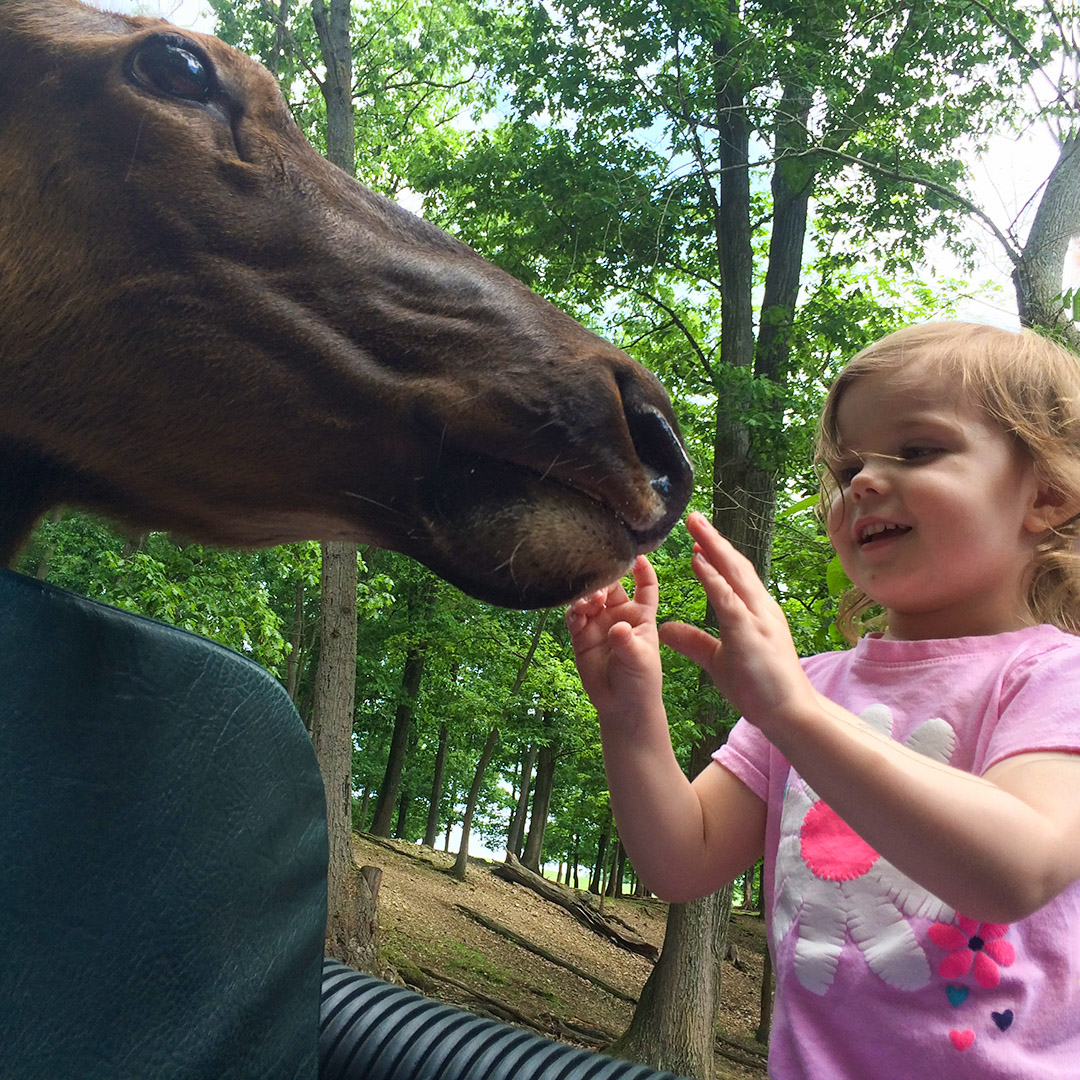
Our New Safari Station
Dedicated to providing our guests with the best possible experience, we are happy to introduce our safari station. Built and launched in 2015, the safari station includes the following:
- A comfortable holding area large enough to fit guests as they wait for their turn to hop aboard the cruiser
- A snack shop where you can grab a drink, some food for the ride, and even feed to give the animals while on the tour
- Well-maintained restrooms for your convenience
Things to Keep in Mind for Your Next Safari Tour
To help guests get the most out of their animal safari in Pennsylvania, we encourage all to be mindful of when the tours begin. Rides go out right when the park opens, and guests are welcome to come early to avoid crowds or waiting in long lines. Our tours last around 45 minutes, providing plenty of time to take in the entire tour without tiring out the youngest in your group. The last tour departs our Safari Station one hour before closing.
Please be advised that we do not accept reservations for our tours as they are offered on a first come, first serve basis. However, even if you miss your preferred time, another is coming up shortly!
Plan Your Visit Today to Our Safari in Pennsylvania
Lake Tobias Wildlife Park welcomes guests from Central Pennsylvania and the surrounding areas to enjoy a first-hand experience with animals from six continents. Our safari tour allows visitors to witness a variety of majestic animals and gain insight into their way of life. Contact us today to learn more about our Pennsylvania safari tours and rates , or to view our park hours .
Safari Times
- Safari tours begin when the park opens.
- Tours last approximately 45 minutes.
- Last tour goes out one hour before closing.
- Tours are offered on a first-come, first-serve basis and depart multiple times per day.

Attractions
Zoo Exhibits
Petting Zoo
Reptiles & Exotics
Baby Animal Program
J.R. Tobias Museum & Education Center
Catch & Release Fishing
Dining & Food
New Giraffe Exhibit
Visitor information.
Directions/Parking
Handicapped/Accessibility
Table Reservations
Groups & Parties
Accommodations
About/History
Educational Outreach
ZooVenture Summer Camp
Affiliations
Site Map | Employees
Search LakeTobias.com

Journey from Botswana to Zimbabwe
Great elephant migration safari.
Zimbabwe, Botswana
From $9,295
Easy to Moderate
Call 1-800-368-2794 or contact us for any questions
Imagine exploring the utterly remote game lands linking Botswana's renowned Chobe National Park with the famed elephant stronghold of Hwange National Park in Zimbabwe—some 200,000 elephants roam this wild trans-frontier corridor. We'll head across rich savannas unknown to most travelers, encountering massive herds of elephants and plenty of other wildlife including lion, rare sable antelope, African painted dog, wildebeest, buffalo, giraffe, and more. Our unique and wonderfully located lodges bring all the comforts, and in Hwange, we'll visit the new sanctuary for white rhinos, a community-owned conservation success.
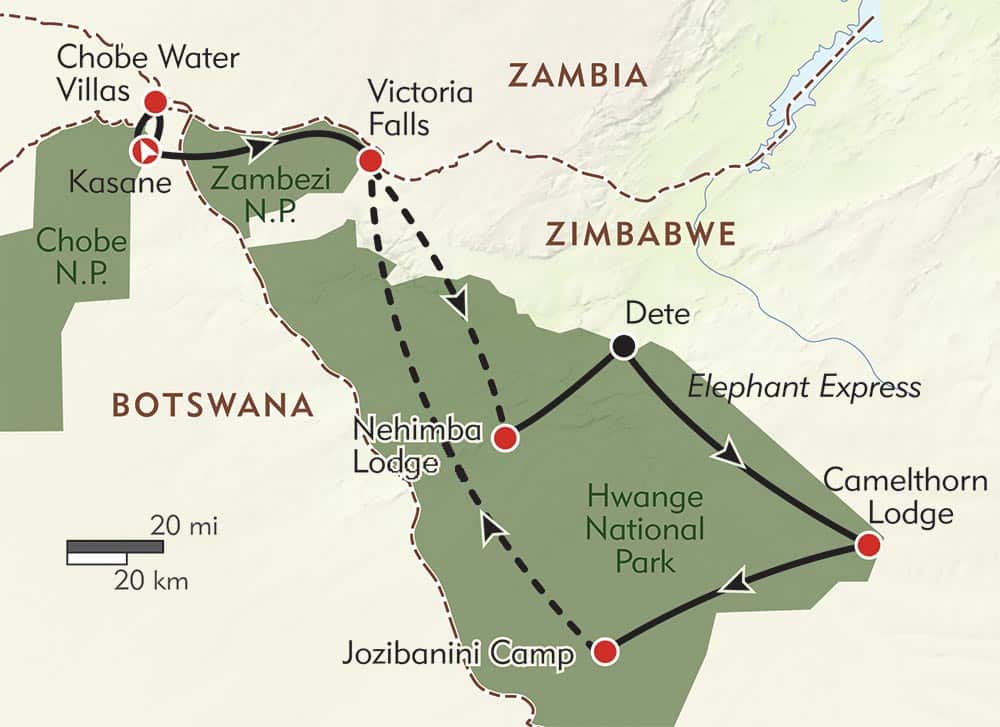
Arrive: Kasane, Botswana
Depart: Victoria Falls, Zimbabwe
- Witness huge herds of migrating elephants at waterholes
- Extraordinary wildlife, including lion, leopard, African painted dog, giraffe, roan, and kudu
- Track game on foot and enjoy optional mountain biking as part of the adventure
- Gorgeous safari camps in Hwange and Chobe, each with its own unique atmosphere
- Learn about the local community's conservation successes
- Visit astounding Victoria Falls
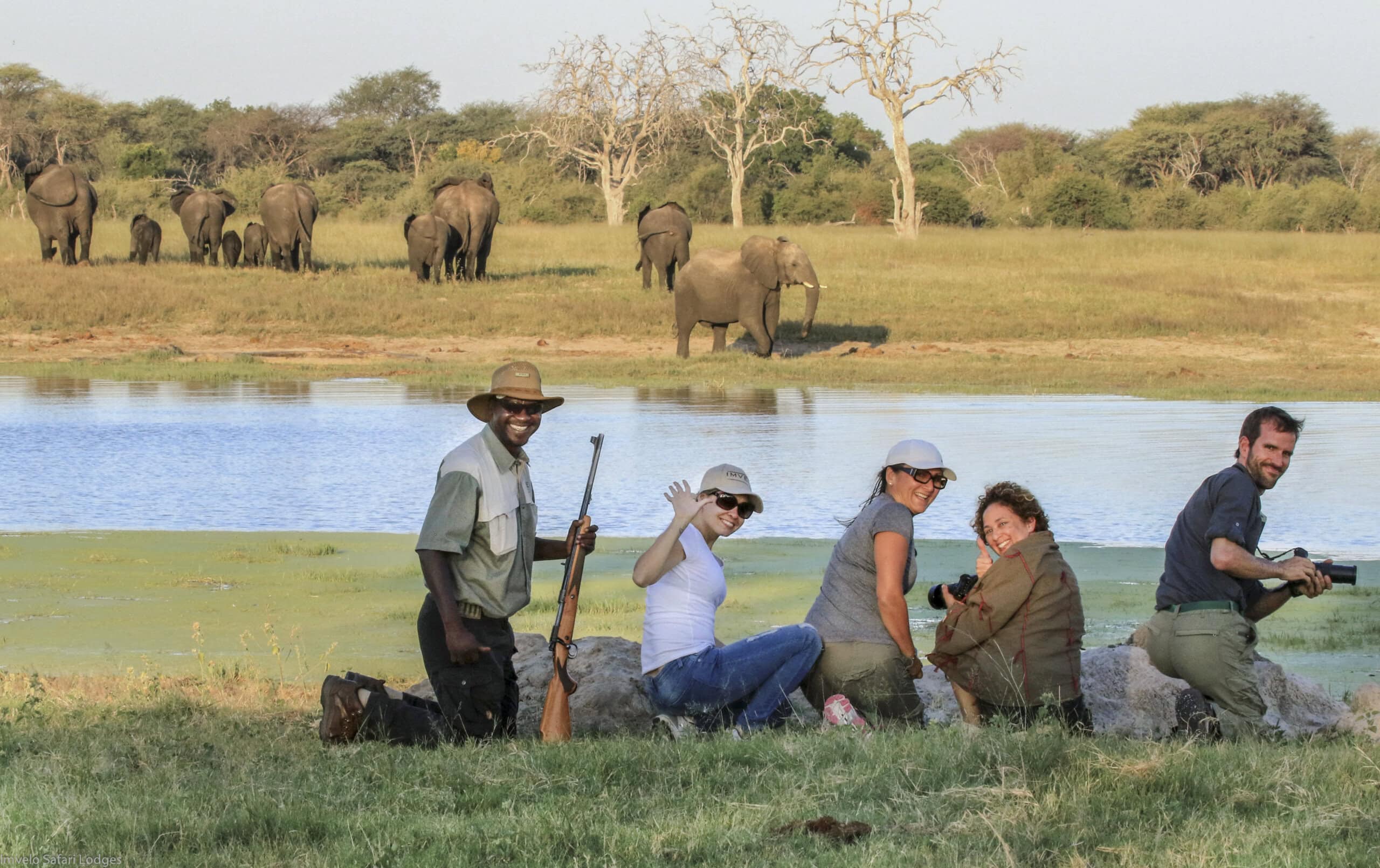
Dates & Pricing
Pricing below is per person and based on double occupancy. The earlier you book, the more choice you’ll have. WT also has the most generous cancellation and transfer policies in the industry, we make it easy if you change your mind. Have a small group of your own? Take over an existing date or choose your own. You’ll have your own private guide–and the adventure–all to yourselves!
Payment & Cancel Schedule
At time of reservation: $600 90 days prior to departure: Balance
Cancellation & Transfer Schedule
Up to 91 days prior to departure: No Charge! 61-90 days prior to departure: 25% of trip cost 46-60 days prior to departure: 50% of trip cost 45 days or less: 100% of trip cost
- Expert leadership of a Wilderness Travel Trip Leader and local guides
- Accommodations in lodges and safari camps
- Local beer, wine, and spirits
- All ground transportation and baggage handling from meeting until departure
- All activities as indicated in Detailed Itinerary
Not Included
- Travel to and from the arrival and departure locations as indicated in Detailed Itinerary
- Additional hotel nights outside the trip's scheduled dates
- Optional gratuities to Trip Leaders or staff
- Optional travel insurance
- Other expenses of a personal nature (some alcoholic beverages, etc.)
Accommodations
Scroll through our signature accommodations for this trip below. Although it is highly unlikely, we may make substitutions when necessary.
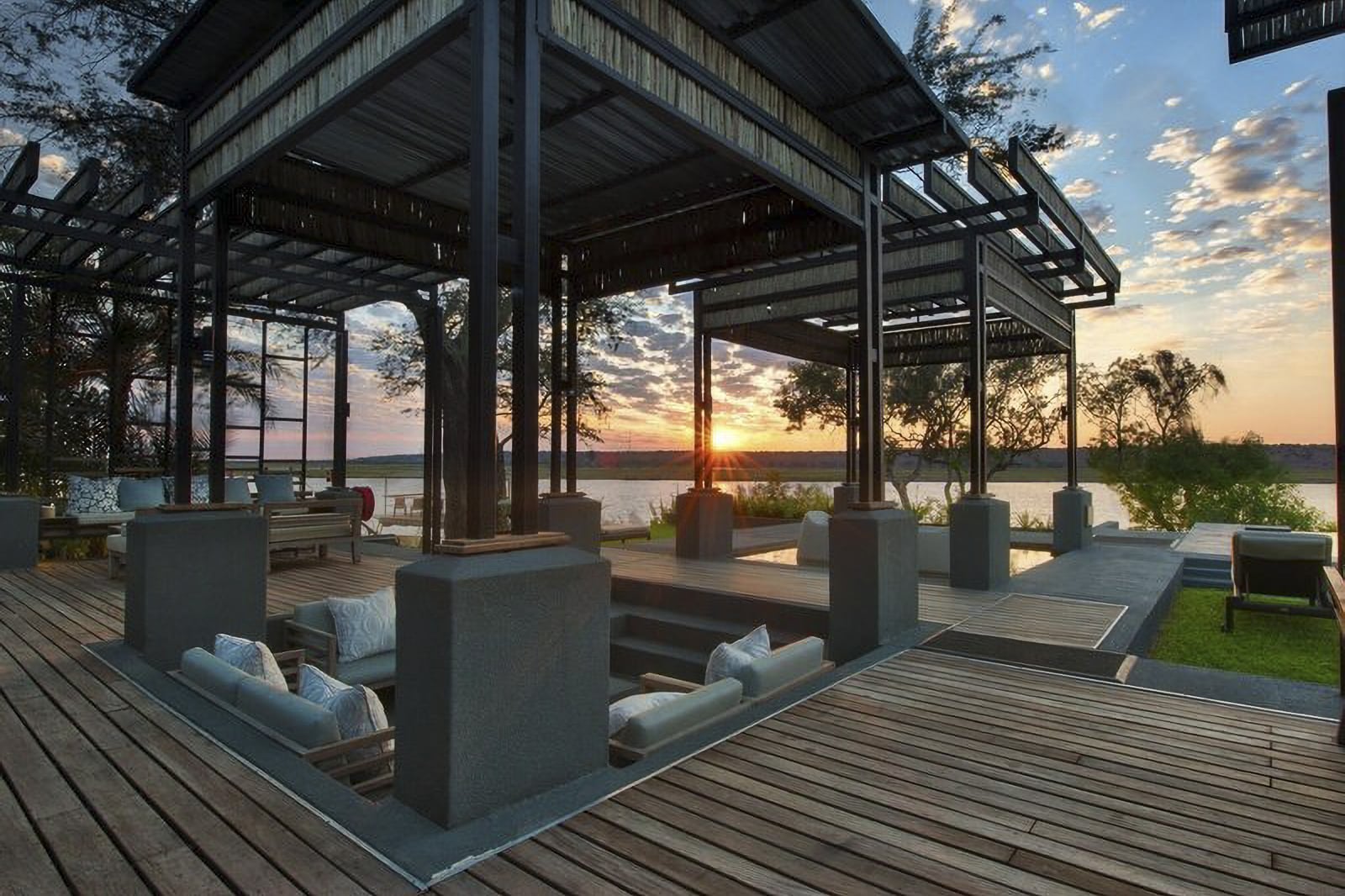
Chobe Water Villas
Kasika Conservancy, Namibia
Days 1-2 (2 nights)
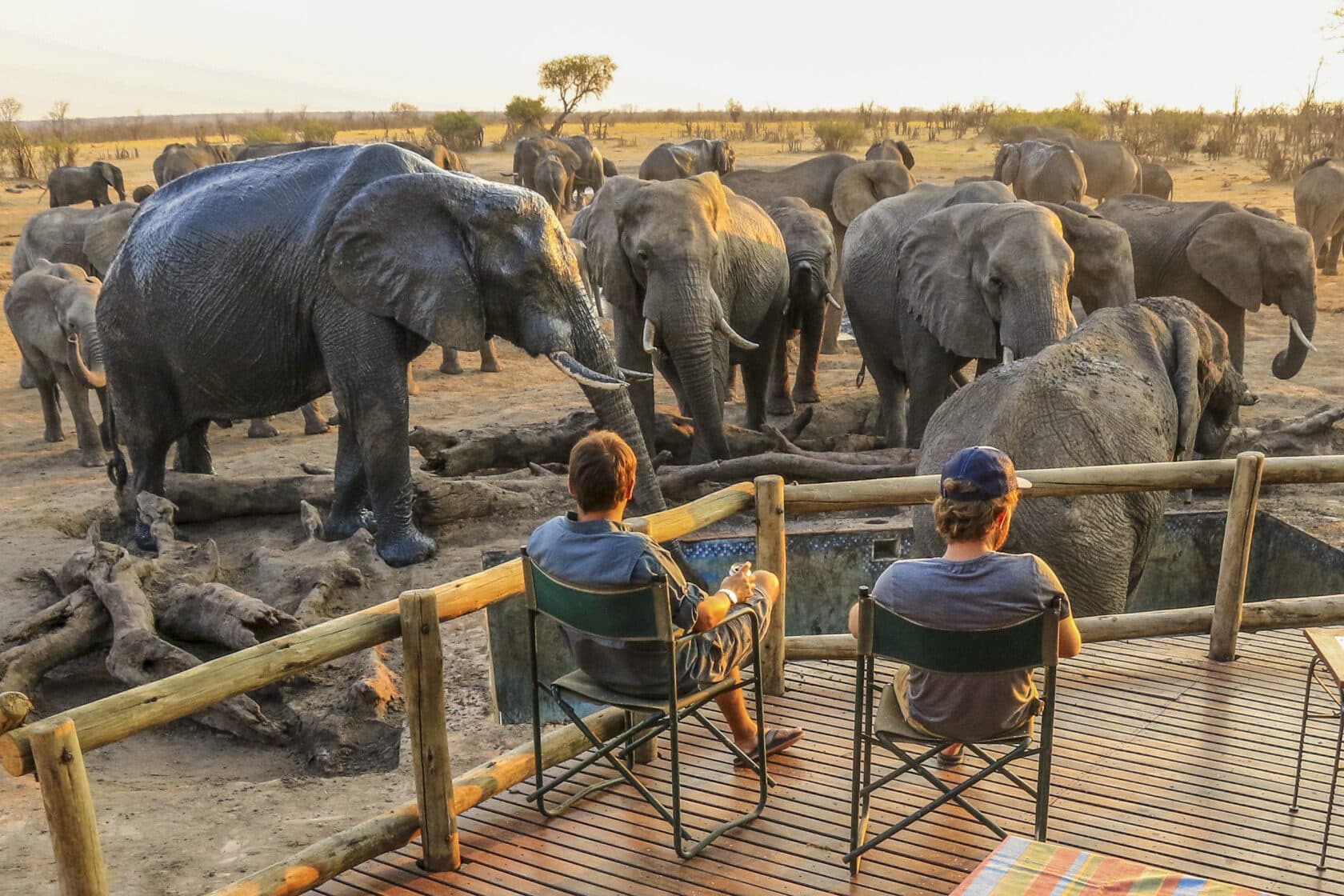
Nehimba Lodge
Hwange, Zimbabwe
Days 3-4 (2 nights)
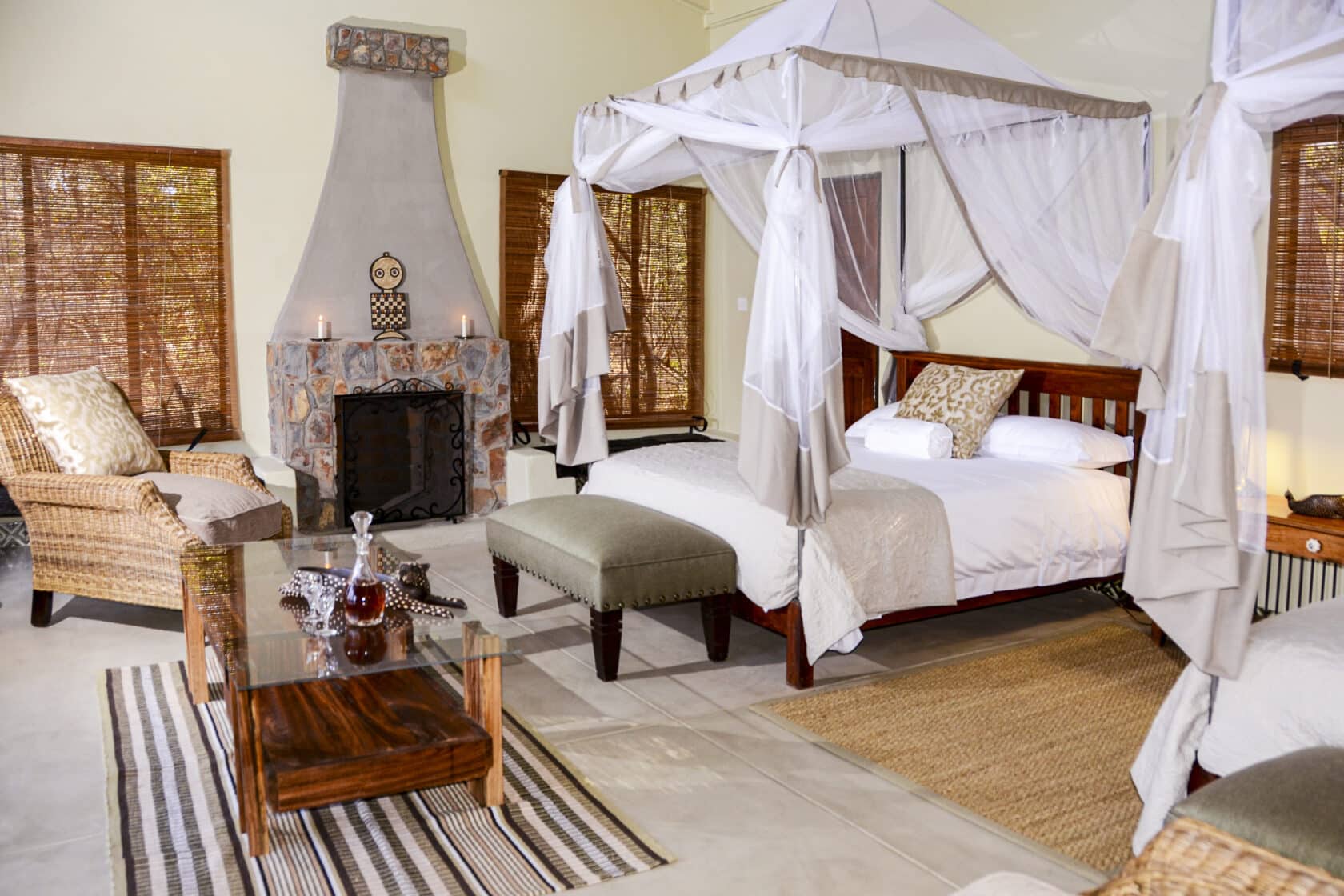
Camelthorn Lodge
Days 5-7 (3 nights)
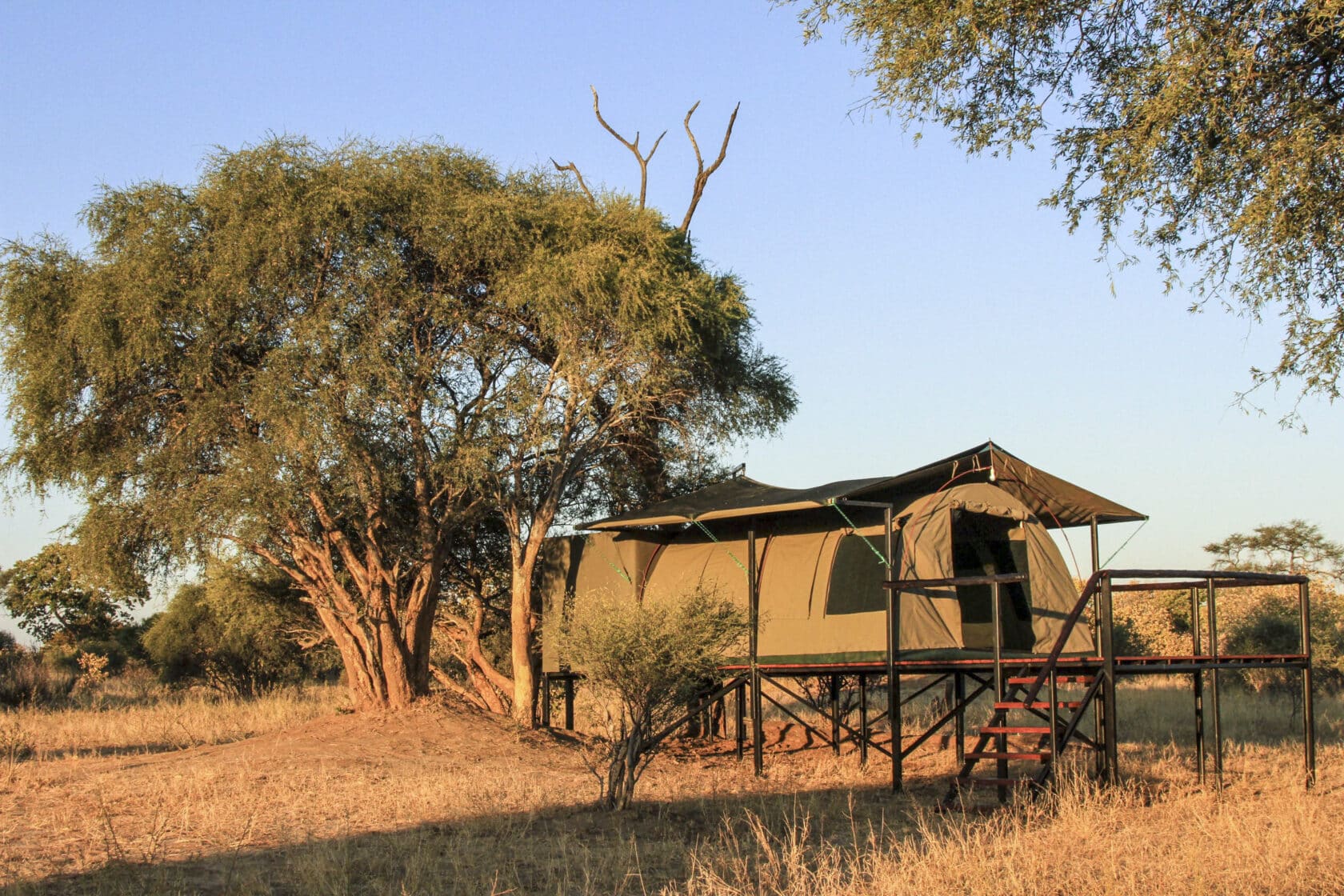
Jozibanini Camp
Hwange National Park, Zimbabwe
Days 8-10 (3 nights)
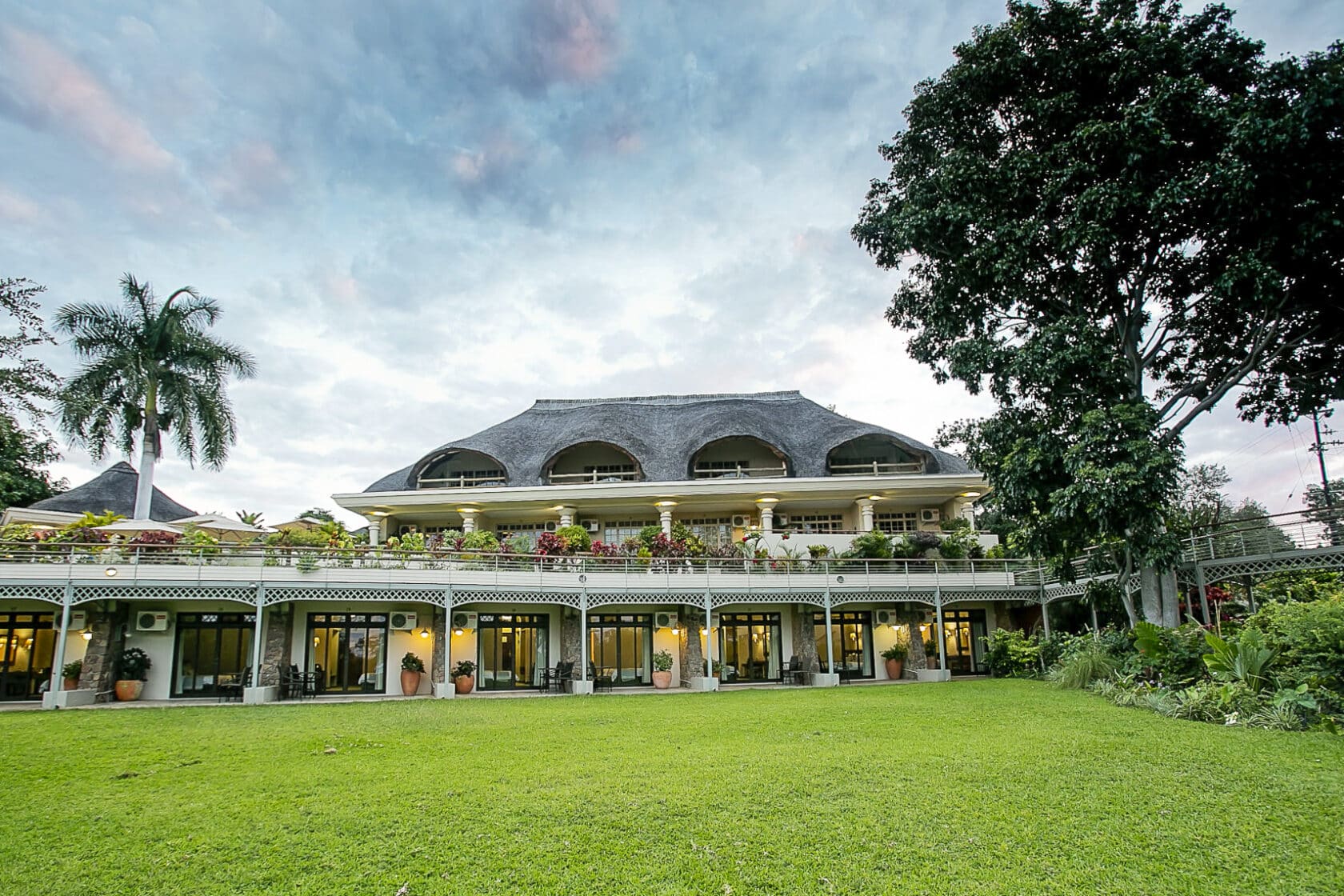
Ilala Lodge
Victoria Falls, Zimbabwe
Day 11 (1 night)
Trip Leaders
Wilderness Travel Trip Leaders have a passion and a joy for creating an unforgettable journey. We are extremely proud of them and the incredible travel experiences they make possible. For more information, including client comments about them and which specific trips they will be leading, please click on their profiles below.
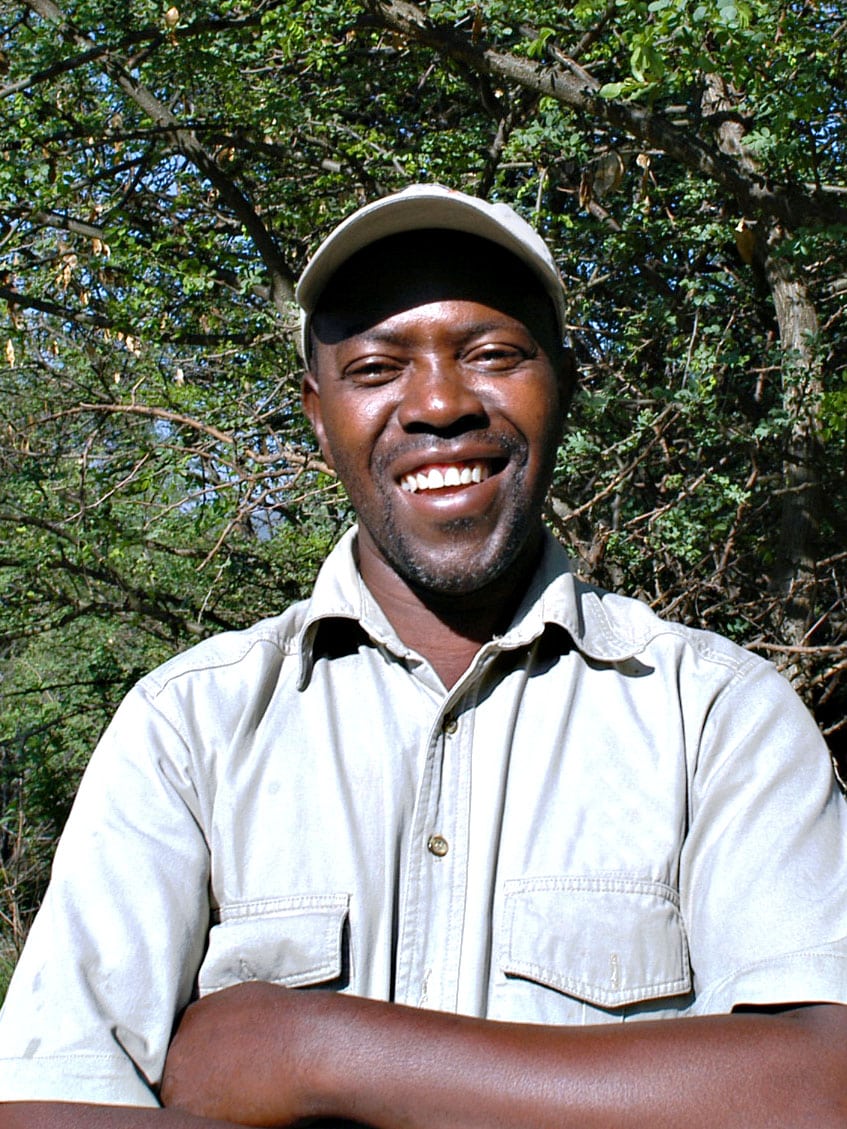
Stanley Dube

Pete Ndlovu
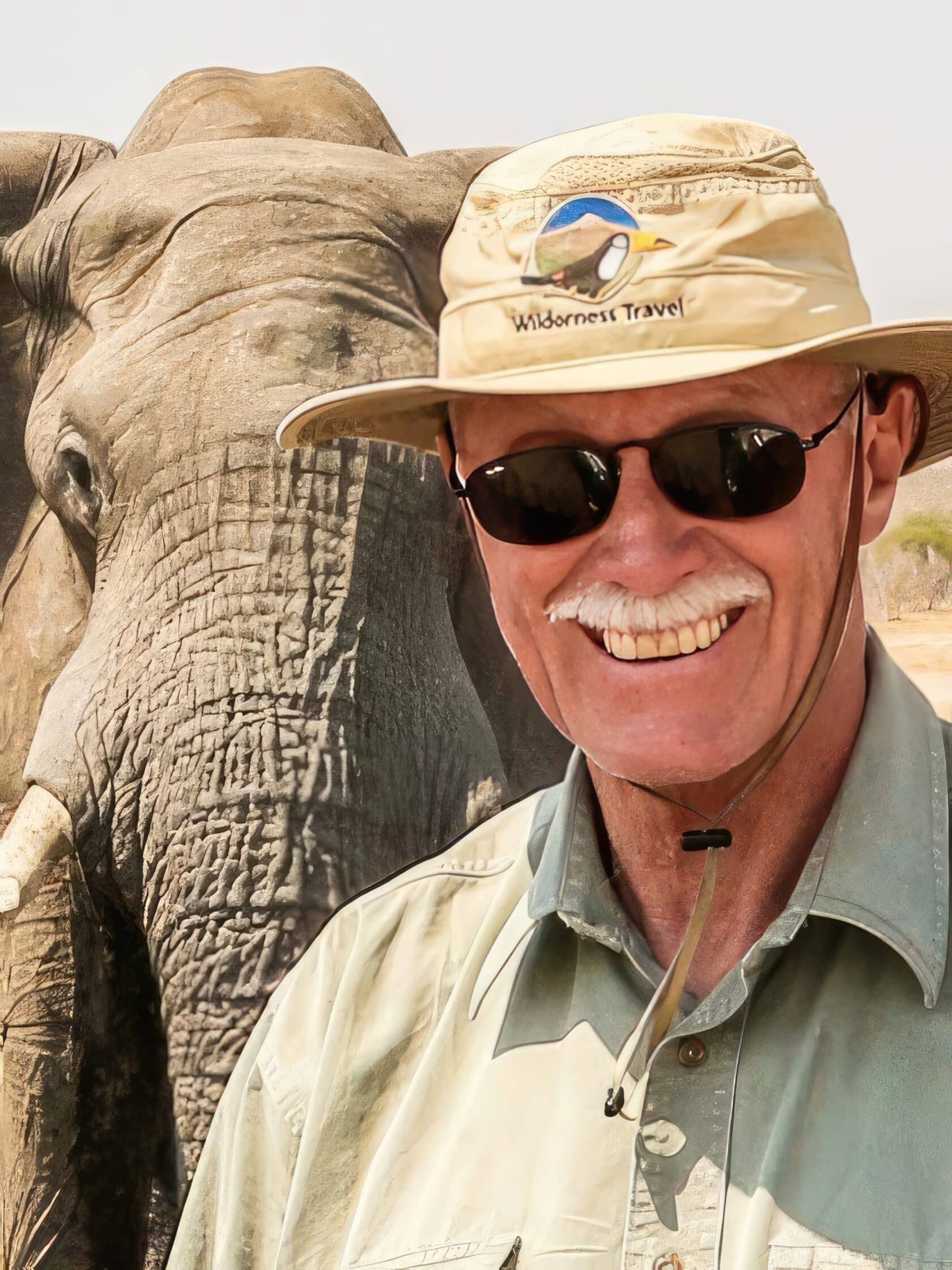
Mark Butcher
What the Trip is Like
- Flat terrain
Each of our safari lodges and camps has been meticulously designed to offer all your home comforts, a splash of luxury and an exciting dash of African charm. On top of this, our locations have been carefully selected for two vital reasons; the local communities' dedication to our conservation partnership and their proximity to some of nature's most impressive wonders, from the famous Victoria Falls, to the mighty Zambezi River and Hwange National Park, famed for its thousands of elephants.
While on safari, breakfasts and evening meals are served at the lodge you are staying in. Lunches while traveling between destinations will be served picnic-style en route. Bottled water, soft drinks, juice, house wine, and beer are included throughout the trip. All vehicles are equipped with a fridge or cool box stocked with bottled water. Tea and coffee are offered by all accommodations free of charge with meals and at afternoon teatime.
On safari, there are long driving days over rugged dirt tracks, we can be in and out of the vehicles all day long, usually only driving approximately 2 hours at a time. We will be in a 7-seat open sided 4WD vehicle with a roof for sun protection. We sit 6 people max per vehicle to optimize everyone's view and provide wool blankets for early morning and evening game drives.
During drives and game walks, we can get quite close to wild animals at times. Being very quiet improves everybody's chances of observation. In the interest of safety, your Trip Leader explains limitations on movement while on game drives, on walks, and around camp. Incidents with wild animals are extremely rare on safaris, but no safari can guarantee immunity from such incidents. Wilderness Travel is not to be held responsible for incidents involving the behavior of wildlife.
Extend Your Trip

Cape Town Extension
From $1,695
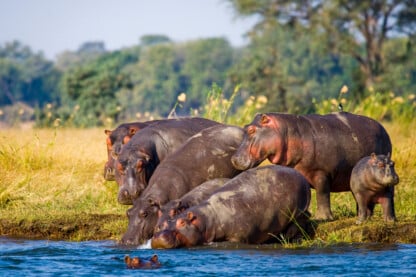
Okavango Delta Safari Extension
From $4,795
Client Testimonials
"This was the most amazing travel experience in a dozen years of travel. The nature, our elephant encounters, Butch, every camp and staff, food, and fellow travelers all made this experience amazingly fun and rewarding in every respect. Thank You!"
Evergreen, CO
"Each of the camps and lodges was spectacular in its own way. We also enjoyed the opportunity to discuss animal conservation and community with our guides, who went above and beyond at every opportunity. A tremendous experience."
Milwaukee, WI
"One of the most unique trips that I have ever taken. The interaction with elephants was amazing!"
Tesuque, NM
"The variety and amount of wildlife was incredible. As expected, tons and tons of elephants and so many babies and so close up! I loved watching them. We saw lions every day, and the first pride had at least 6 cubs. We also saw another pride eating a recent kill. What sets this trip apart is usually we were the only safari vehicle in an area. At the most, we might be in view with one other vehicle. No competition for the best viewing location."
Phoenix, AZ
"This trip was phenomenal. We could not have asked for a better experience. Every part of the trip exceeded our expectations."
Glen Allen, VA
"The trip was better than we could have imagined. Africa is awe inspiring, and Wilderness Travel put together an unforgettable trip."
"This trip was amazing in so many ways. The design of it allowed us to fully immerse in the wonders of Zimbabwe and Botswana, knowing that EVERYTHING else was totally handled (guiding, travel, lodging, food, safety)."
Redondo Beach, CA
Other Trips You Might Like
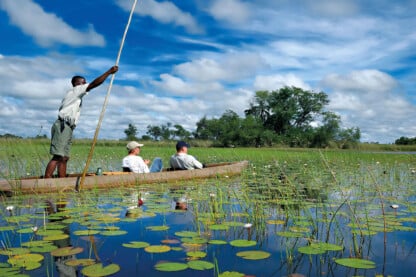
Small Group Adventure
Botswana Wildlife Safari
From $9,895
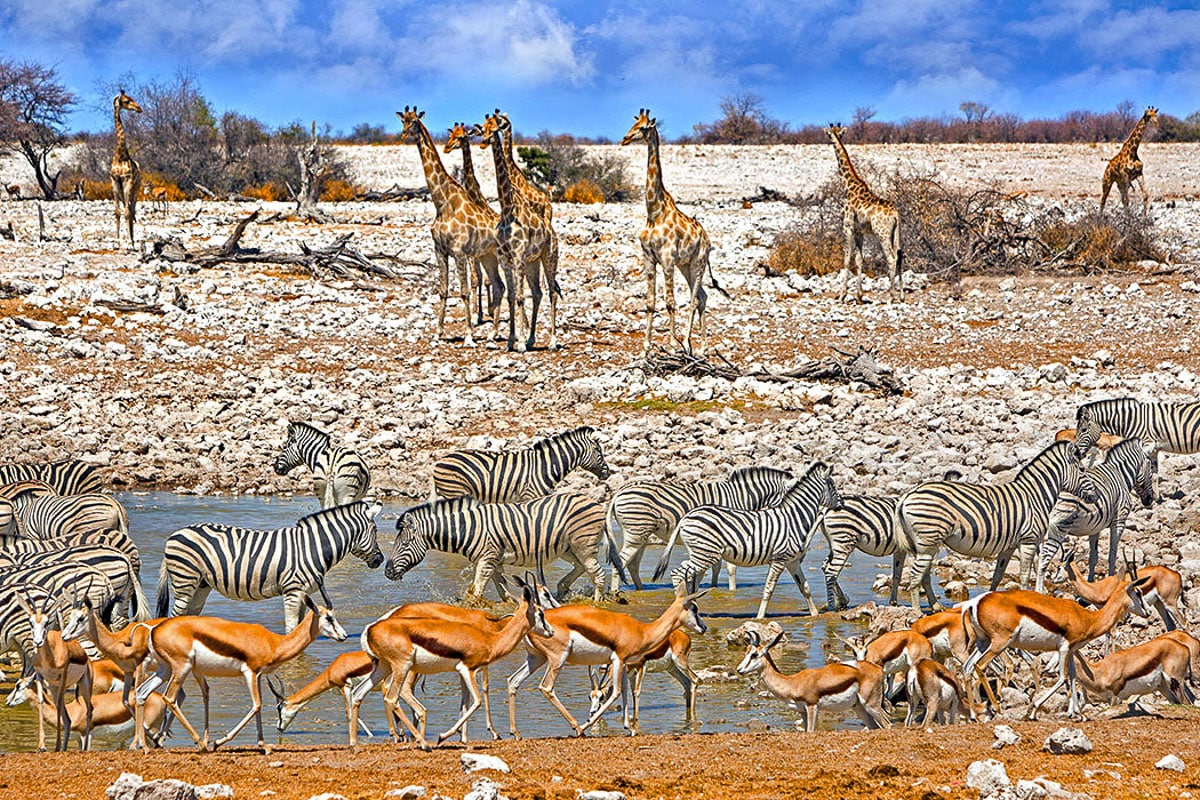
Ultimate Namibia and Botswana
Botswana, Zimbabwe, Namibia
From $11,595
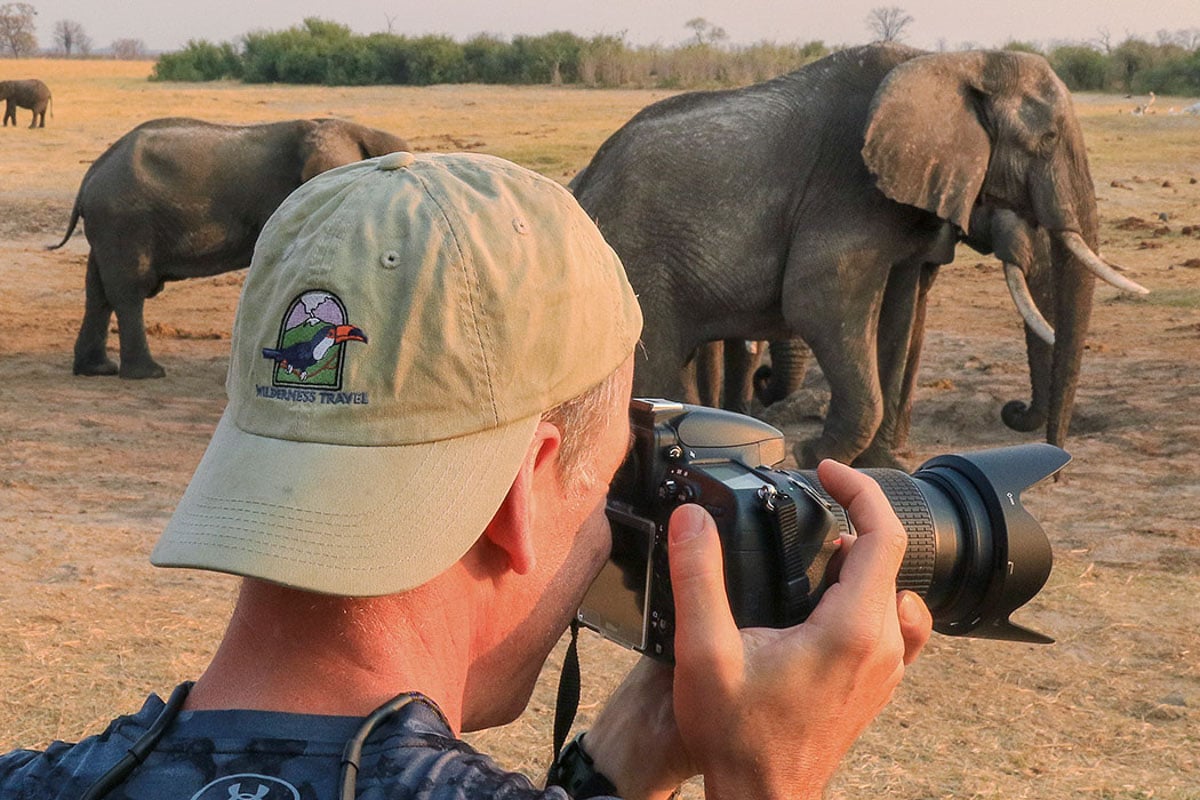
Wild Zimbabwe
From $7,795
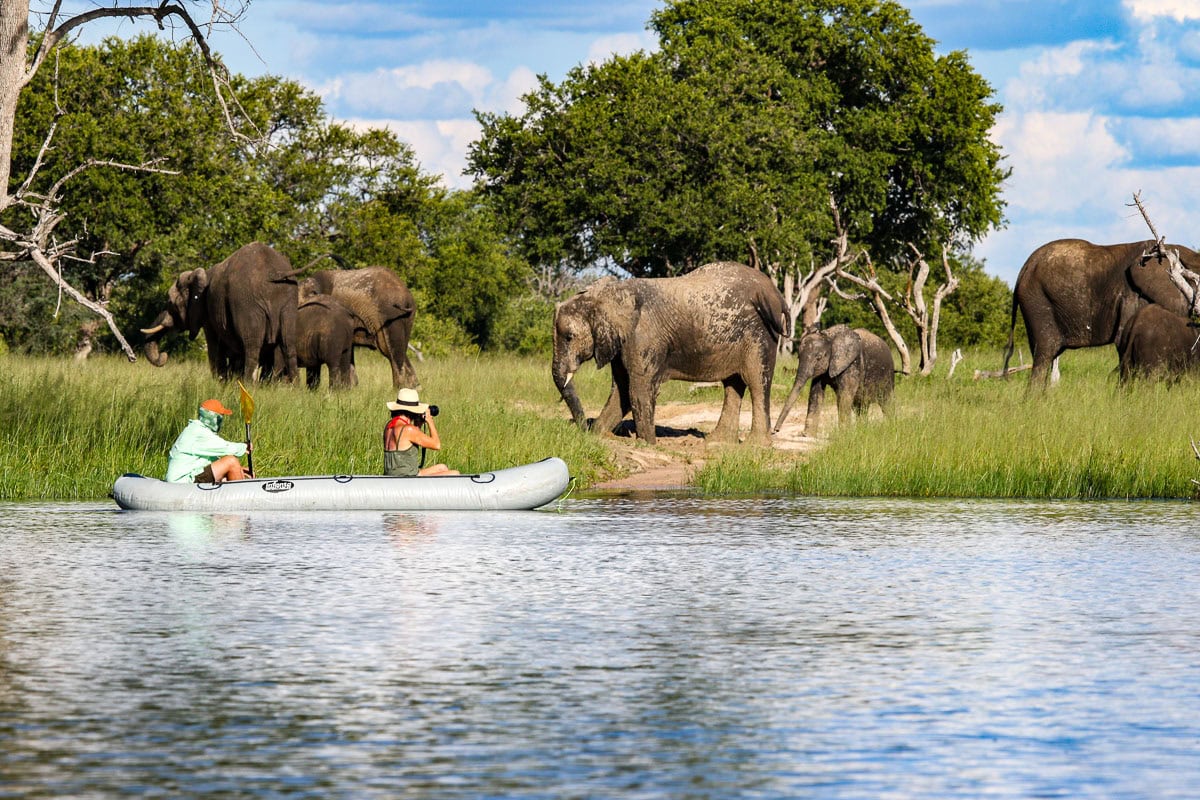
Zimbabwe: Green Season Safari
Call for Pricing
Book your trip today
Our Area Specialists know every detail about our tours. They will be happy to answer any questions and help you choose the journey that’s right for you. Contact us to learn more or book your trip today!
Submit the form below to download itinerary
Trip Download Itin
Trip Levels
With more than 200 different adventures to choose from, we want to help you find the trip that’s right for you. Our Trip Level system ranks each trip in two ways: a number rating from 1 to 6 according to the activity, and general travel rigors. 1 is the easiest and 6+ the most difficult—see descriptions below for explanations of each number. A plus (+) sign means the trip is a bit more strenuous than other trips of that level. The detailed explanation of each trip—below the bar with the number rating—is perhaps more important, specifying activities, altitudes, hiking, and travel conditions. The Detailed Itinerary, available by download or mail, gives further information. Our Area Managers can also answer questions and guide you to the trip that best suits your interests.
Level 1 – Easiest
Non-camping journeys, optional walks, little elevation gain or loss.
- Royal Rajasthan and Villages of India
- Small ship cruises
Level 2 – Easy to Moderate
Hotel nights and/or safari-style camping, hikes of two to four hours on some days. Other physical activities are sometimes included, such as optional sea kayaking.
- Our African safaris
- Costa Rica Wildlife
Level 3 – Moderate
Half- to full-day hikes (3-6 hours) over rolling countryside on most days, occasional steep trails. Many of our hotel-based walking tours are in this category, as are our snorkeling adventures.
- Tuscany & the Cinque Terre
- Argentina: Hikes and Estancias of Patagonia
- Palau Snorkeling & Sea Kayaking
- Some trips with minimal hiking but rugged travel conditions or long drives, such as Tribal Ghana, Togo & Benin, are Trip Level 3.
Level 4 – Moderate to Strenuous
Full-day hikes (4-6 hours), mountainous terrain, significant elevation gains and losses (hiking up or down as much as 3,000 feet) on many days. Altitudes no greater than about 10,000 feet.
- Ultimate Patagonia
- Hiking the Spanish Pyrenees
Level 5 – Strenuous
Full-day hikes (4-8 hours), mountainous, steep terrain (hiking up or down as much as 3,500 feet) on many days. Trips with hiking at average altitudes of 10,000 to 12,000 feet are in this category.
- Inca Trail to Machu Picchu
- Everest Lodge to Lodge
Level 6 – Very Strenuous
Full-day hikes (5-8 hours), mountainous, steep terrain (hiking up or down as much as 3,500 feet) on many days. Most hikes take place at altitudes above 10,000 feet, with some days ascending as high as 18,000 feet.
- Everest Base Camp
- Climb Kilimanjaro!

- Things to Do
- Restaurants
- Vacation Rentals
- Travel Stories
- Rental Cars
- Add a Place
- Travel Forum
- Travellers' Choice
- Help Centre
Great tour with Watson - Kenya Tours And Safaris
- Africa
- Kenya
- Nairobi
- Nairobi - Things to Do
- Kenya Tours And Safaris
Great tour with Watson
It was our first time visiting the national park and we had a great time. In particular, Watson was a fantastic tour guide. We highly reccomend both tour and guide.
Hello, We're thrilled to hear you had a fantastic time on your first visit to the national park! Watson is indeed an exceptional guide, and we're delighted he made your experience memorable. Thank you for recommending both the tour and our guide. We look forward to welcoming you back for more unforgettable adventures in the future!
Watson was our guide we glad him for the great safari. Even in rainy season we have seen rhinos, buffalos and lion in Nairobi NP.
Hello, Thank you for choosing our safari tour! We're thrilled to hear you had a fantastic experience with Watson as your guide, even during the rainy season. Nairobi National Park is truly remarkable, and we're delighted you got to witness rhinos, buffalos, and lions in their natural habitat. We hope to welcome you back for another unforgettable adventure soon!
The tour was really great! The park allows you to see many animals; we saw lions, giraffes, zebras, monkeys, impalas, buffalos, rhinos, hippos... At the Sheldrick Wildlife Trust you can see baby elephants up close and support a really lovely cause of conservation. The van was in really good conditions and the place we had lunch was nice. Our tour guide Watson, was extremely friendly and knowledgeable and he was really invested in us getting the best possible views!

We're thrilled to hear you had an amazing experience on our safari tour! From lions to hippos, our park showcases Africa's magnificent wildlife. Visiting the Sheldrick Wildlife Trust adds a heartwarming touch, allowing you to support elephant conservation up close. Our top-notch van and scenic lunch spot ensure a comfortable journey. Watson, our passionate guide, goes above and beyond to ensure you catch the best views. Thank you for choosing us for your safari adventure. We look forward to welcoming you back for more unforgettable experiences in the future!
The tour was excellent. Watson our guide was knowledgeable about the animals. We saw many animals and most of them were in groups which gave us a chance to see how they interact with each other.
We're thrilled to hear that you enjoyed the tour! Our guide Watson is indeed exceptional, and we're proud of the knowledge and expertise he brings to each excursion. Observing animals in their natural habitat, especially in groups, offers a unique insight into their behavior and social dynamics. Thank you for choosing our tour, and we hope to welcome you back for more unforgettable experiences in the future!
The experience was amazing, our guide was Watson, he picked us up from the hotel and the first stop was Nairobi National Park, it was incredible. In Nairobi National Park we saw lions, zebras, giraffes, rhinos, crocodiles, buffaloes, hippos, gazelles, ostriches, Watson was explaining everything about the park, we spent about four hours. After the park we went to the elephant orphanage, we saw how the caregivers gave them the bottle and tell you the story of each animal because it is in the recovery center, highly recommended. The next activity was to take us to Kobe, a center that helps Maasai women, they showed us their workshops and made us a dance. Then they took us to eat at a typical place in Nairobi and the last activity was the giraffe center where we could feed them. After all this great day, Watson left us back at the hotel. Highly recommended guide! And the plan was exceptional

Delighted you had a fantastic time with Watson! Nairobi National Park's wonders, the elephant orphanage's heartwarming stories, Kobe's cultural immersion, and giraffe feeding made for an unforgettable day. We're thrilled you enjoyed every moment. Thank you for choosing us, and we'll be here for your next adventure!
We were able to see the zebras, rhinos, lions, buffalos, and giraffes sooo up close. Amazing experience - and Watson is such a great guide!

We're thrilled to hear that you had such a fantastic experience on our tour! Getting up close and personal with zebras, rhinos, lions, buffalos, and giraffes is truly a once-in-a-lifetime opportunity. Watson is indeed an exceptional guide, and we're delighted that he made your journey even more memorable. Thank you for choosing our tour company for your wildlife adventure! If you ever want to embark on another unforgettable journey, we'll be here to make it happen.

- VIP TOURS TO AFRICA
- AFRICA UNUSUAL PLACES
- TOURS CATALOG
- ROVOS TRAIN TOURS
- WEST AFRICA
- GIRAFFE MANOR
- VICTORIA FALLS
- SOUTH AFRICA
- ZANZIBAR. REVIEW OF HOTELS
TOURS TO KENYA, TANZANIA, ZANZIBAR Breakfast with giraffes - where is it?
In Kenya, there is a hotel called the Giraffe Manore. We are here. Flight to Nairobi, then transfer from the airport to the hotel from 40 minutes to 1.5 hours, depending on traffic jams. After talking with giraffes, you can go on a safari in the parks of Kenya and Tanzania, and / or go on vacation to Zanzibar.
Sorry, JavaScript must be enabled. Change your browser options, then try again .
What to see
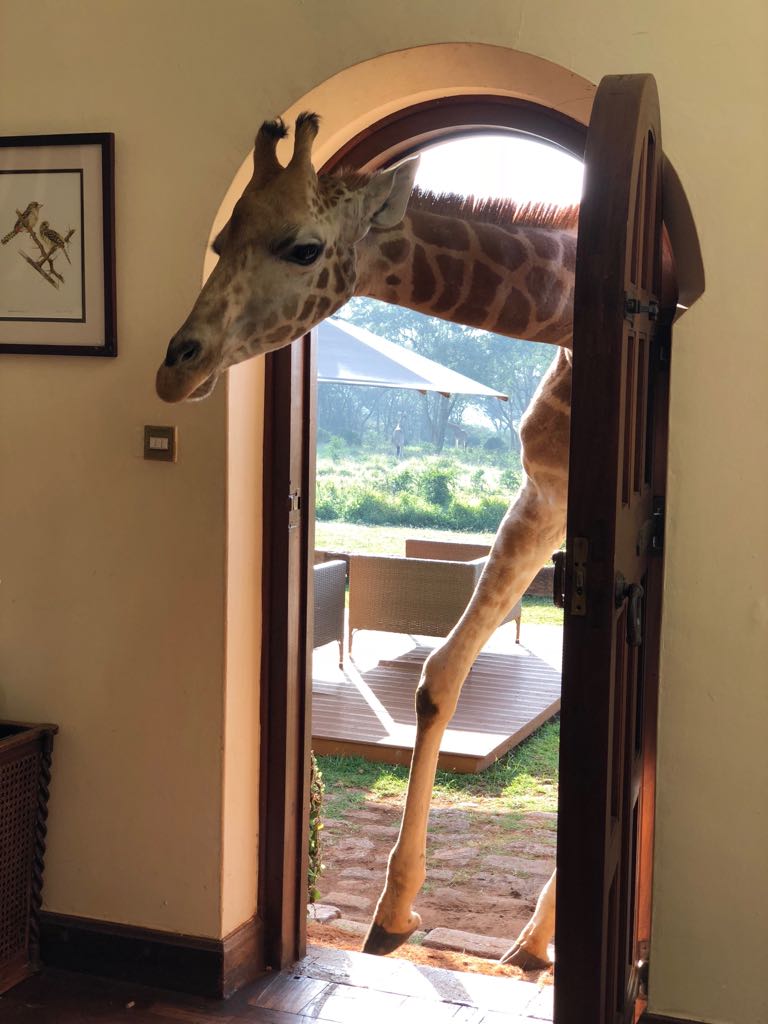
View hotel description and tours here
Is it really necessary to book hotel rooms half a year in advance? Yes, sometimes even for a year when it comes to holidays. As a rule, the hotel never has places, and this is not surprising, because there are only 12 rooms, and people from all over the world are queuing up for reservations. But that doesn't mean you shouldn't try. Contact us, we will help, it is not for nothing that we have been selling tours to Africa for 17 years, we have experience and a proven confirmation strategy.
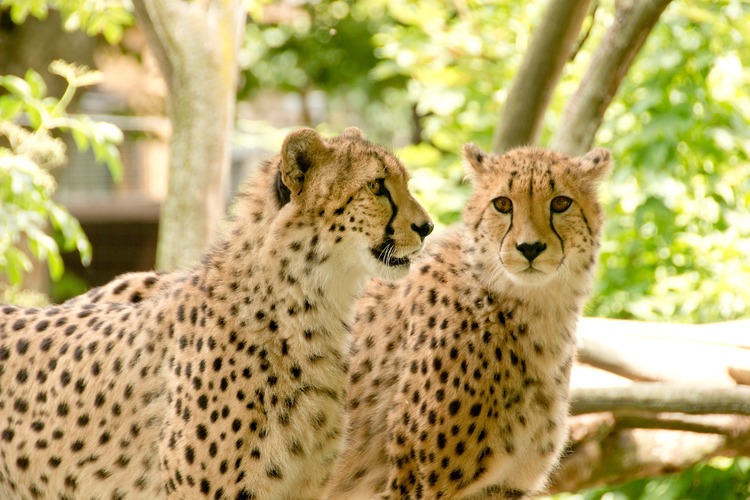
TOUR OF KENYA-ZANZIBAR: BREAKFAST WITH GIRLES, SAFARI AND REST IN ZANZIBAR Kenya, Tanzania
We invite you to an exciting journey. From the first day, everything in it will be unusual and wonderful. You can hug and, if you want, even kiss a giraffe, as you will live in a real estate, where they come for breakfast. In the famous reserve Masai Mara, you will drive through savannah on a safari, where you will meet all representatives of the Big African Five. You will spend two nights in a lodge with a stunning view of the Masai Mara valley from the height of your flight, these panoramas will remain in your heart forever. After a wild adventure on a safari in...
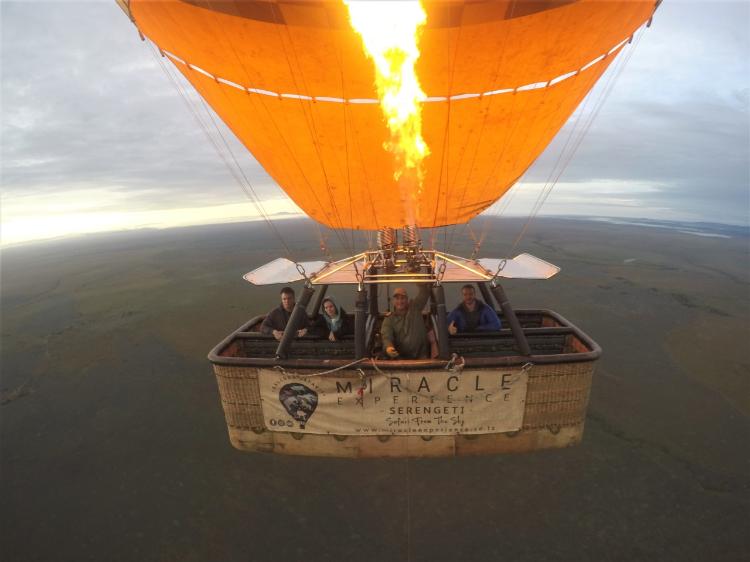
VIP TOUR TO KENYA - Aerial safari across the savannah skylines Kenya
Take a look at the grandeur and grace of nature from a bird's eye view. Some of the world's best lodges, first-class service and safaris await you. Legendary breakfast with giraffes at the luxurious Giraffe Manor. You will have the best opportunity to watch the main event...
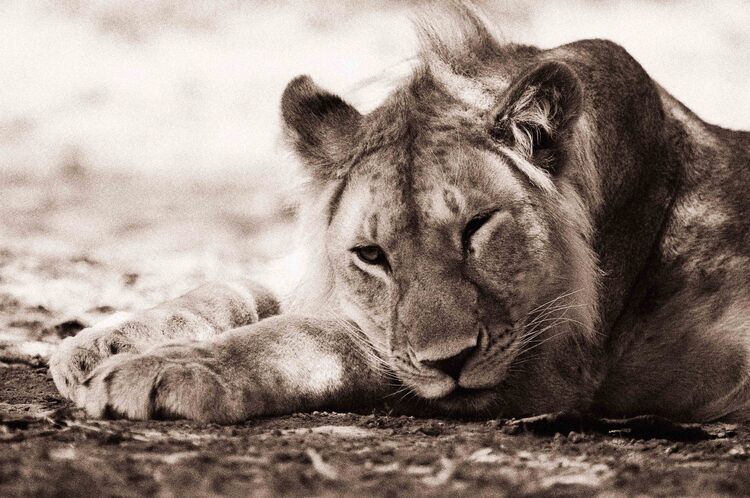
VIP TOUR: Cape Town, legendary vineyards, safaris and holidays in Zanzibar South Africa, Kenya, Tanzania
This luxury tour is for you if you are traveling to Africa for the first time and want to see as much as possible, and are not limited on budget. You think that once you fly, you will get the maximum experience and live in iconic hotels with a twist. It may have turned out that during the pandemic it was not possible to go anywhere for a long time, and now I want to catch up. It is for such clients that we have prepared this tour. Customers were satisfied, you can go!
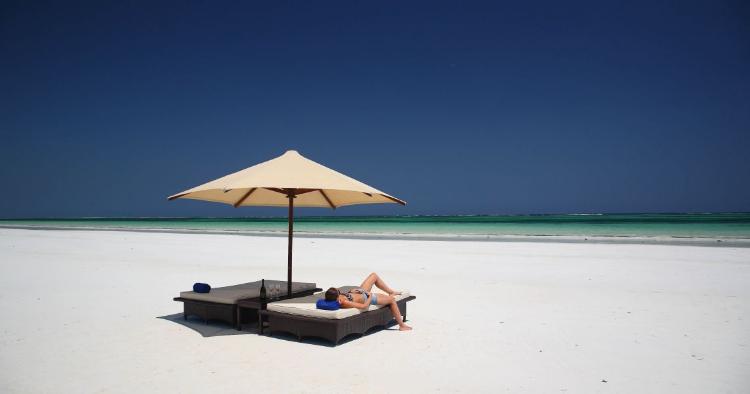
INDIVIDUAL TOUR TO KENYA: BEAUTY OF AFRICA Kenya
This tour is all about the dream of having breakfast with giraffes on your birthday. Our tourists are a married couple and this is their first trip to Africa. Why Kenya? Well, first of all for the sake of a dream. Secondly, tight deadlines for safari and ocean vacations and budget limits. Therefore, the choice fell on the route from Nairobi to Mombasa through the parks...
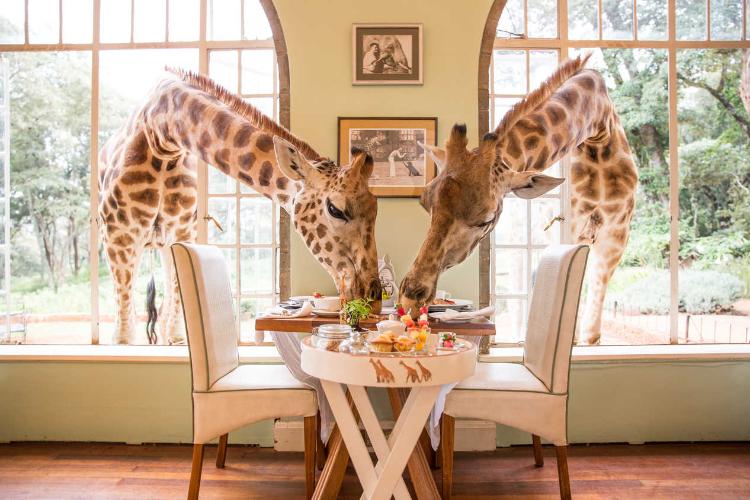
BEST IN KENYA AND HOLIDAYS IN ZANZIBAR Kenya, Tanzania
Do you want to gain new impressions and have a good rest, but don't have much time for the trip? Then this tour is for you. The program includes breakfast with giraffes, a safari with Kilimanjaro in the background, Masai tribes and relaxation on the best beach in Zanzibar.
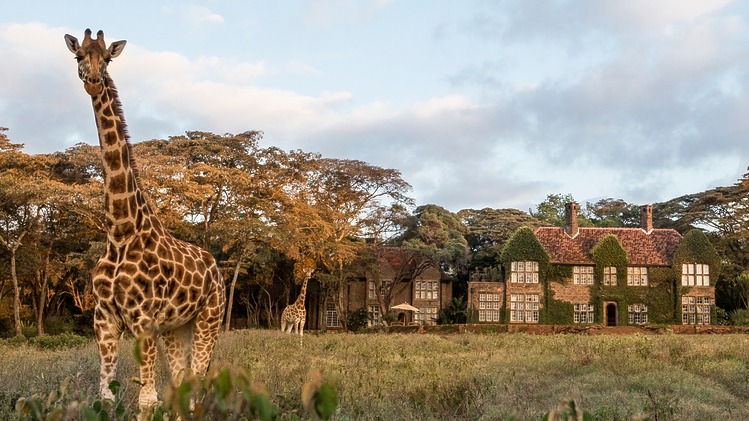
Giraffe Manor
- Kenya - Nairobi
For how long to go
Usually they stay at the hotel for 1-2 nights. This is enough time to enjoy the company of giraffes, a delightful hotel with an enchanting colonial atmosphere, and stroll through the green lawns of a private concession. There is also an art gallery in the hotel and you can take painting lessons. Within a radius of 15 kilometers from the hotel, it is interesting to go to Karen Blixen's estate and Sheldrick's elephant nursery. Then you can safely go further.
What to combine with
After talking with giraffes, you can go on a safari in the parks of Kenya and Tanzania, and / or go on vacation to Zanzibar. When the restrictions associated with the pandemic are removed, it will be even easier to combine tours to Kenya with Victoria Falls, Ethiopian tribes, Rwandan gorillas and so on. It is possible now, but you will have to constantly take PCR tests.
Breakfast with giraffes as a birthday present
Wake up on your birthday and hug the giraffe that stuck its head right in your room window to greet you! Truly - this is indescribable emotions and pure delight! Yes, the hotel is not cheap, but the experience is worth it! You can make yourself this gift, or give this happiness to loved ones. You can buy one night and get a gift certificate, or you can book the whole tour. We will take into account all your wishes and will do our best to make your dream come true.
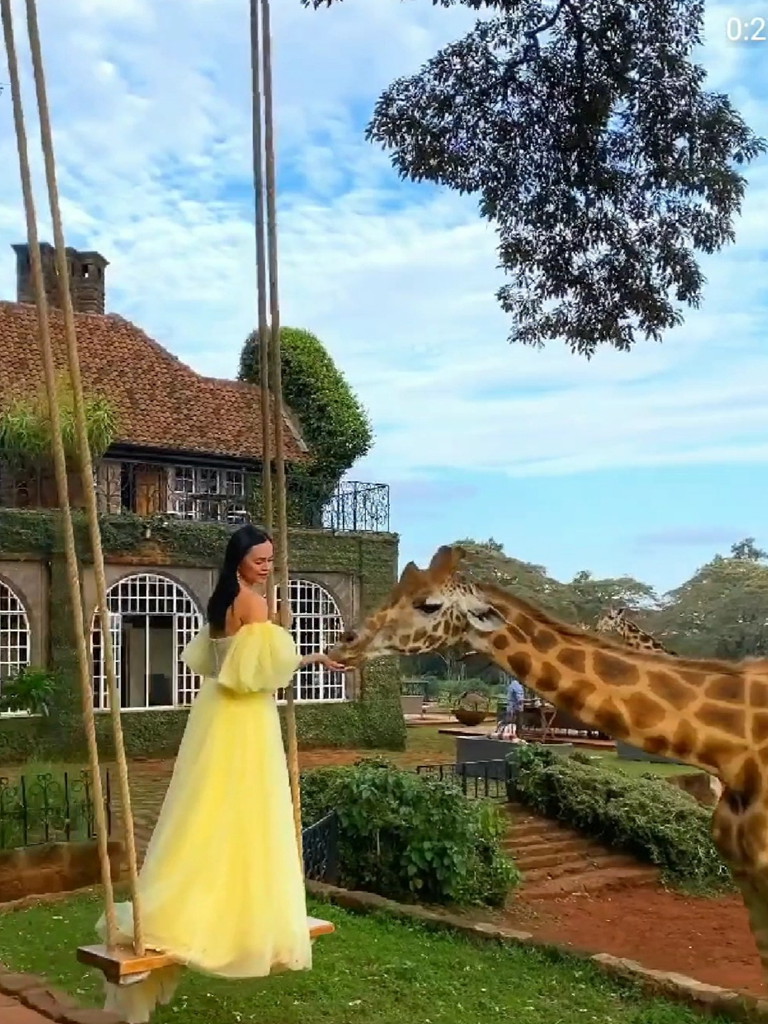
The Cult of Africa Club is a travel company with experience in Africa since 2003.
Africa tours for everyone from Morocco to Cape Town.
- Tanzania and Zanzibar Tours September 2020
- Victoria Falls February 2021
- Tours to Ethiopia April 2021
- Tours Catalog November 2021
- Tours to Namibia December 2021
- Group tours
- AUTHOR'S TOURS
Username Error message here!
Password Show Error message here!
Remember Me
- Work & Careers
- Life & Arts
How to spot it – on safari with the world’s first smart binoculars

- How to spot it – on safari with the world’s first smart binoculars on x (opens in a new window)
- How to spot it – on safari with the world’s first smart binoculars on facebook (opens in a new window)
- How to spot it – on safari with the world’s first smart binoculars on linkedin (opens in a new window)
- How to spot it – on safari with the world’s first smart binoculars on whatsapp (opens in a new window)
Fergus Scholes . Photography by Carl van der Linde
Roula Khalaf, Editor of the FT, selects her favourite stories in this weekly newsletter.
The outstretched arm of our tracker gestures towards some treetops a few hundred yards away: his ability to spot the seemingly invisible is astounding. Luke, our guide, cuts the engine of the Land Cruiser and turns around: “Can you see? Just through that clearing to the left.”
Following his direction through my binoculars, I pick out the majestic-looking bird: dark brown head with tufted crown, white breast and piercing yellow eyes. Luke fills me in: “Sometimes nicknamed the ‘leopard of the air’, it’s a martial eagle, with a wingspan of up to 2.5m, one of the world’s largest birds of prey, and the largest in Africa.” This apex predator remains on its perch for a precious few minutes, then suddenly takes flight and disappears into the distance.

I’ve come to andBeyond’s Phinda Mountain Lodge in eastern South Africa on a birdwatching safari. The lodge sits in an elevated position with views across Phinda Private Game Reserve ’s 73,800 acres; its seven ecosystems offer an unusually varied habitat, from lush greenery to open savannah. The foothills of the low‑lying Lebombo mountains stretch 500 miles north into Mozambique, and the azure waters of the Indian Ocean lie just 20 miles east.
Most guests are here for the big game, but an impressive 436 bird species also makes the reserve a popular birding destination, so andBeyond’s specialist itinerary allows me to indulge a lifelong hobby.

Much of our first morning is hijacked by my enthusiasm to identify every bird we see, which means we get no further than 200 yards from the lodge in the first hour. But in the afternoon, we head directly to the dry sand forest, which is home to unusual endemic species.
A bright colour flashes by before perching on a small branch
Surrounded by an elephant exclusion fence, we leave the vehicle and set out on foot – as strict protocol dictates, our guide leads from the front with a high-calibre rifle in hand. Orchids and lichen grow in profusion, and some of the Lebombo wattle trees are believed to date back over 1,000 years. The dense vegetation makes getting a good view of the birds more challenging, but we still spot plenty, including African green pigeons, the paradise flycatcher with its unmistakably long tail feathers, and the crested barbet. Then we’re treated to the endemic pink-throated twinspot, a distinctive waxbill with a bright head and black chest with white spots. Extant in just a handful of other locations nearby, this is a favourite for many visiting birders.

My bird knowledge – largely limited to the British Isles – is of little help here in South Africa, so my guide has been invaluable. However, I’ve also been given access to the world’s first AI-supported binoculars, released this year, which enable me to make positive IDs myself. The Swarovski Optik AX Visio (£3,820) combines high-end optics (10x32) with bird identification software. You get the desired bird in your sights, and at the press of a button a suggested species appears on the heads-up display. Behind the scenes, the binoculars are cross-checking the image and GPS coordinates against Merlin Bird ID’s extensive database of more than 8,000 bird species (Merlin’s app is divided up into groups, allowing you to download extra information on the species found in a given region; I installed the South Africa pack of 712 birds.)

Making our way in the vehicle once again, we come across zebra with red-billed oxpeckers picking ticks and parasites from their backs. A little further on, we glimpse a southern fiscal; a black-and-white shrike that also goes by the name of butcher bird due to its habit of impaling its prey on acacia thorns for later consumption. Then, as we pass a small water source, a bright colour flashes by before perching on a small branch; it’s a malachite kingfisher. Meanwhile, a three-banded plover moves busily along the water’s edge, foraging for insects. Luke then spots its nest, which is little more than a shallow depression on the beach containing two small grey mottled eggs.

Over the course of three days, the binoculars help me correctly identify 68 species of bird. Although there are a few, around 30, with which the technology struggled. Sometimes the bird is too far away, or it is obscured by twigs, or the image was blurred – but more often than not, with a good, clear view, the binoculars do an impressive job of identification. Moreover, because a photo is saved with each press of the button, I have a comprehensive photographic diary for later scrutiny.

On my last day, as the sun drops low on the horizon, we stop at a clearing next to the waters of the Mvubu dam, which makes a sublime setting for sundowners. A handful of blue-cheeked bee-eaters flutter above the still waters, a flock of white-faced whistling ducks complete their final flyby, and the nearby hippos quieten their grunting for the night. Biltong and drinks polished off, we hop back in the vehicle and make our way under a starry night sky. Sitting back, I reflect on my first birding safari experience – spotting more than 100 bird species, taking in the big five along the way and myriad other wildlife, it’s been as rewarding a trip as I could have hoped for.

Fergus Scholes travelled as a guest of andBeyond , on an abbreviated version of its nine-night Beyond Average Birding in South Africa experience, which costs from £9,200pp sharing. Includes internal flights, dedicated safari vehicle and specialist birding guide, accommodation, laundry, meals and drinks, andbeyond.com. Guests will be able to book a pair of Swarovski Optik AX Visio binoculars from July, POA
Promoted Content
Follow the topics in this article.
- Travel Add to myFT
- Technology Add to myFT
- Gadgets Add to myFT
- South Africa Add to myFT
- HTSI Add to myFT
International Edition

IMAGES
VIDEO
COMMENTS
The goal of Longneck Manor is to provide a fun personal experience while helping to save animals in the wild. We do this by combining the best elements of a good zoo with that of a good conservation organization. So you get to meet some real live conservation ambassadors (both four and two legged species) as well as contribute to a non-profit ...
For many travellers Samburu is the highlight of a Kenya safari. It's a wild and beautiful place, and wildlife is easy to spot in the parched landscape. There are large herds of elephant and plenty of buffalo, waterbuck, giraffe and zebra, and also dry-country rarities such as gerenuk, which reach tender shoots by standing on two legs.
Giraffe Viewing on Safari. Giraffe viewing depends on where you are in Africa - as there are 9 subspecies of giraffe. ... Selinda Camp is located in the breathtakingly unspoilt Selinda Reserve, home to some of Africa's largest herds of elephant and buffalo, as well as rare African wild dog. Read More. Lemala Mpingo Ridge.
The African elephant is perhaps the most enduring symbol of nature's grace and fragility. These gentle giants are Earth's largest land mammal and a common sight for those on safari in Africa.Nonetheless, these magnificent beasts are facing unprecedented threats to their existence, making both the imperative to understand more about them and the chance to encounter them in the wild more ...
Samburu is a wild and beautiful place, and wildlife is easy to spot in the parched landscape. There are large herds of elephant and plenty of buffalo, waterbuck, reticulated giraffe, and zebra, along with dry country rarities such as gerenuk. There's rarely much grass cover so lion, leopard and cheetah are also relatively easy to spot.
Addo Elephant Park offers a unique opportunity to witness over 600 elephants and a variety of other wildlife in their natural habitat. The safari includes a visit to Giraffe Walk, where visitors can have up-close encounters with giraffes and learn about their conservation.
Based on our extensive safari experience since 1998, here are our favourites places to see giraffes in Africa: 1. Samburu National Reserve, Kenya. While Kenya's flagship Masai Mara National Reserve will deliver reliable giraffe sightings year-round, it's the lesser-known Samburu that's our favourite pick.
Giraffes may consume about 75 pounds of vegetation a day. Credit: Duncan Kimuyu. As they roam around the African savanna in search for food, giraffes and elephants alter the diversity and richness ...
Giraffe social structure is as complex as elephants' - consisting of intricate communication, stable kinship groups and supportive mothering. safari experts, since 1991 ... //ukuri.travel/ - safari camps for responsible travellers; Our most popular safaris. Mashatu safari magic - Tuli Block More details.
Perhaps the ultimate icon of the African savanna, the giraffe is an unmistakable land mammal known for its long neck and spotted coat. Read on for a few interesting facts about this intriguing animal. Latin name: Giraffa camelopardalis. Group name: Tower. Size: 4.3 meters to 5.7 meters tall.
Mingle with baby elephants and observe rare species of giraffes in this fun and exciting animal tour to The Sheldrick Wildlife Trust and the Giraffe Center. Start your tour with pickup from your accommodation in Nairobi and head to the The Sheldrick Wildlife Trust which is only open from 11:00 AM to 12:00 PM. Meet baby and teenage elephants and ...
CAUGHT ON CAMERA this week: Elephants, giraffes, lions, and hyenas. Subscribe for more National Geographic Kids videos: http://bit.ly/SubscribeToNatGeoKids...
CAUGHT ON CAMERA this week: A baby elephant, giraffes, zebras, and female nyalas. Subscribe for more National Geographic Kids videos: http://bit.ly/Subscri...
This is an incredibly inspiring and moving experience and is highly recommended for anyone that has the time. SWT is the world's most successful orphan elephant rescue and rehabilitation programme and the life-saving conservation work they carry out is incredible. At the 11:00 am viewing, visitors can watch the babies enjoy their midday mud ...
The four authentically themed two-storey lodges each sleep up to five people. Come eye-to-eye with our charismatic tower of giraffes from the balcony on the first floor, where the open-plan living room, kitchenette and dining room are also situated. Here you will also find a suspended cosy nest to lounge in.
Drive-Thru Safari. Conservation. About Us. Contact. More. YOUR ADVENTURE STARTS HERE. Book a Visit. Drive Thru Tickets. Get Gift Card. Lets Chat. Meet Us. Book Cabin. Book Encounter. Book Adventure. By entering this park. You agree that all photographs and video taken during your visit will be for personal use only and not for commercial ...
Cams at the San Diego Zoo Safari Park and San Diego Zoo. ... Platypus Cam. VIEW CAM. SAFARI PARK Giraffe Cam. VIEW CAM. SAFARI PARK Tiger Cam. VIEW CAM. SAFARI PARK Burrowing Owl Cams ... SAN DIEGO ZOO Penguin Cam. VIEW CAM. SAN DIEGO ZOO Polar Cam. VIEW CAM. PRE-RECORDED Elephant Cam. VIEW CAM. PRE-RECORDED Panda Cam. VIEW CAM. PRE-RECORDED ...
Even the helicopter transfer flight to our next camp, Vumbura plains, was a safari experience, with huge herds of elephants and giraffe spotted meandering in the tributaries of the Okavango delta.
Kenya Tours And Safaris: A great National Park experience - See 436 traveler reviews, 61 candid photos, and great deals for Nairobi, Kenya, at Tripadvisor.
The Self Drive-Thru Safari pre-season/post-season option is available on select weekends only in April and November. from 10:00 a.m. to 3:00 p.m. Please note: Only the Safari Tour Fields are open for the Self Drive-Thru option. Zoo exhibits are open during our regular season May 1st through October .
Witness huge herds of migrating elephants at waterholes. Extraordinary wildlife, including lion, leopard, African painted dog, giraffe, roan, and kudu. Track game on foot and enjoy optional mountain biking as part of the adventure. Gorgeous safari camps in Hwange and Chobe, each with its own unique atmosphere.
Come with us on a journey through the wild as we seek out the snake, lion, cheetah, elephant, and giraffe. These iconic animals are some of the most fascinat...
Kenya Tours And Safaris: Great tour with Watson - See 436 traveler reviews, 61 candid photos, and great deals for Nairobi, Kenya, at Tripadvisor.
In Kenya, there is a hotel called the Giraffe Manore. We are here. Flight to Nairobi, then transfer from the airport to the hotel from 40 minutes to 1.5 hours, depending on traffic jams. After talking with giraffes, you can go on a safari in the parks of Kenya and Tanzania, and / or go on vacation to Zanzibar.
The Swarovski Optik AX Visio (£3,820) combines high-end optics (10x32) with bird identification software. You get the desired bird in your sights, and at the press of a button a suggested species ...